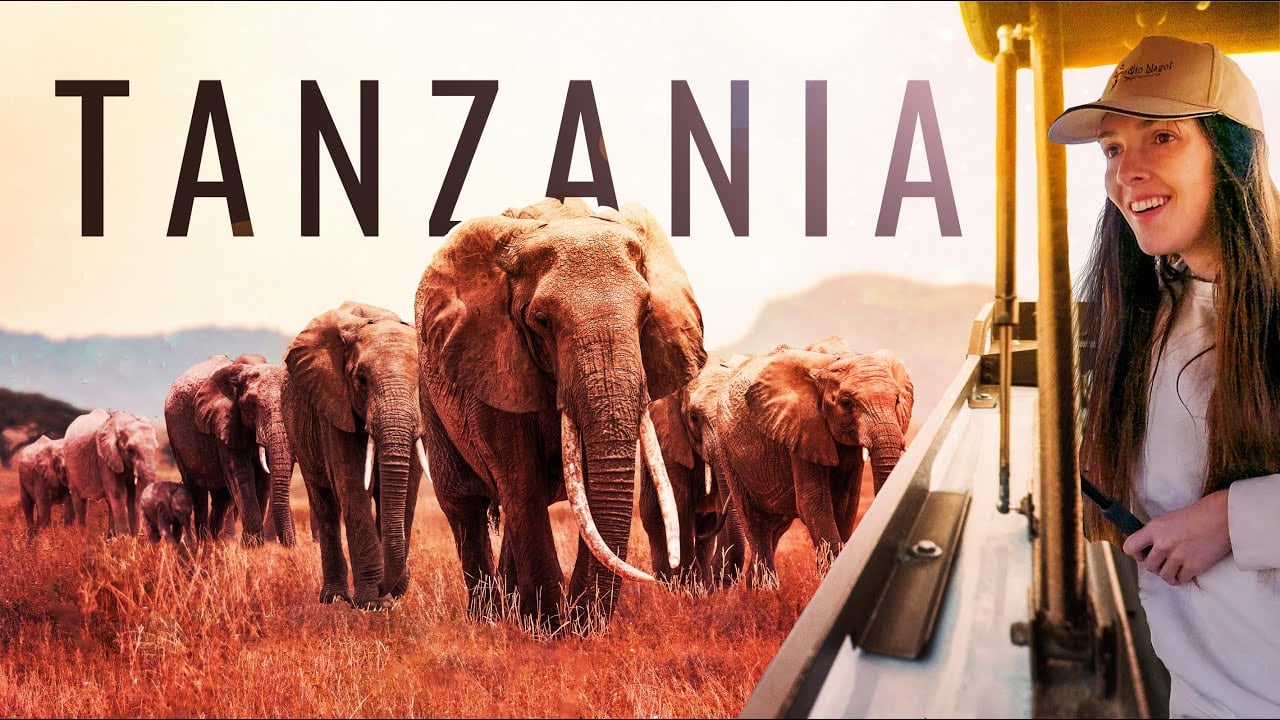Visiting Tarangire National Park is one of those trips you’ll never forget!
Being one of the top three parks in Tanzania, with some of the countries highest animal densities and enormous elephant herds, it’s an unforgettable safari destination.
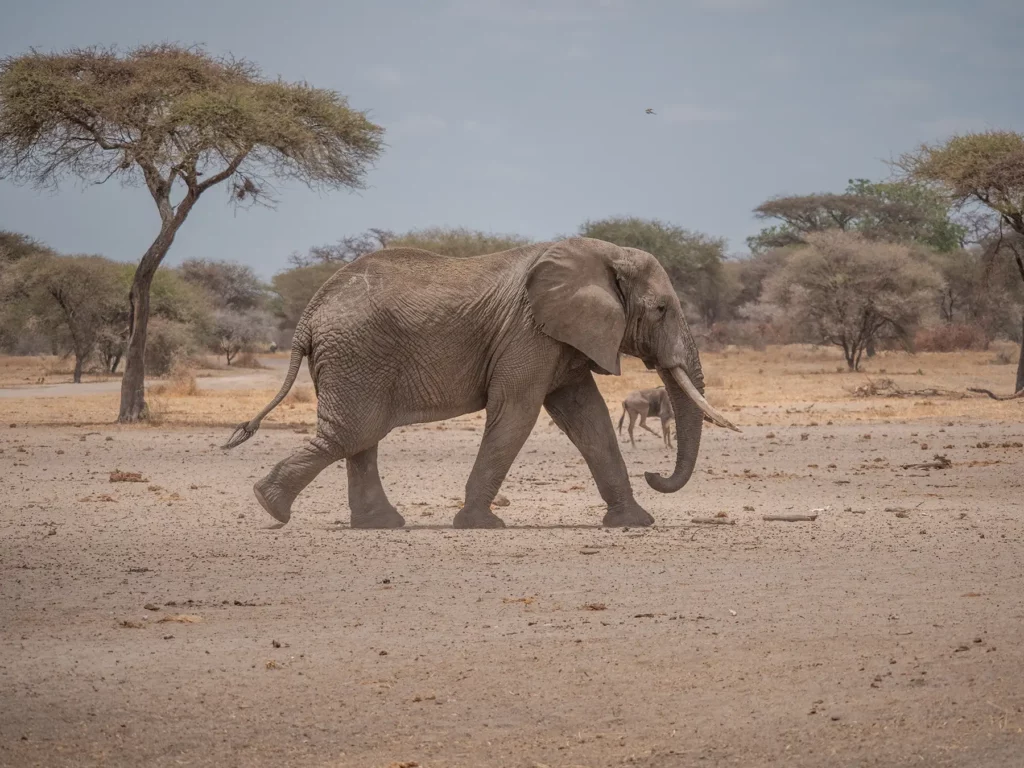
As well as wildlife, it’s also home to gorgeous landscapes of yellow grasses and towering baobab trees. And, of course, the Tarangire River which weaves its way through the park, beckoning wildlife to its shores.
If you’re planning your Tanzania safari itinerary, I highly recommend visiting Tarangire. It’s one of the country’s very best national parks and I had an incredible safari here myself.
Since it’s easily combined with the famous Serengeti and dramatic Ngorongoro Crater, adding Tarangire to your itinerary just makes sense!
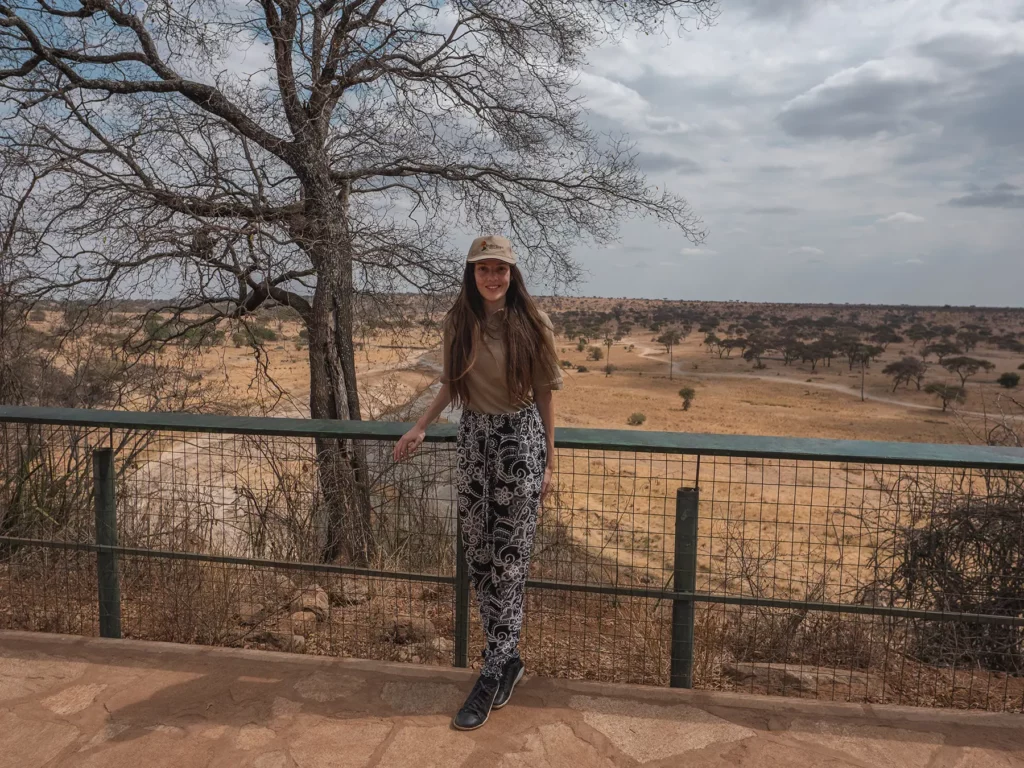
Pronounced Tair-an-geer-ee, the park is named after the river which swerves through it. The word may translate to ‘river of warthogs’ or ‘spotted water’ (a river that never dries), depending on who you ask.
In this guide to Tarangire National Park, I’ve detailed everything you need to know before you visit, so you can make the most of your trip.
Tarangire National Park Map
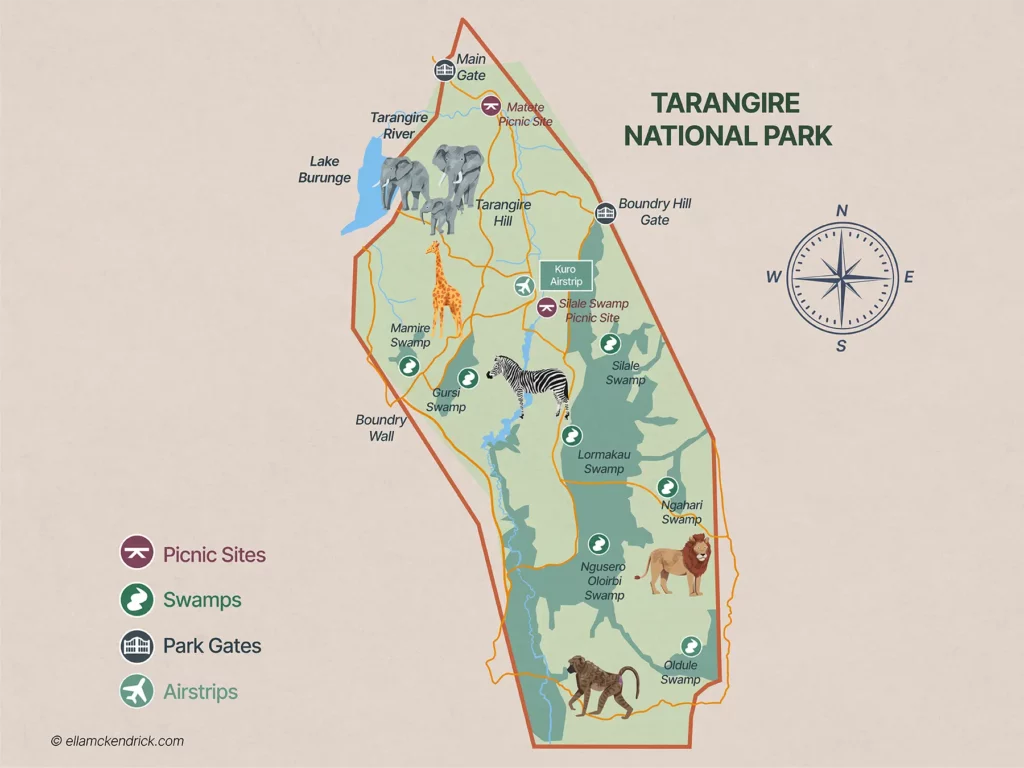
As you can see from the map, the Tarangire River cuts through the centre of the park with many of the large swaps located to the east of the river.
The main gate is in the north and many safaris stick to the northern area of the park. However, If you have 2 or more days then visiting the south provides a quieter and more untamed safari experience amongst the large swamps with some rare species to encounter and less safari vehicles.
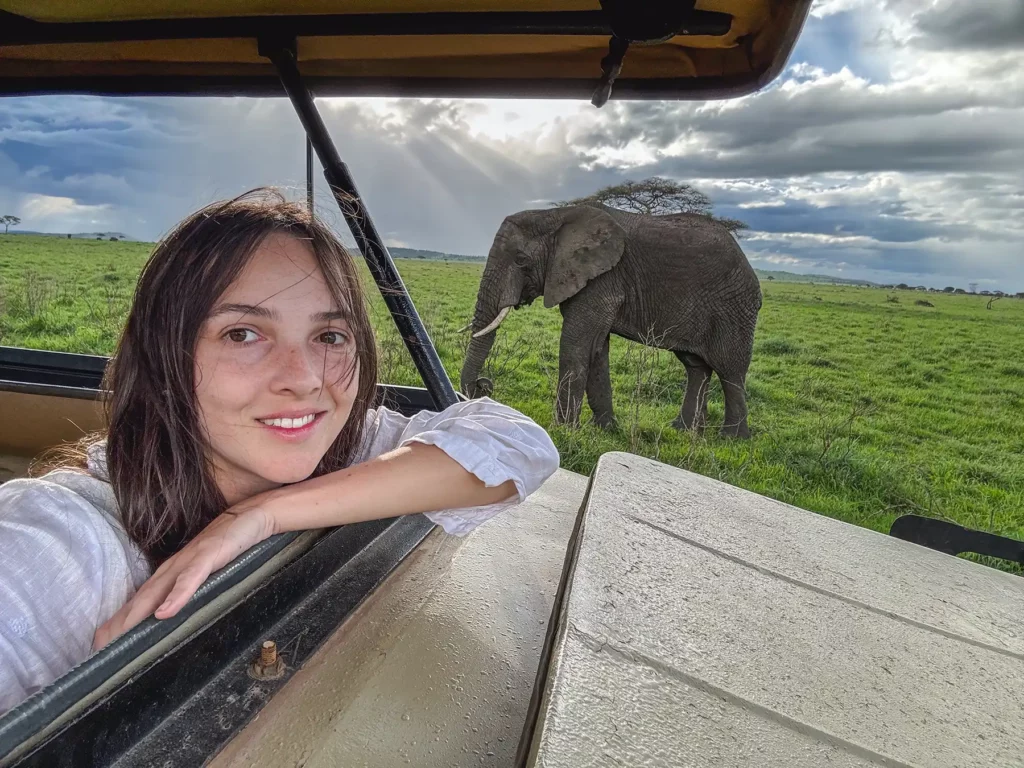
Embark on the Safari of Your Dreams
Save time and ensure an incredible safari experience by getting quotes from my recommended local safari companies
I’m here to make booking your perfect safari quick, easy and risk-free.
Join the rapidly growing tribe of over 1,000 travellers who’ve booked their dream safari using my insider tips and recommendations.

It takes under 60 seconds to fill out the form and in under 48 hours you will receive multiple, no-obligation proposals from my favourite local tour operators with glowing online reviews.
Get your free no-obligation safari quotes and my top safari tips and recommendations
In This Guide
- About Tarangire National Park
- Wildlife in Tarangire National Park
- Weather & Climate
- Best Time to Visit
- How Many Days
- Tarangire National Park Safari Areas
- Safety
- Things to do
- How to Book your Tarangire Safari
- How Much Does a Tarangire Safari Cost?
- Is a Tarangire Safari Worth it?
- Accommodation – Where to Stay
- Getting to Tarangire National Park
- Tarangire & Zanzibar for Safari and Beach
- How Does the Tarangire Compare?
- Best Arusha National Park Safari Itineraries
- 5 Facts About Arusha National Park
- Arusha National Park Safari Videos
- Read More Tanzania Guides
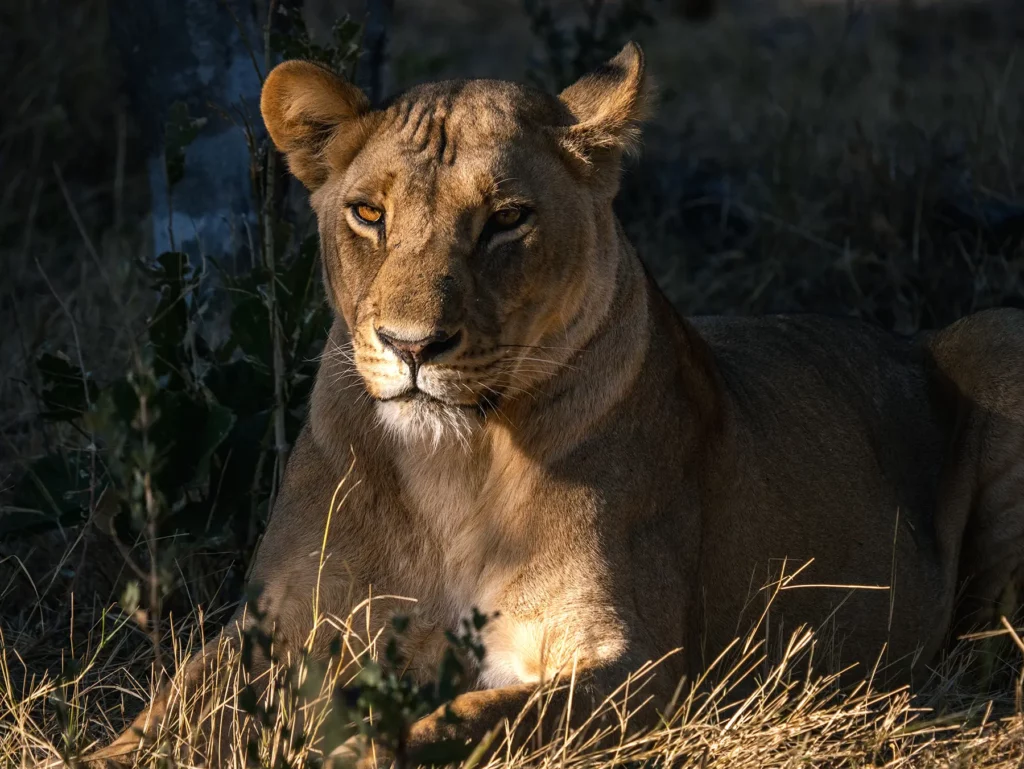
About Tarangire National Park
Tarangire National Park is the is the sixth largest park in Tanzania and home to country’s largest elephant herds.
It forms part of the country’s Northern Safari Circuit, which consists of various national parks and nature reserves including the world-famous Serengeti National Park and Ngorongoro Crater, alongside Lake Manyara National Park and Arusha National Park.
The close proximity of these parks mean it’s extremely easy to visit them all as part of a 2-week or 7-10 Day Tanzania safari itinerary.
For shorter trips, Tarangire can be included in a 3-day or 5-day tanzania safari itinerary.
You can view a video of my experience in Tarangire National Park below.
In What Country is Tarangire National Park?
Tarangire National Park is in Northern Tanzania, just south of Lake Manyara and the city of Arusha. It is named after the Tarangire River which runs through it.
Below is a map showing Tarangire’s location in Northern Tanzania, just above the elephant.
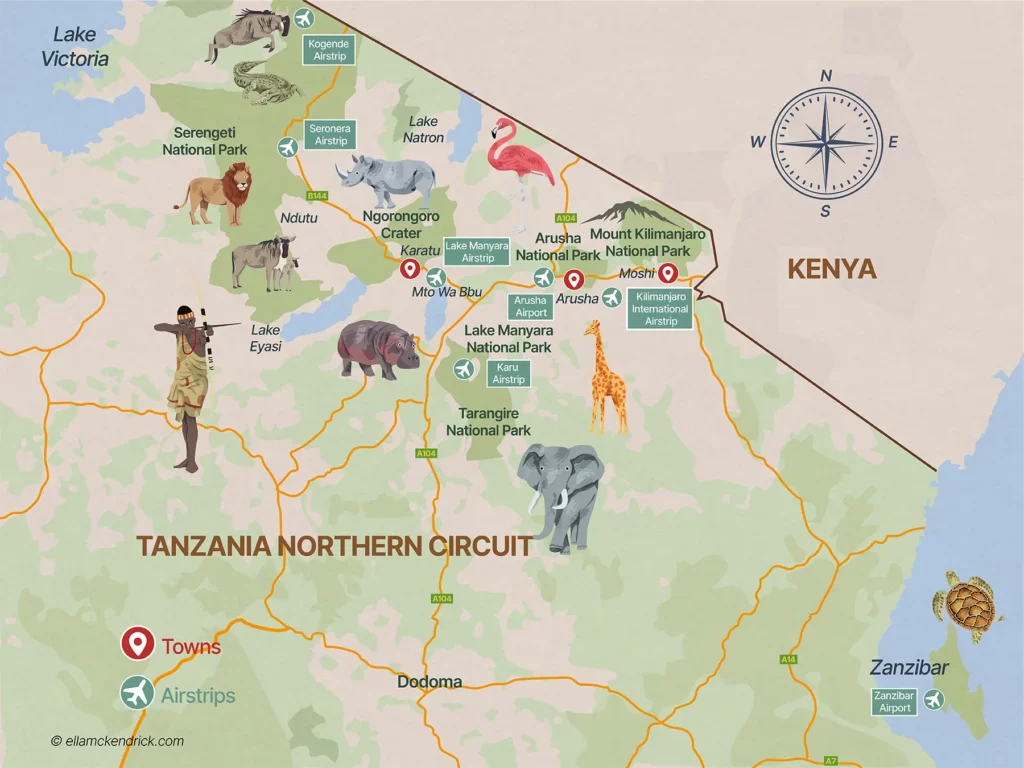
How Big is Tarangire National Park?
At 1,770 square miles (4,583 km²), Tarangire National Park is the sixth largest park in Tanzania. It’s far bigger than the neighbouring Lake Manyara National Park, which is just 202 square miles (523 km²).
On the other end of the scale, the famous Serengeti (also in Northern Tanzania) is enormous and almost three times the size of Tarangire, covering 5,700 square miles (14,763 km²). Tarangire is only about half the size of the Ngorongoro Conservation Area, which covers around 3,200 square miles (8,288 km²).
The chart below show show Tarangire compares with other nature reserves in Tanzania by size.
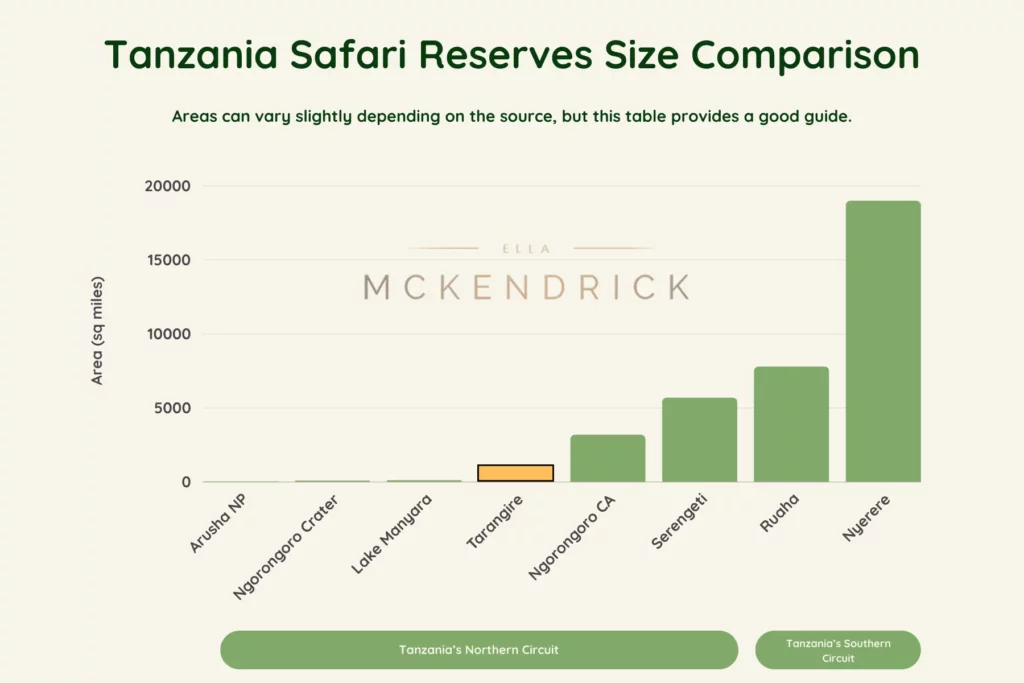
The chart below show show Tarangire compares with other nature reserves in Africa by size.
Compared to Africa’s Top safari parks and reserves Tarangire is on the smaller end but still bigger than Kenya’s Masai Mara National Reserve (excluding the private conservancies).
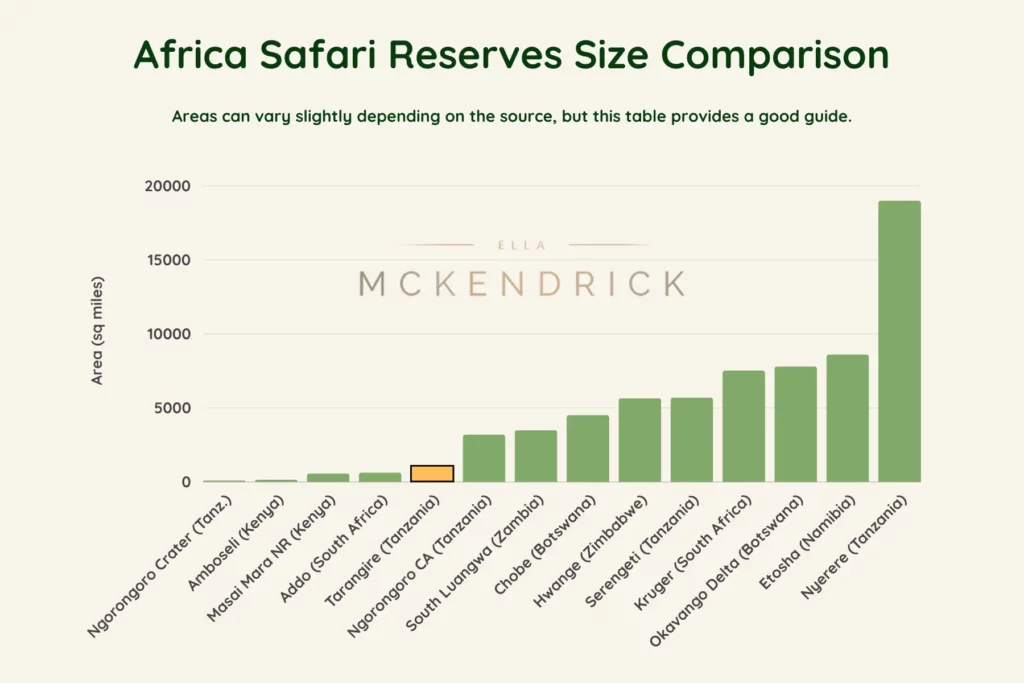
What’s So Special About Tarangire?
Tarangire National Park has of Tanzania’s one of highest animal densities, especially in the dry season, including thousands of elephants, making it an excellent place for a first-time safari experience.
You just can’t beat the incredible scenes of young and old elephants playing and washing in the park’s water holes, surrounded by other wildlife quenching their thirst.
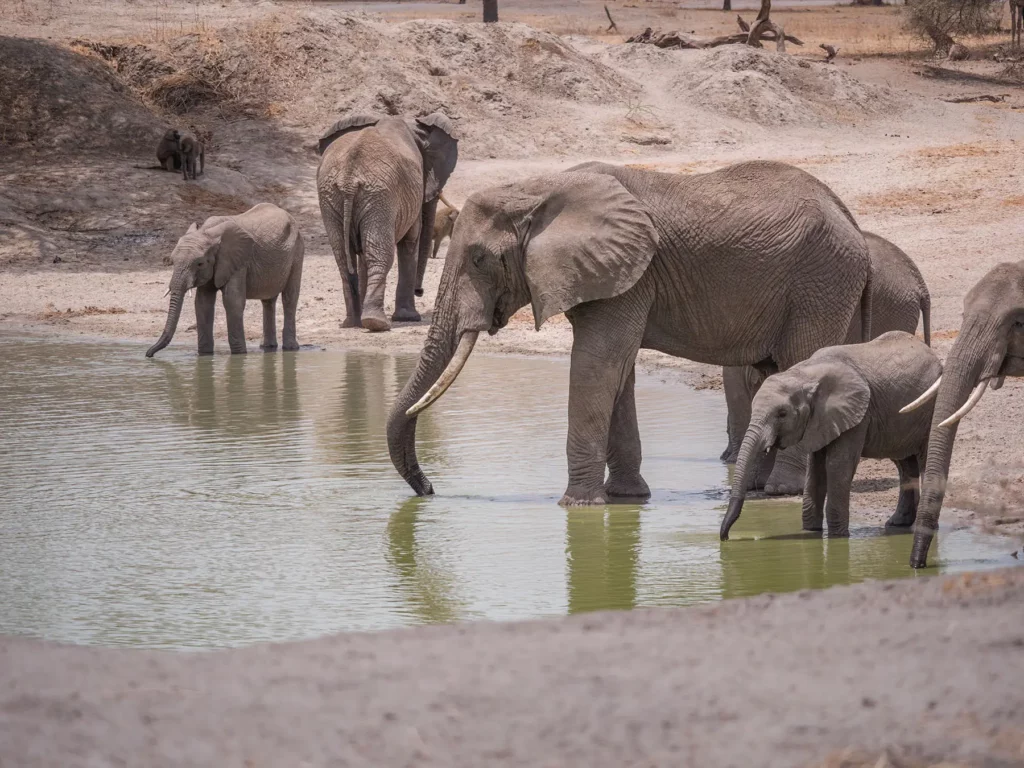
The park is also known for its ancient baobab trees, some of which have been around for 2,000 years, guarding over the savannah through centuries of change.
Tarangire is also accessible from Arusha, making it a great first stop on your Tanzania safari. Together with the Serengeti and Ngorongoro, the three destinations make up Tanzania’s Northern Safari Circuit, and many tourists choose a tour that allows them to visit all three. In my opinion, this is a fantastic way to get a glimpse of what makes Tanzania so special.
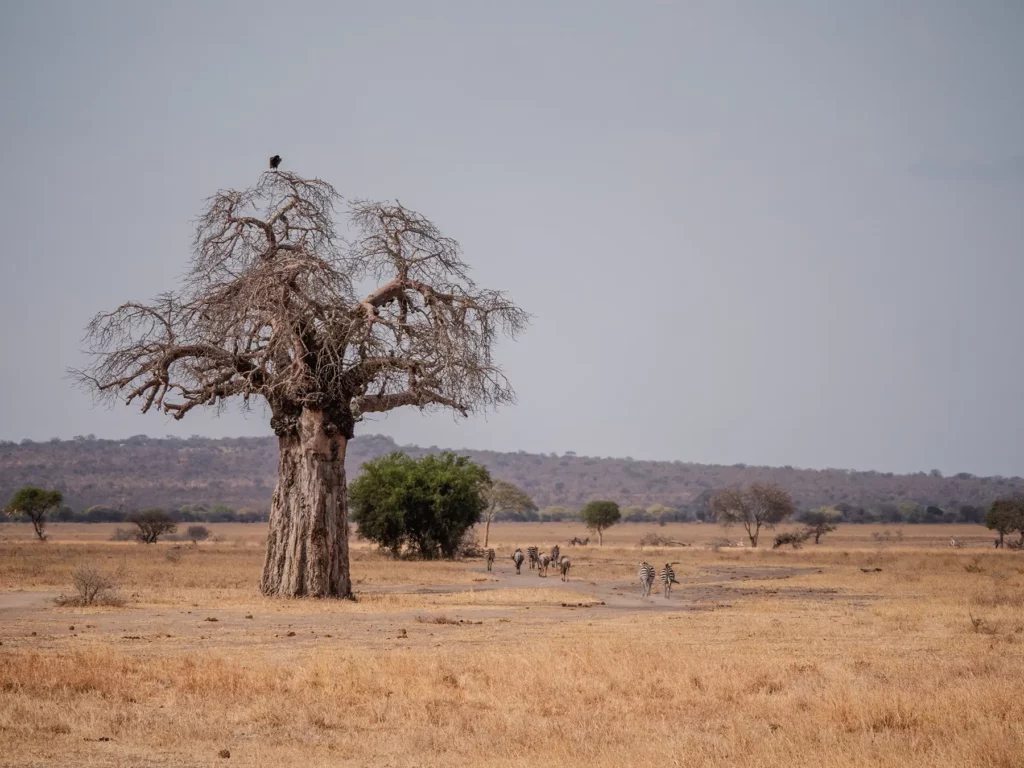
Tarangire’s Famous Elephant Herds
Tarangire National Park is famed for its large elephant herds. These iconic giants are a key reason people love to come on safari here.
Your chances of seeing elephants are high, which is no surprise considering that Tarangire has the largest elephant population in northern Tanzania. While on safari in Tarangire, you may encounter around a hundred elephants in a single sighting!
My first elephant sighting here was impressive. An entire herd, including a very small baby, walked in front of us as they headed to the water hole. Watching them drink as the baby rolled around joyfully in the water was touching. Later, I also saw a breeding herd cross paths with some bull elephants, and they all began feeding together. Truly magical!
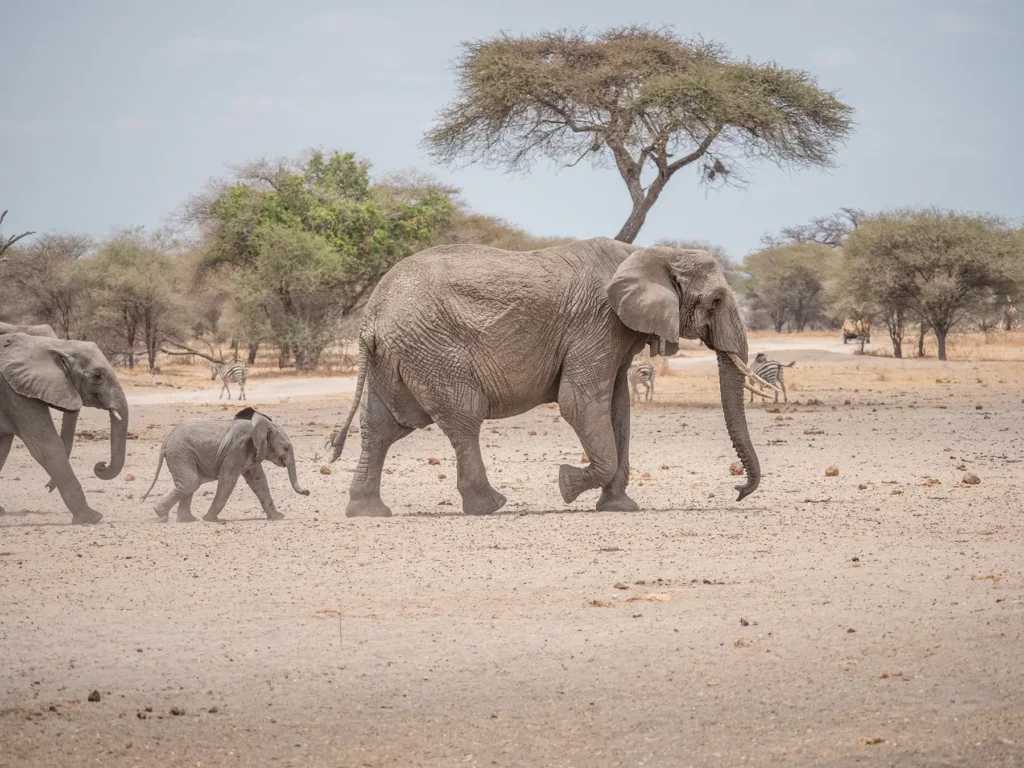
The best time to see Tarangire’s elephants is during the dry season, which lasts from June to October. During this time, they are easy to spot along the banks of the Tarangire River, the park’s primary water source.
While the elephant population here is stable, the animals face constant threats from several angles, including human activity and poaching.
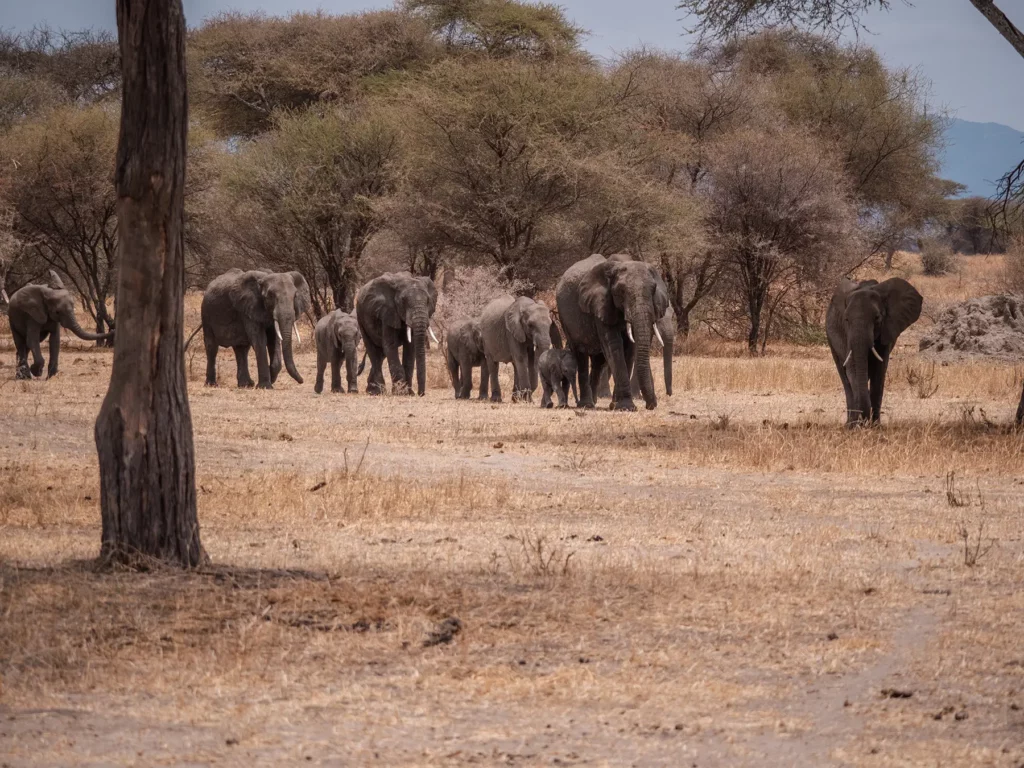
Elephant migration corridors in Tarangire and the surrounding area have been disrupted due to local agricultural activity, with five of the key routes already lost. The animals rely on these ancient corridors as they link the park to mineral-rich grazing land and water outside the boundary.
In order to combat these threats, the Tarangire Elephant Project has been tagging and identifying elephants since 1993. By monitoring their movements, behaviour, and genetics, their research helps to protect both natural habitats and grazing areas, so wildlife and local communities can coexist harmoniously. Anti-poaching patrols have also been established to combat the threat of illegal activities.
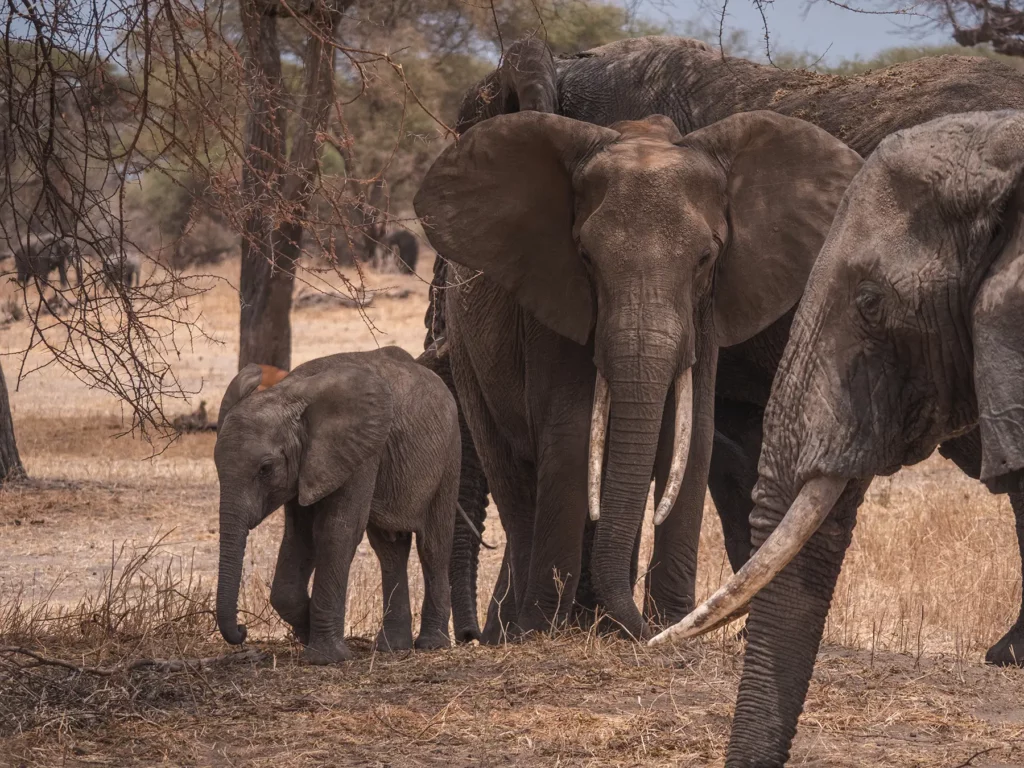
How Many Elephants are in Tarangire?
There are over 3,000 elephants in Tarangire National Park, with some herds having up to 200 individuals. While sightings are never guaranteed, this is definitely the best place in Tanzania to see elephants and one of the best in Africa along with Kenya’s Amboseli National Park.
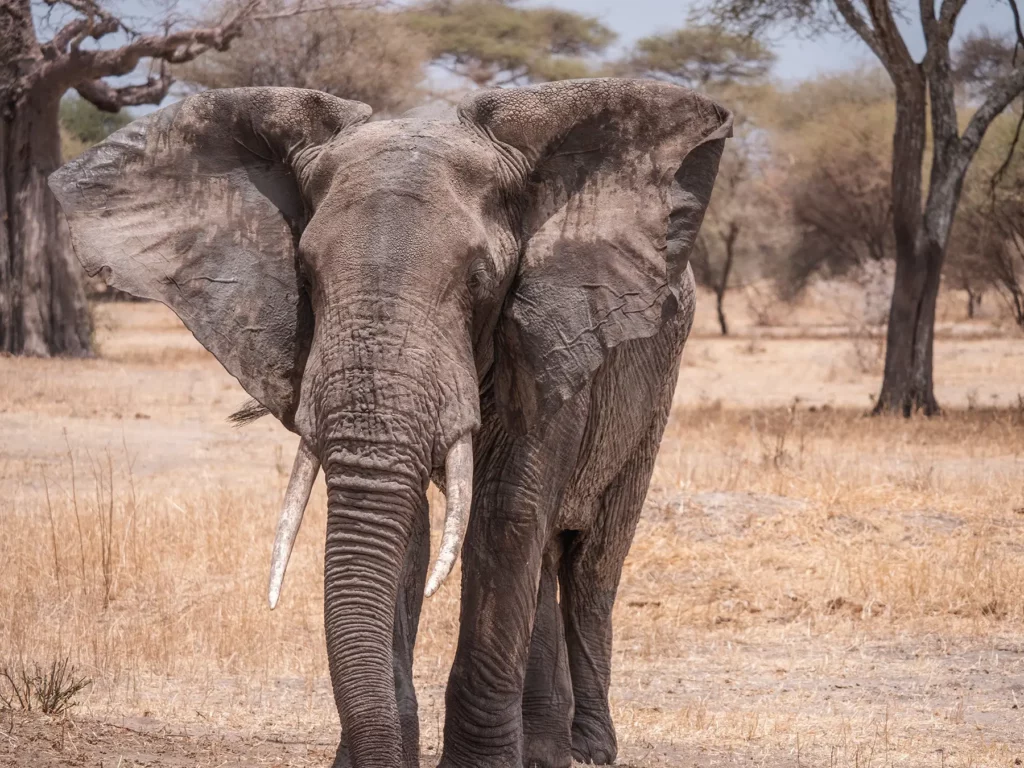
The Migration in Tarangire
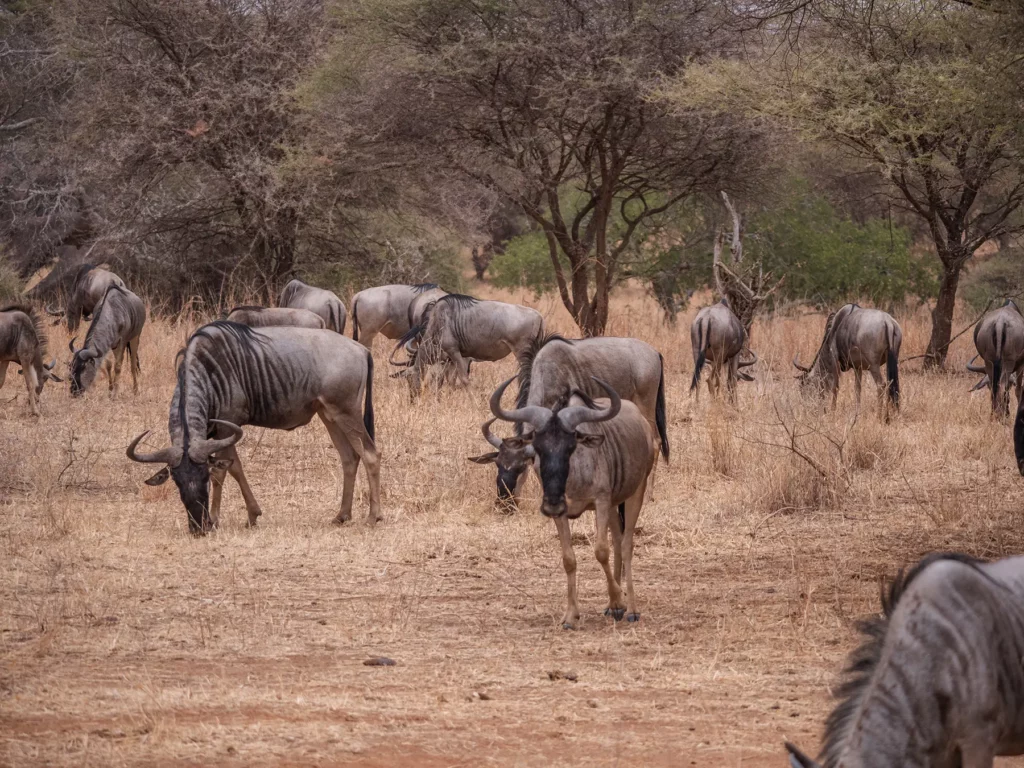
The Tarangire River is one of the primary water sources in northern Tanzania, so the park attracts plenty of migratory movement, especially in the dry season when water is still available here. Although the herds here don’t rival those of the Great Wildebeest Migration in Tanzania’s Serengeti and Kenya’s Masai Mara, they’re still pretty impressive.
If you want to witness Tarangire’s migration, visit Tanzania in August, September, or October at the height of the dry season. During this time, thousands of wildebeests, antelopes, zebras, and elephants come from far and wide and gather around Tarangire River’s few remaining watering holes.
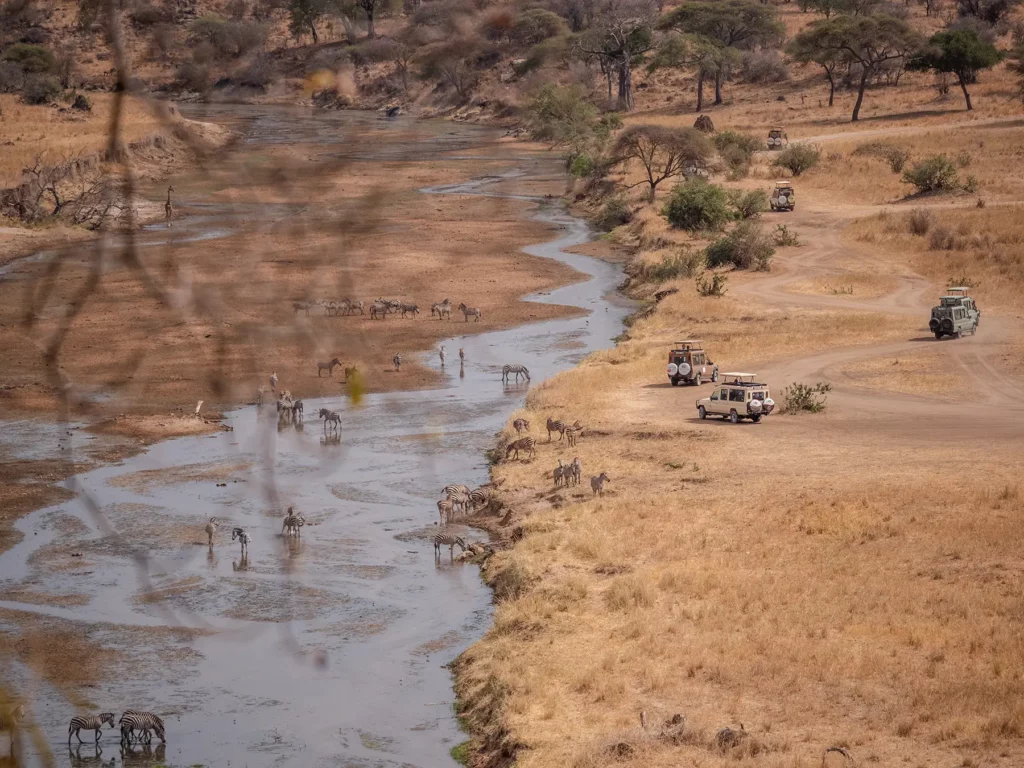
Tarangire’s Giant 2,000 Year Old Baobab Trees
Another highlight of a Tarangire safari is the abundance of giant baobab trees, some of which are believed to be up to 2,000 years old. You can’t miss these brilliant Boabobs – they grow to 30 metres and often have trunks that are 11 metres wide.
You’ll see the baobabs frequently during your game drives around the park – there are hundreds dotted around the plains. Don’t forget to look up to see if any leopards are hiding in the thick branches! Tarangire is a pretty good place to catch a glimpse of these elusive big cats.
Baobab trees are known as the ‘trees of life’ because they store moisture, which helps sustain local wildlife. Elephants, smaller species like mongooses, and nesting birds particularly enjoy the trees.
The trees flower once a year, on a single night, between October and December. You have to be very lucky to see them, but if you get your timing right, you’ll witness the white blooms attracting insects and bats.
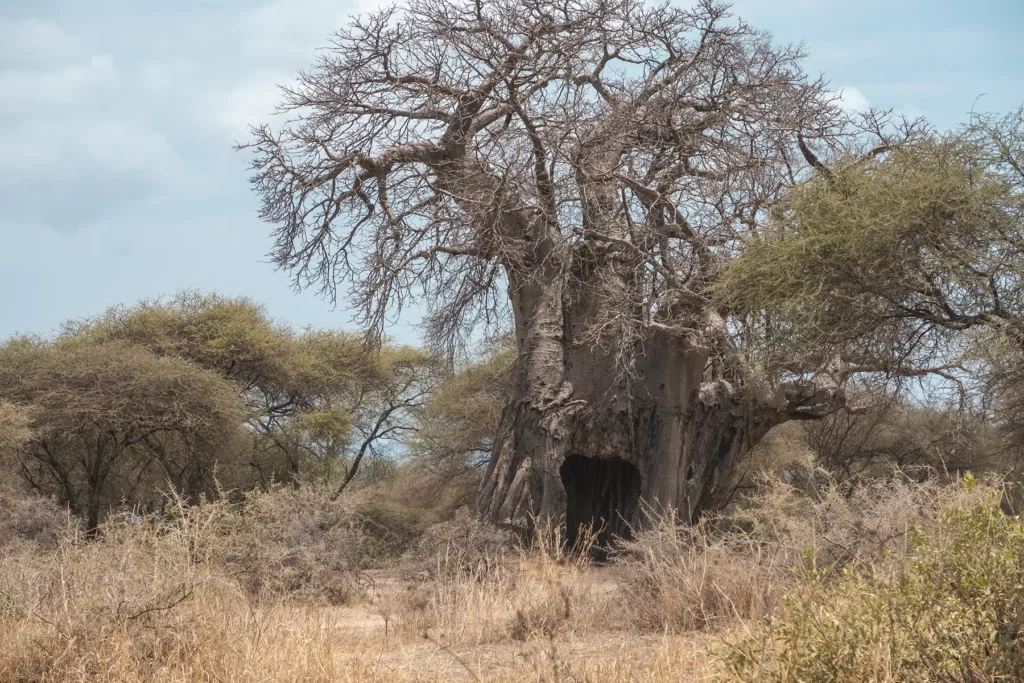
History of Tarangire National Park
Named after the river which runs through it, Tarangire is one of the oldest national parks in Tanzania. It sits on the eastern side of the Great Rift Valley, which formed millions of years ago. Yet Tarangire hasn’t always been a national park.
Maasai pastoralists have lived in the region since the 16th century, using the land for grazing and hunting. Then, during British colonial rule during the 19th and 20th centuries, the Maasai were displaced from their lands to make way for agricultural activity by European farmers.
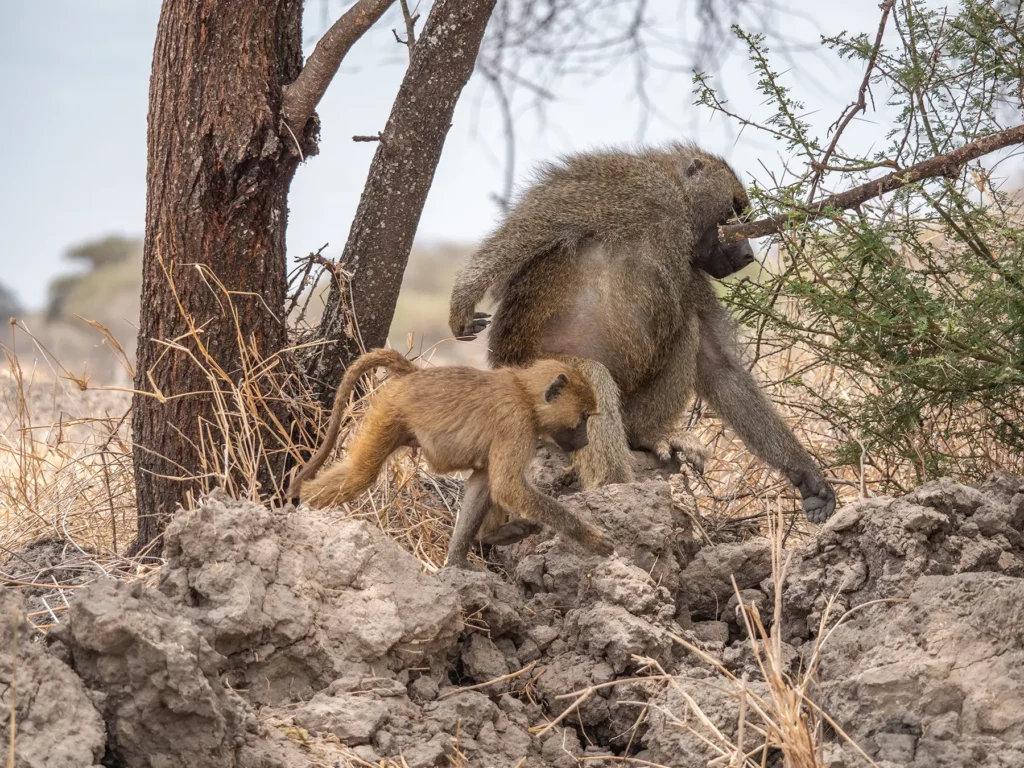
In 1957, the colonial government designated Tarangire as a game reserve, to help conserve the region’s wildlife and prevent hunting activities. It was then upgraded to national park status in 1970 in recognition of Tarangire’s abundant wildlife, natural resources, and unique habitats.
Today, Tarangire is managed by the Tanzania National Parks Authority, who regulate tourism activities and oversees wildlife conservation in the area. The park has been a front-runner in Tanzania’s conservation efforts and has played a vital role in developing sustainable tourism in the country.
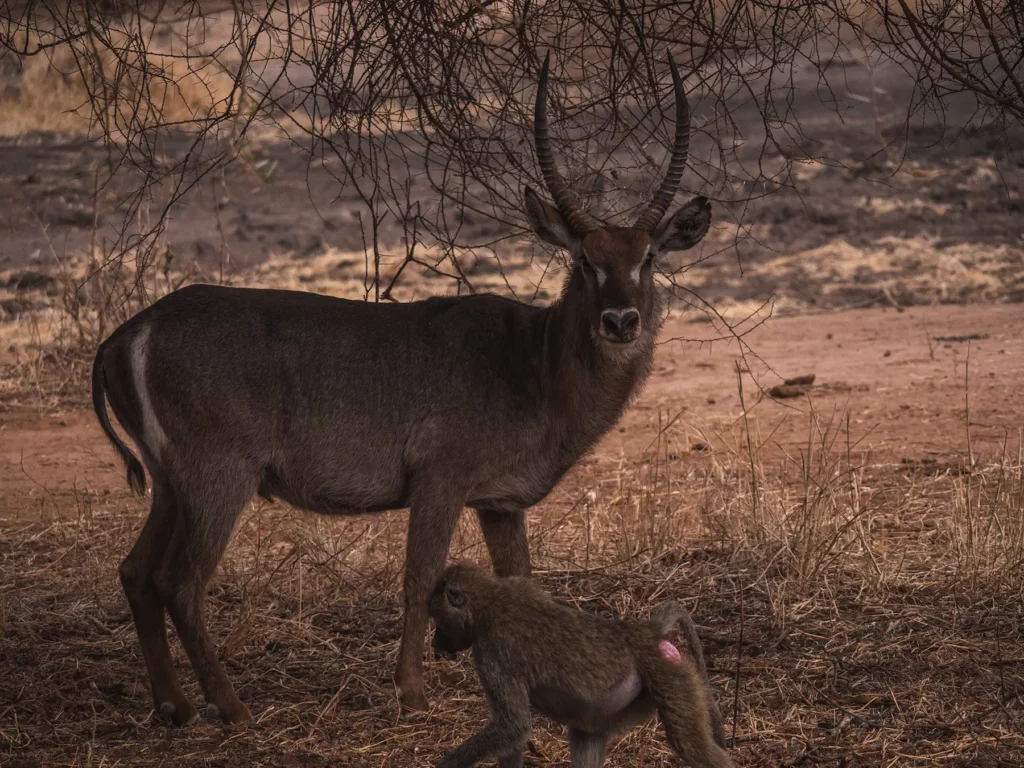
Animals in Tarangire National Park
Thanks to the wide variety of habitats in Tarangire National Park, wildlife species here are amongst the most diverse in Tanzania. The woodlands, swamps, and grassland savannahs provide superb environments for plentiful plains game such as giraffe, zebra and an abundance of antelope species, and predators such as lions, leopards and hyenas.
Of all the animals, elephants are the easiest to spot, with 3,000 of them here in the park.
Tarangire National Park is believed to have one of the highest wildlife concentrations in Tanzania, after the Serengeti, during the dry season, when animals cluster around the Tarangire River. Species like zebra, wildebeest, eland, giraffe, impala and warthogs are some of the easiest to spot.
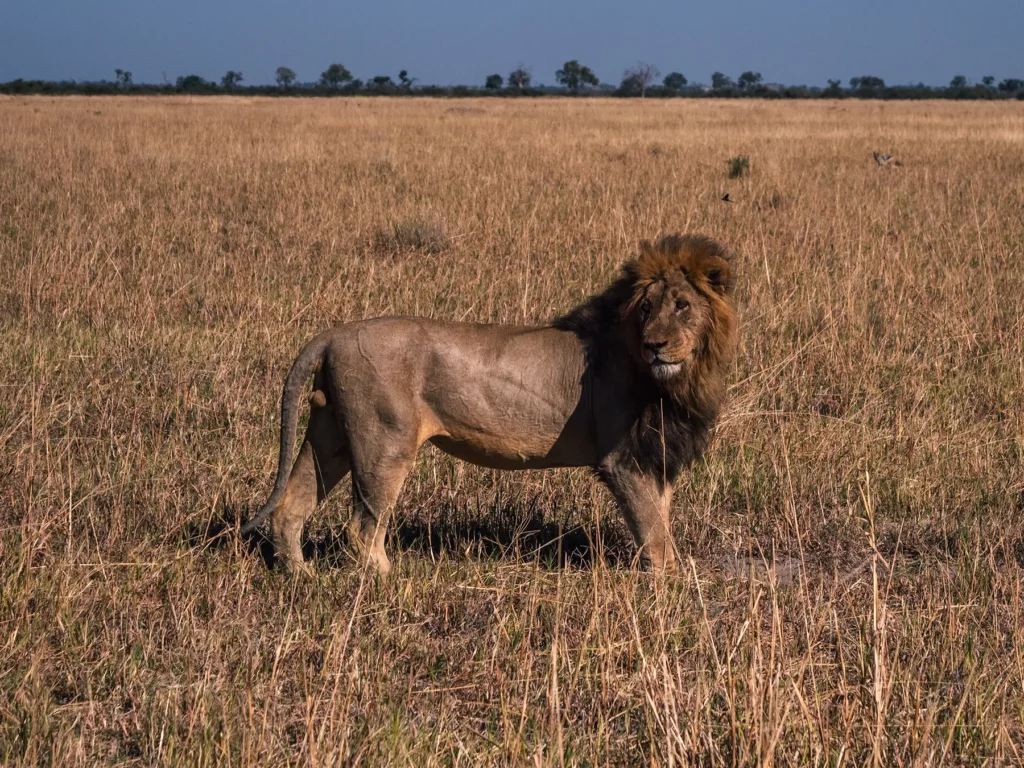
However, due to its enclosed ecosystem and resident wildlife populations, Ngorongoro Crater often rivals or exceeds Tarangire in terms of consistent animal density year-round.
When it comes to ungulates (hooved animals), Tarangire boasts 10,000 wildebeests as well as large numbers of zebras, impalas, gazelles, antelopes, buffalos, giraffes, and tiny dik-diks.
Look out for the less common hartebeests, kudus, elands, fringe-eared oryxes, and gerenuks.
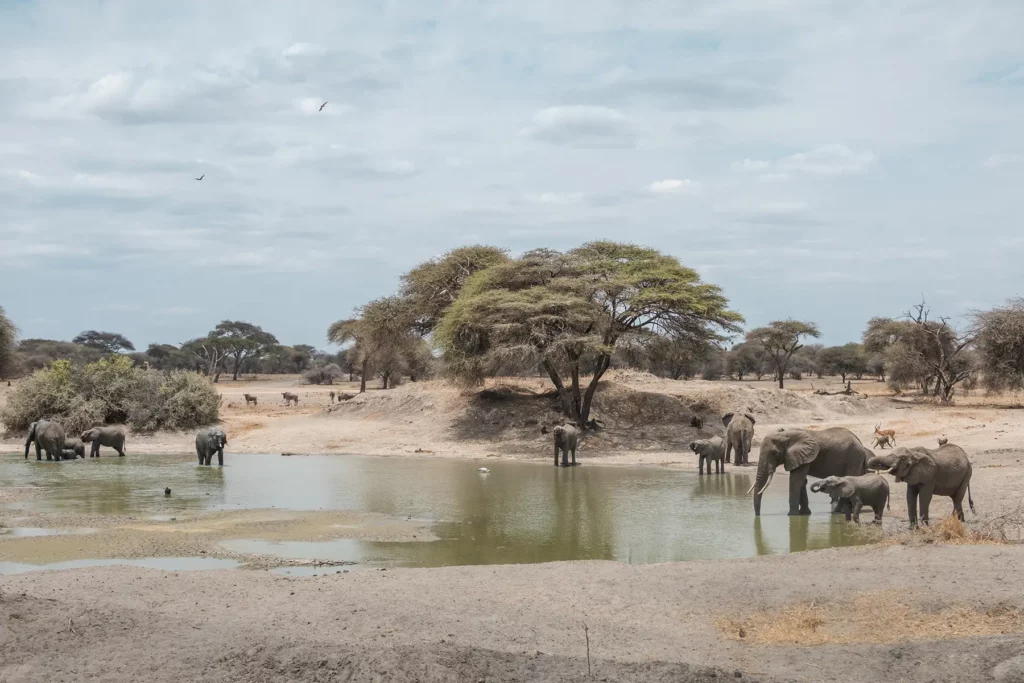
As for predators, you’re likely to see some of the 250 lions that live here, with a density of around 7.5 lions per 100 km². I had an incredible sighting of lions sleeping across the river.
Spotted hyenas are another predator you’ll likely encounter on your game drive. Although their exact numbers in Tarangire are unknown, they are abundant in the park. Meanwhile, the leopards and cheetahs are a bit more elusive.
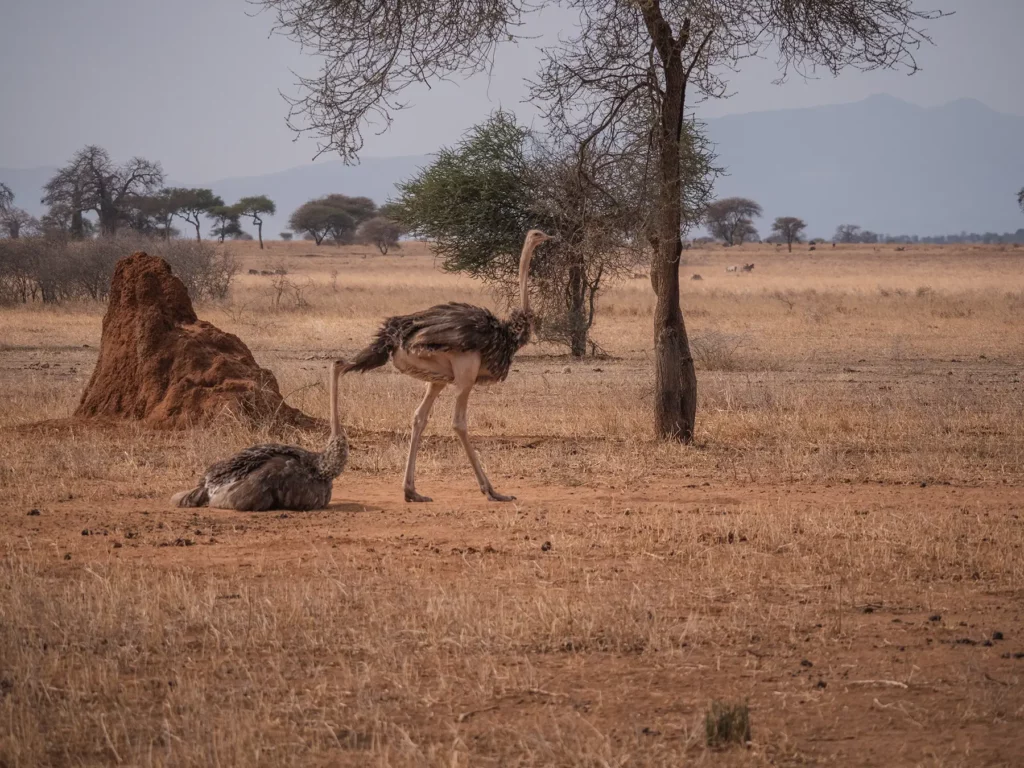
Whilst there have been sightings of African wild dogs, these are very rare, and sightings are unpredictable.
You’ll also find plenty of primates in Tarangire, including large troops of olive baboons, which are frequently seen along the game trails. Vervet monkeys often gather around the picnic areas, hoping for a free lunch, so don’t leave your sandwiches unattended!
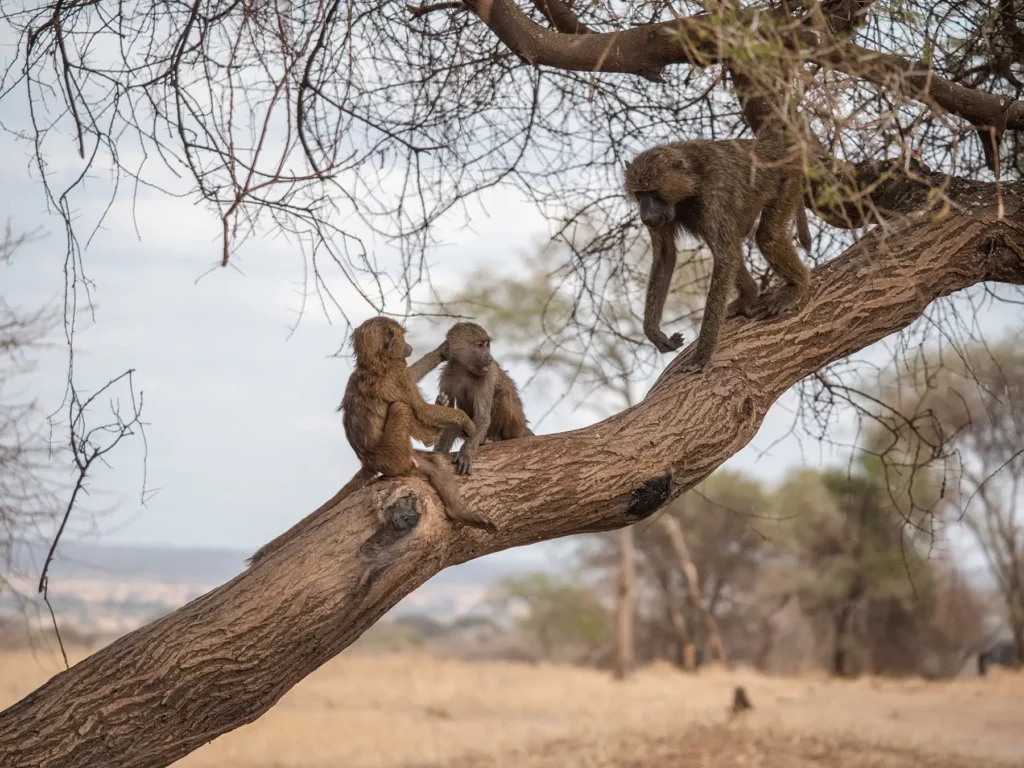
What Is The Main Animal Of Tarangire?
Elephants are the most sought-after species when it comes to safari sightings in Tarangire. They live here in huge numbers, and seeing them trundling across the grasslands, sometimes in their hundreds, is something you’ll never forget. (I certainly won’t!)
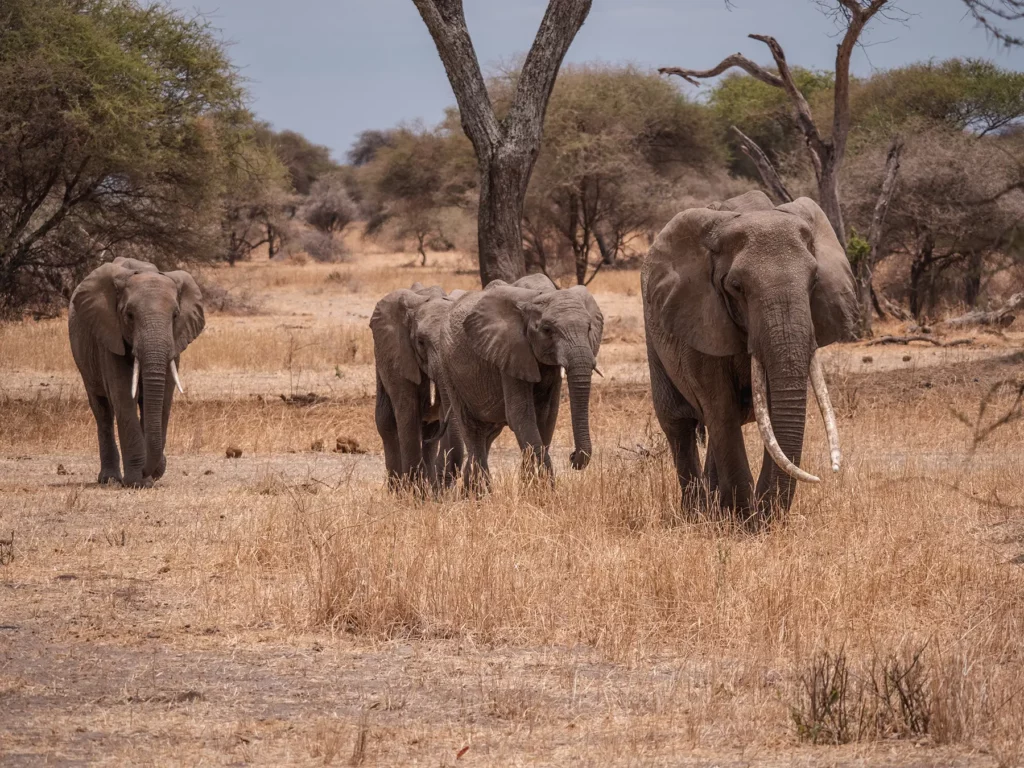
What Are The Rarest Animals In Tarangire?
Tarangire National Park is home to several rare and endangered species so keep your eyes peeled on your game drive.
This is one of the top places in Tanzania to encounter the fringed-eared oryx which is a subspecies of the Beisa oryx and also the greater kudu, one of the largest antelope species, with males having spectacular spiralled horns that can grow up to 1.8 meters (6 feet) long.
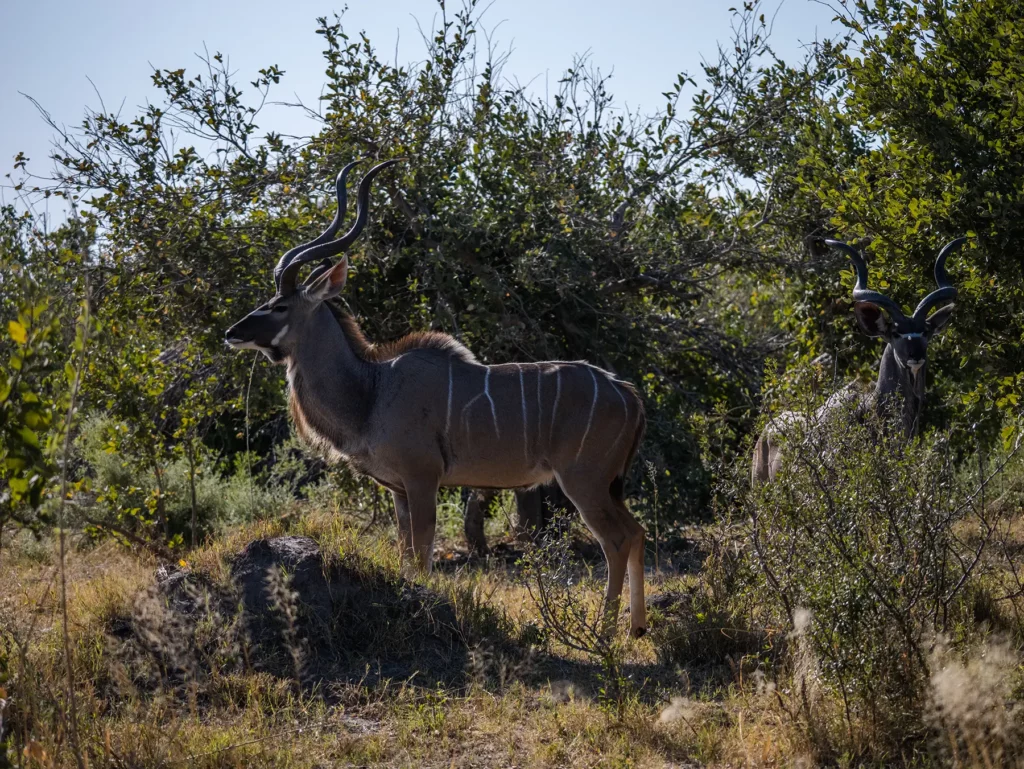
See if you can spot the gerenuk. This unusual gazelle is known for standing on its hind legs to feed on the leaves of low tree branches.
There have been infrequent sightings of African wild dogs in Tarangirie, who span huge distances across Tanzania. The population of African wild dogs in northern Tanzania is small. However, they thrive in Southern Tanzania in the vast parks such as Nyerere National Park and Ruaha National Park.
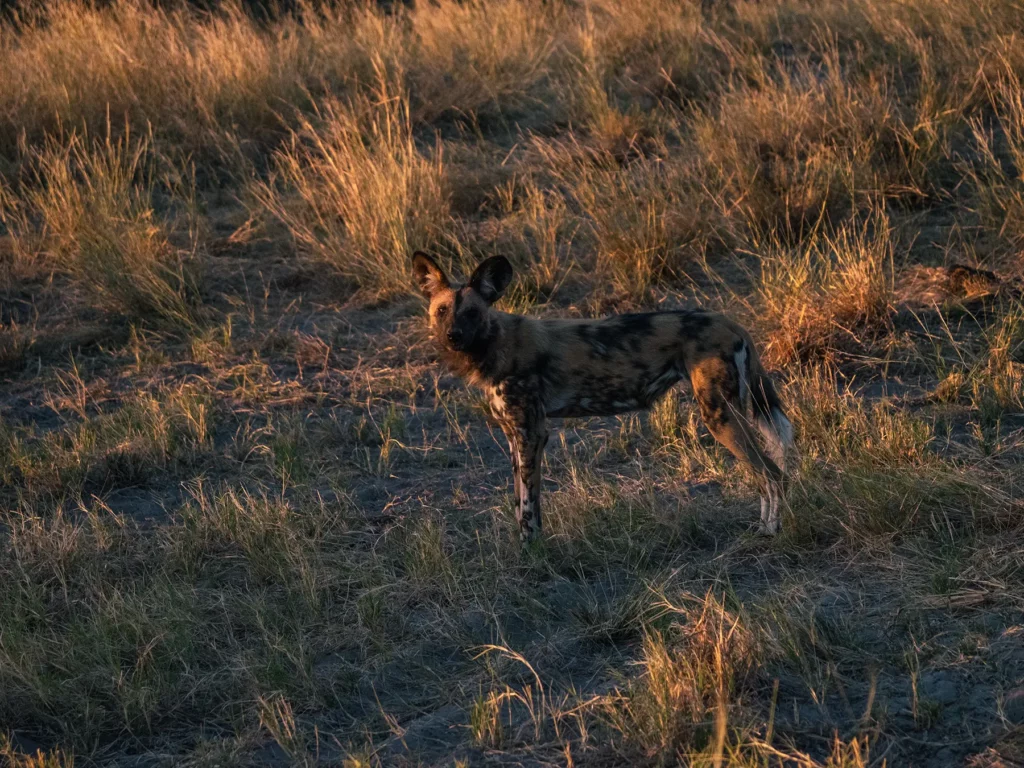
Can I See the Big Five in Tarangire?
You can see four of the Big Five in Tarangire National Park. Lions, elephants, leopards, and buffaloes are all present, but there aren’t any rhinos here.
Lions, elephants and buffaloes are fairly abundant whereas Leopards can be more challenging to spot.
One of the best places to see rhinos is the nearby Ngorongoro Crater, which is usually combined with Tarangire on your Tanzania safari itinerary. Ngorongoro Crater has a small population of endangered black rhinos, which are best seen at sunrise before they split up to go foraging. There is also the possibility to see black rhinos in Serengeti National Park too.
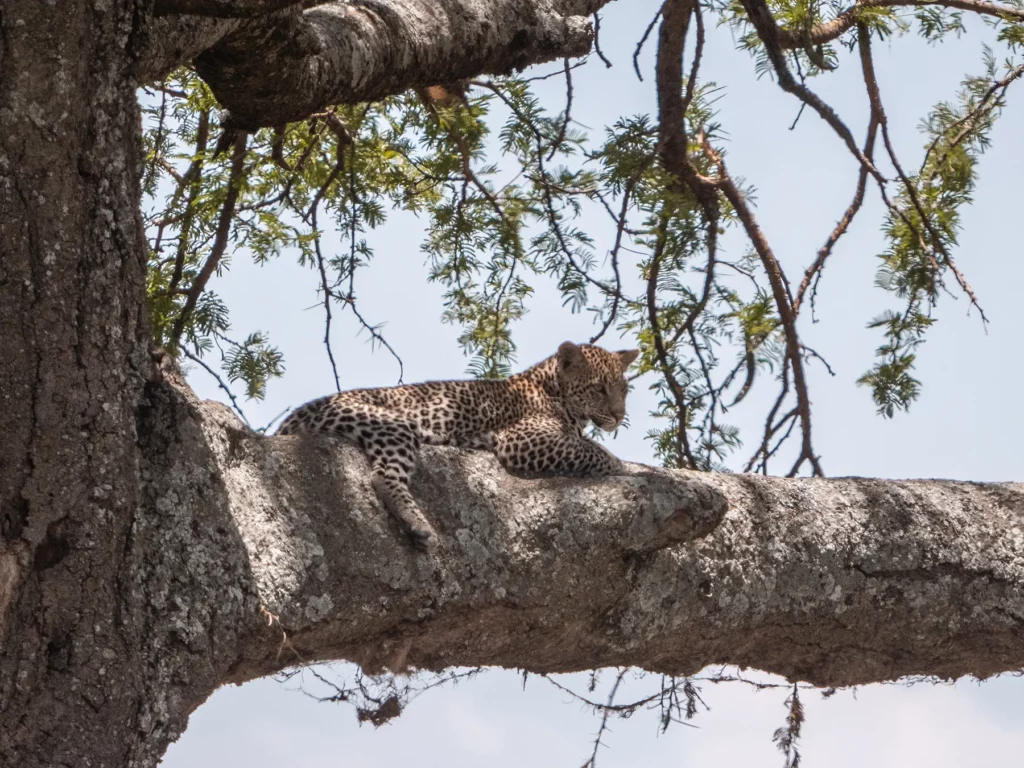
How Many Lions are in Tarangire National Park?
Lions are the most common predators in Tarangire, with around 250 individuals found here. They are spotted most days so your chances of a lion sighting during your safari are high, especially in the long-dry season.
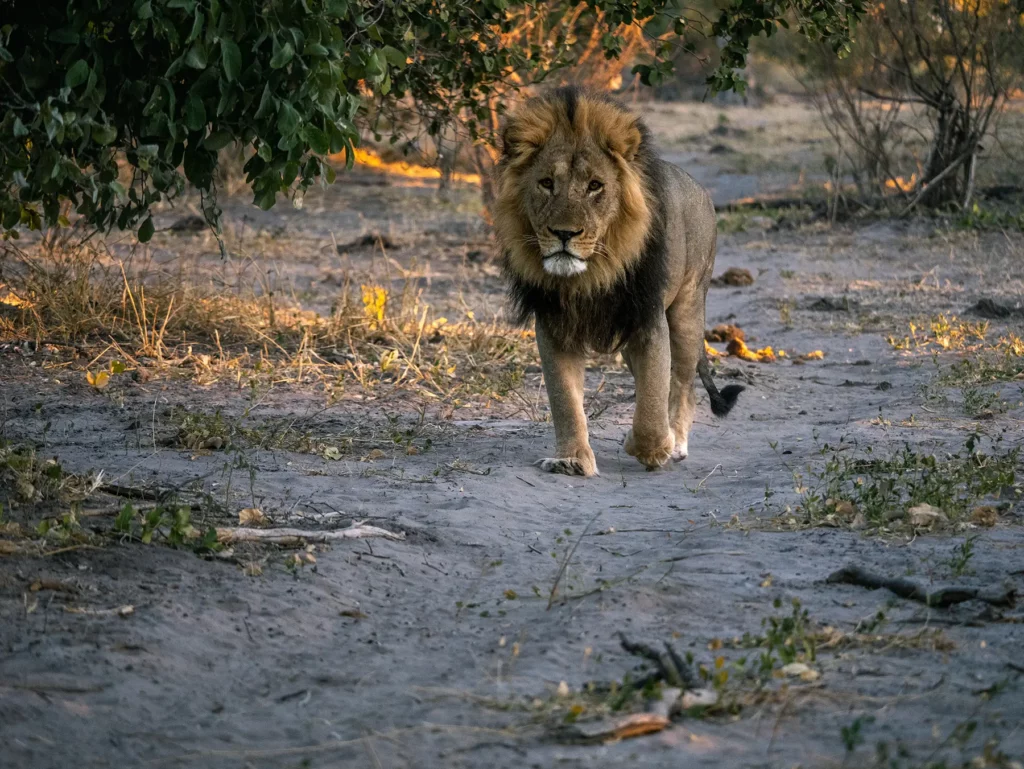
The table below compares lion densities (which equates to how likely you are to see a lion) in some of the most popular reserves in Tanzania. Tarangire sits somewhere in the middle with 3 lions per 100 km². However, this figure can be much higher in Tarangire’s prime lion viewing areas.
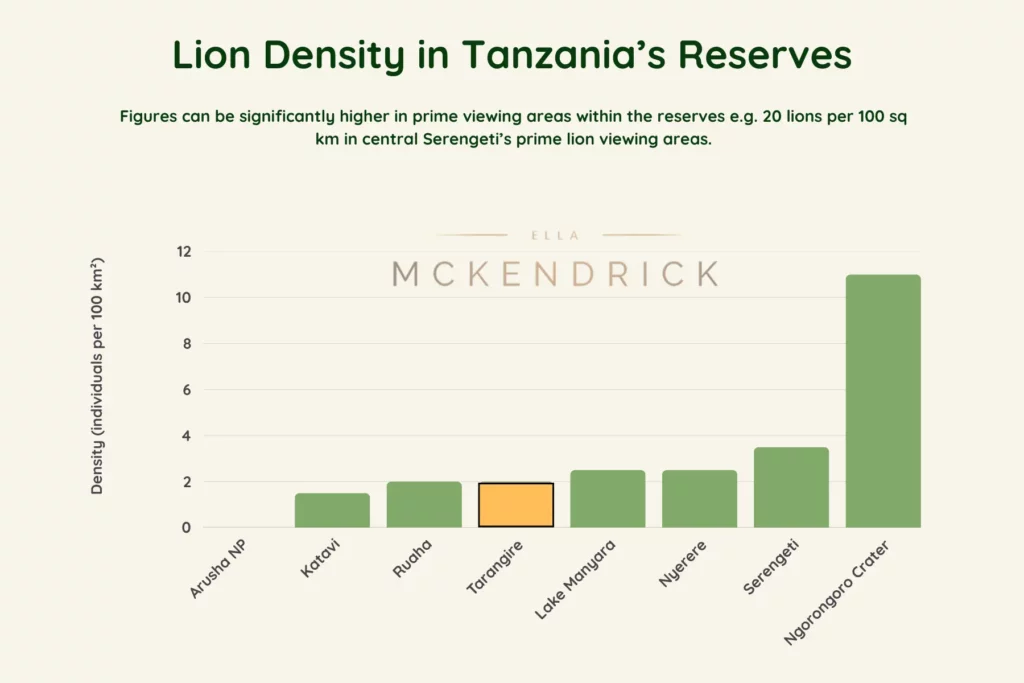
Are there Hippos in Tarangire National Park?
Yes, there are hippos in Tarangire. You’ll find them in Tarangire River and wallowing down in the nearby swamps – they’re particularly easy to see in the dry season when water levels are low.
Hippopotamus numbers are likely in the low hundreds.
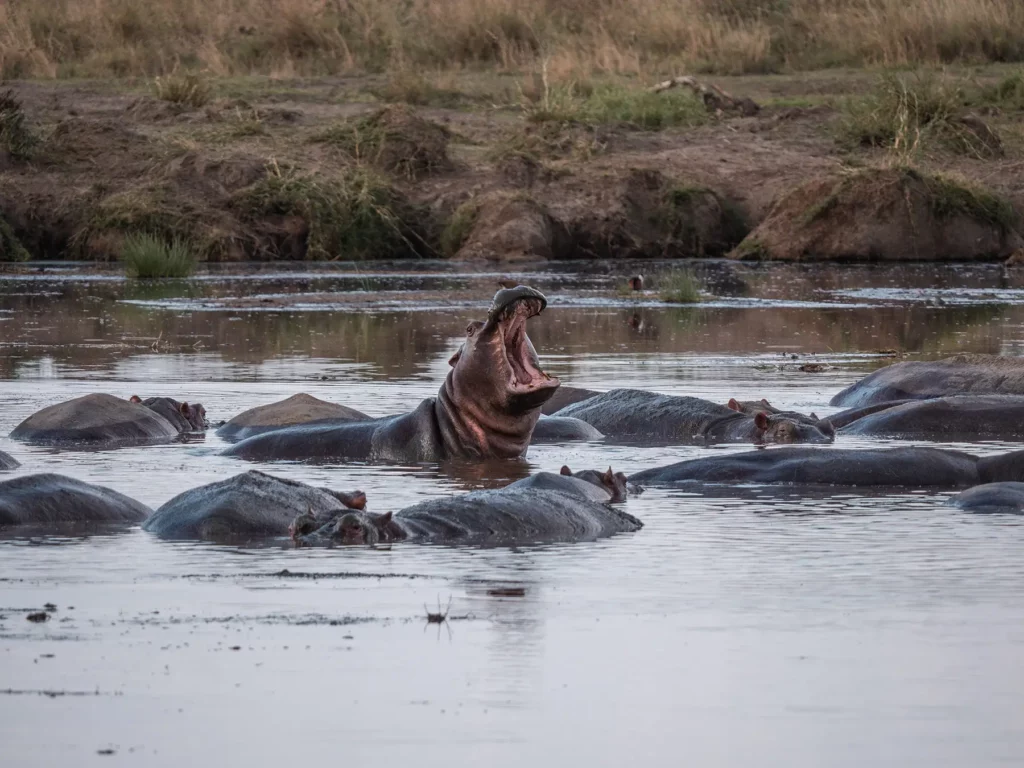
Are There Rhinos in Tarangire National Park?
No, there haven’t been any rhinos in Tarangire for the past few decades due to heavy pouching during the 20th Century.
Black rhinos do still reside in the Serengeti and Ngorongoro Crater due to the park’s heavy protection from poachers, so you may spot them elsewhere if you’re doing the full Northern Circuit.
Your best bet is Ngorongoro Crater, which has a small population of endangered black rhinos, best seen at sunrise before they split up to go foraging.
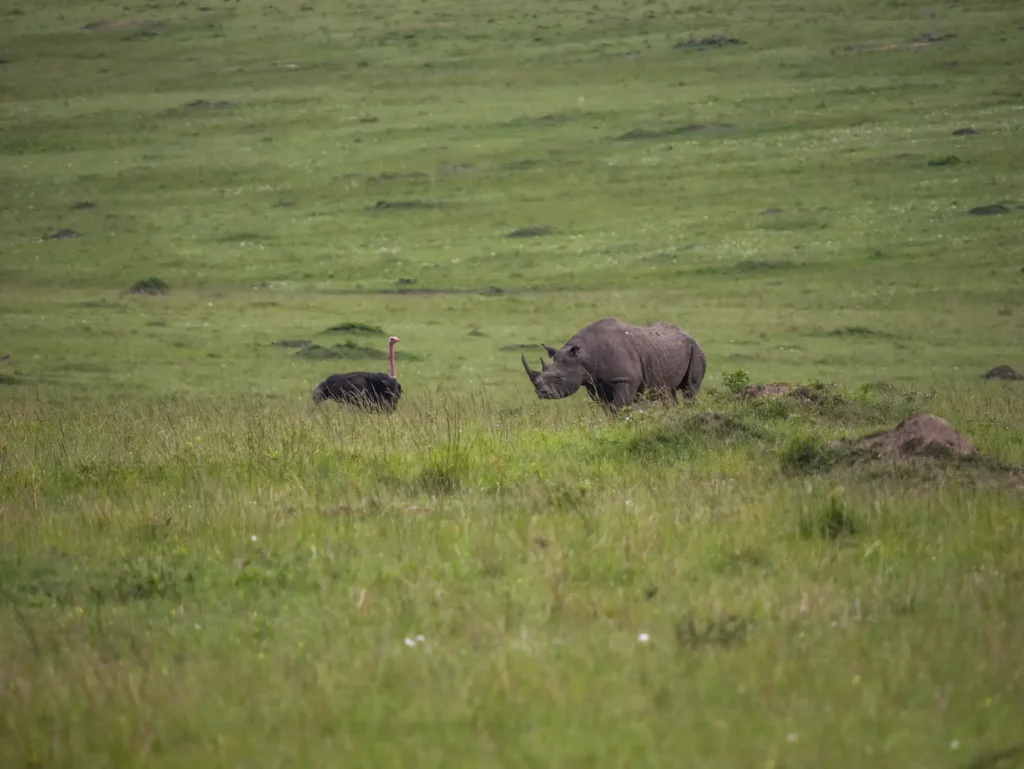
Are there Crocodiles in Tarangire National Park?
Yes, you can see Nile crocodiles in Tarangire. The best places to spot them are the Tarangire River and the nearby wetlands, where they may be lounging on the shore or submerged in the shallows.
Sightings are best when wildlife congregates around the water sources in the dry season. The specific number of crocodiles is not known, but estimates are in the low hundreds.
The nearby Serengeti National Park is the best place to see crocodiles, especially during the wildebeest migration from July to October, where I have seen crocodiles hunting wildebeests crossing the Mara and Grumeti rivers during the famous river crossing.
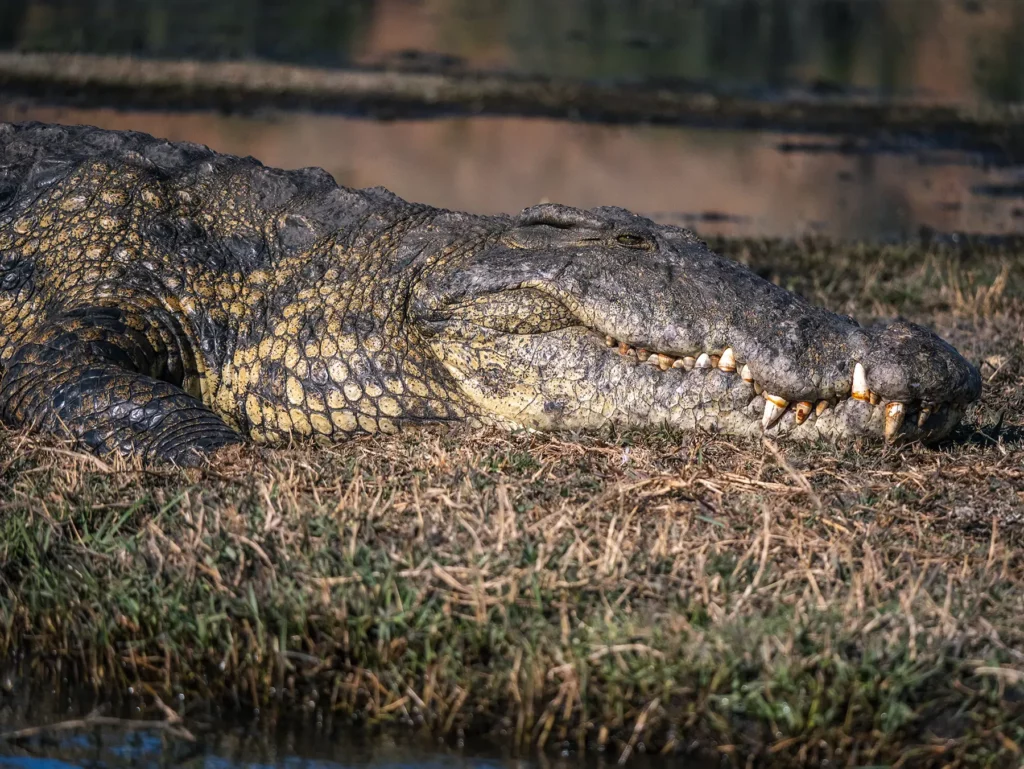
Are there Giraffes in Tarangire?
Maasai giraffes are present in Tarangire and are often seen during game drives around the national park. You’ll find them on the plains and in the wooded areas, feasting on leaves from their favourite acacia trees.
In 1991, an aerial survey estimated approximately 1,377 giraffes in Tarangire National Park and the surrounding Game Controlled Areas.
There have been more recent studies covering the larger Tarangire-Manyara ecosystem between 2011 and 2015, which estimated approximately 2,777 Masai giraffes.
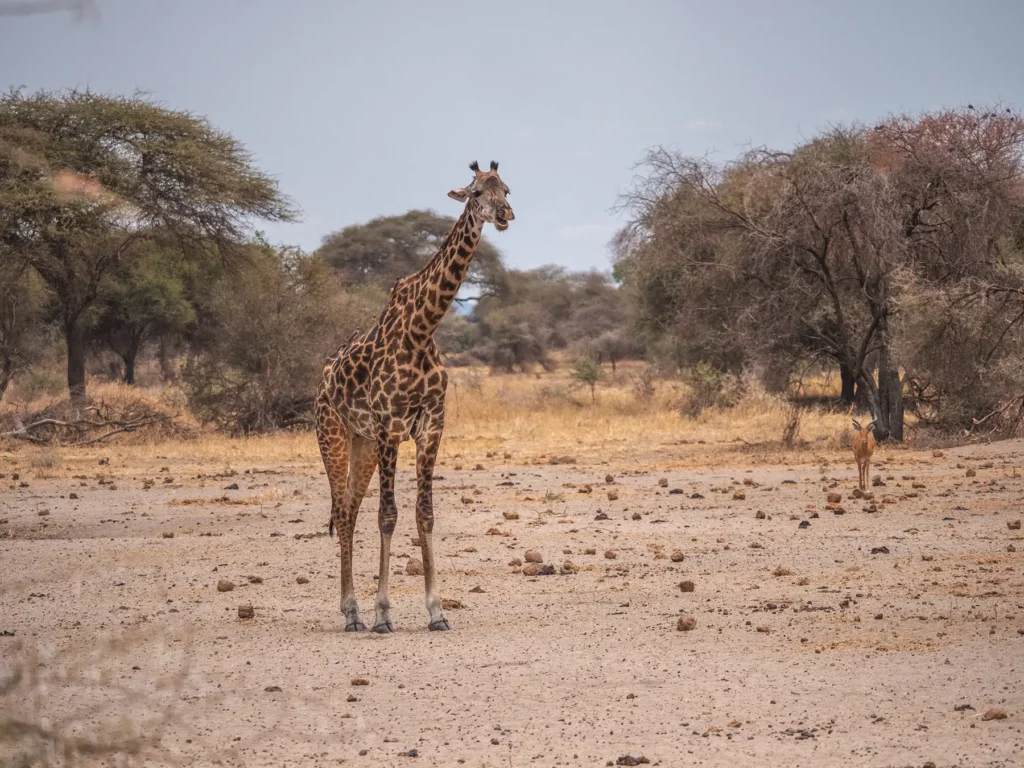
Is Tarangire Good for Birdwatching?
Bird watchers love Tarangire with its vast populations of both local and migratory species. Over 550 species have been recorded in Tarangire, including several rare and endemic birds.
Head to the woodlands, hills, and swamps for the prime sightings. Popular species in Tarangire include rufous-tailed weavers, hornbills, kori bustards, yellow-collared lovebirds, ostriches, Nubian woodpeckers, and eagles.
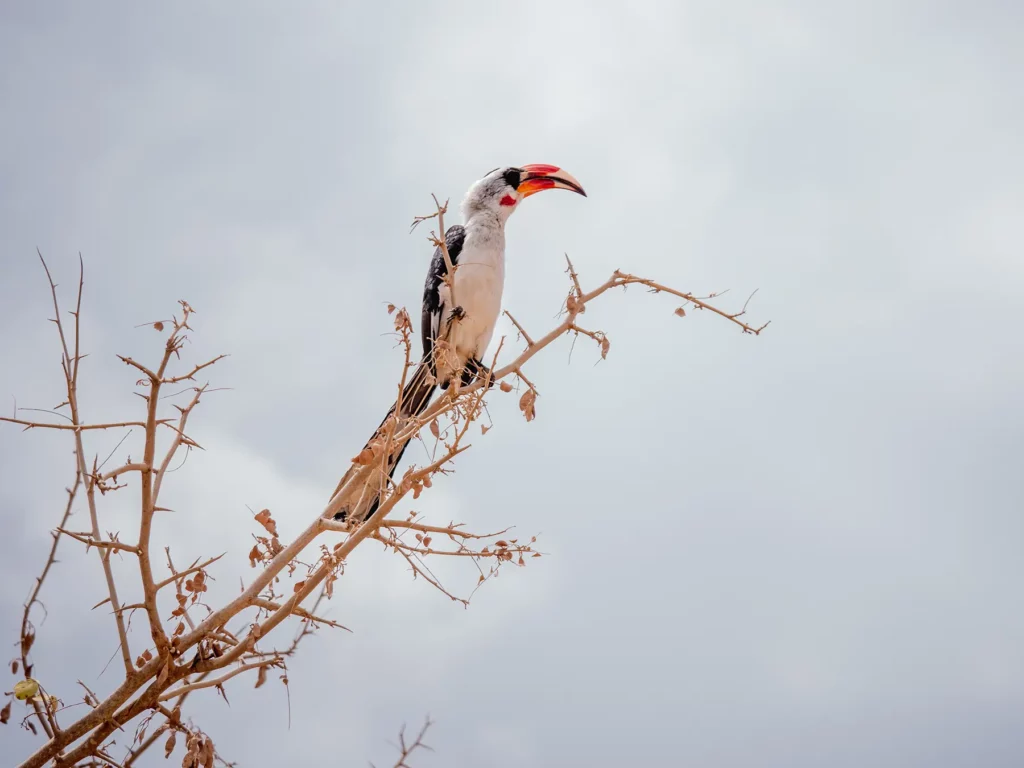
Most people visit Tarangire during the dry season, as this is when animals are easier to spot. Yet for birds, the best time to come is in the wet months between November and March.
During the wet period, many migratory bird species from Europe and Asia arrive in Tarangire, increasing the park’s bird diversity. Furthermore, it’s the breeding season for local bird species, which means they will often display vibrant plumage.
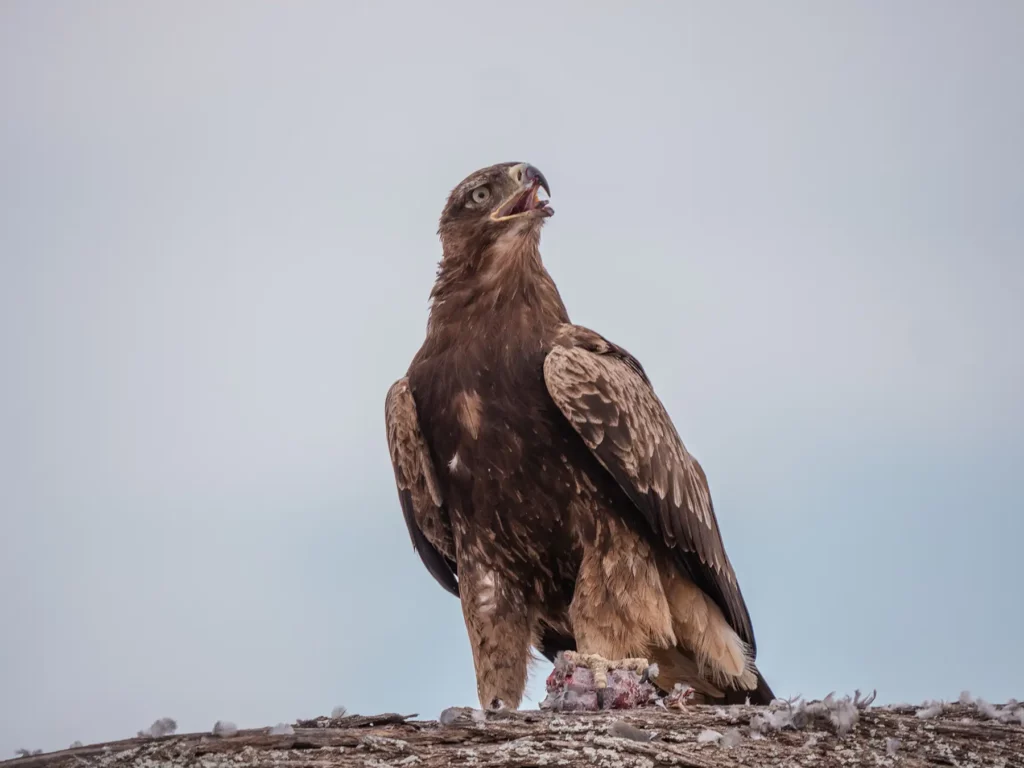
Wildlife Conservation in Tarangire
Conservation in Tarangire is a collective effort, with local communities and NGOs working alongside the Tanzanian government and global organisations to safeguard local wildlife.
One of the main initiatives is the Tarangire Elephant Project, which has been running since 1993. Its focus is on sustainably managing the ecosystem through research and training for local communities.
A major area of work is maintaining the network of wildlife corridors in and around Tarangire to ensure animals like elephants can continue to move freely between natural water and mineral sources. Similar projects are carried out by the Tanzanian Elephant Foundation to monitor elephant movements and research wildlife behaviour to prevent future human-animal conflicts.
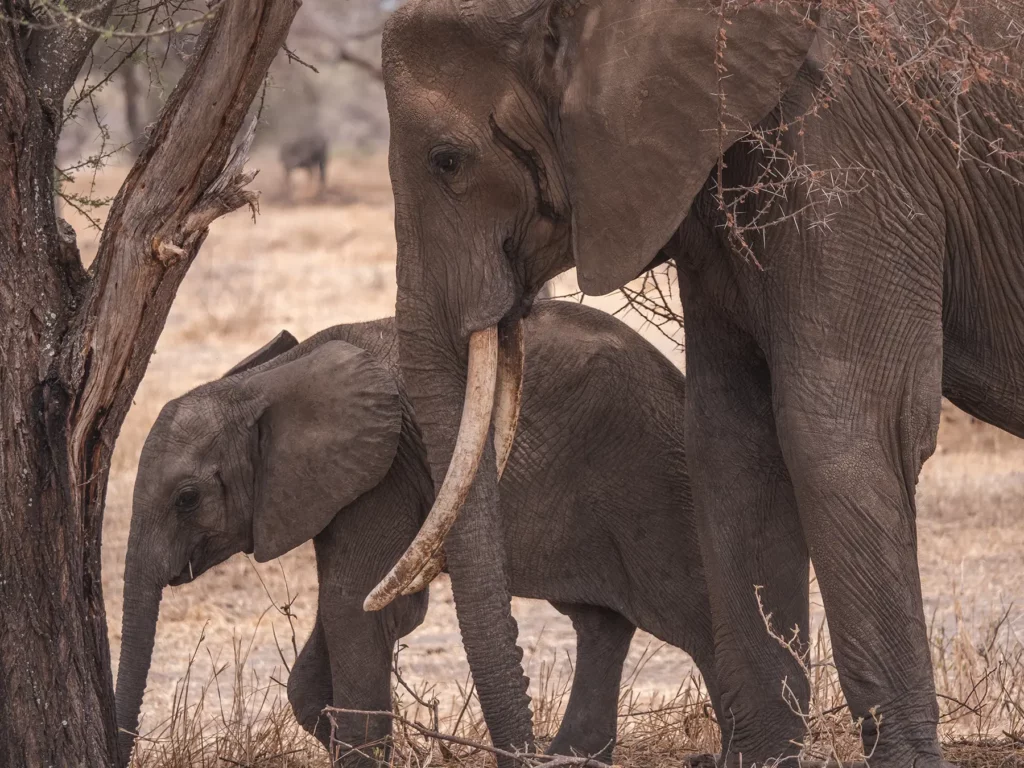
As many mammals leave the park for several months of the year, protecting the habitats and migration routes adjacent to Tarangire is vital. In recognition of this, the Tarangire Conservation Area has been established to preserve the ecosystems in the village lands next to the park. Local communities are involved in the management of the area, helping protect wildlife whilst benefiting from low-impact tourism initiatives.
Anti-poaching programmes are also in operation throughout Tarangire National Park. Patrols are regularly carried out to deter potential poachers and capture anyone involved in illegal activity.
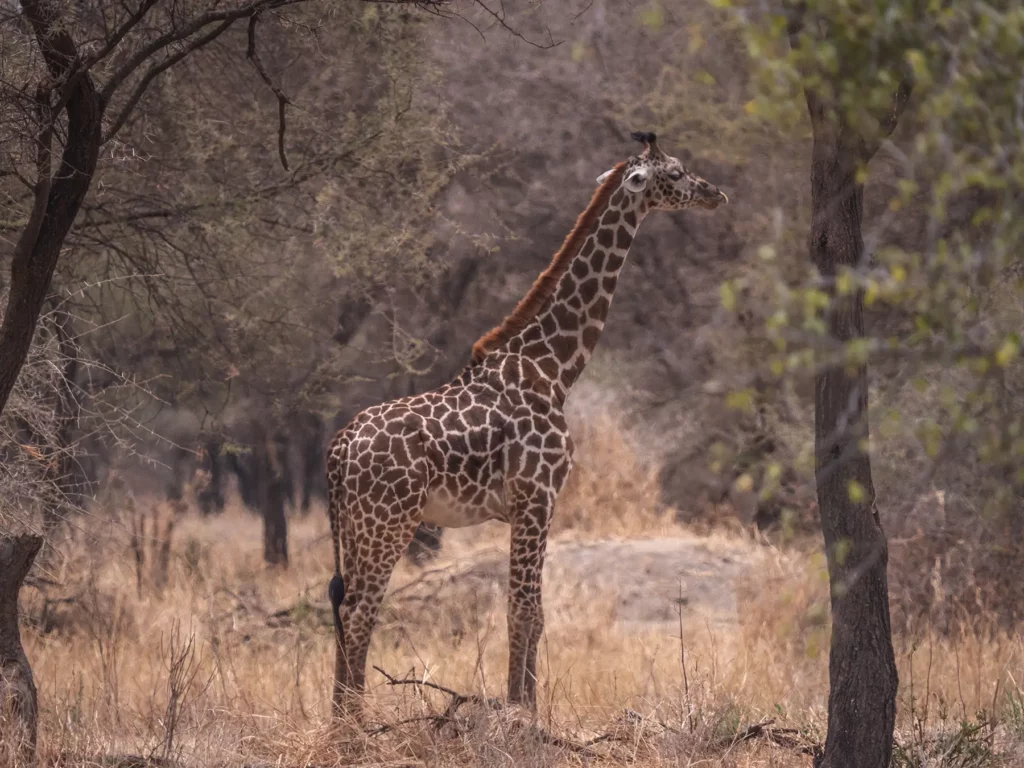
What are the Threats to Tarangire
Human-wildlife conflict is one of the major threats to Tarangire. The land surrounding the park is increasingly used for agricultural practices and livestock grazing, which disrupts wildlife corridors. These corridors are vital to animals who have long used these traditional routes between water and mineral sources. Local charities are working hard to combat these issues, and the local Maasai communities work as stewards to protect the land and its precious ecosystem.
Climate change also presents an increasing threat to Tarangire, and across all of Africa. Variations in Tarangire’s weather are becoming extreme, leading to a decline in wildlife populations and an imbalance of vegetation. Water is becoming scarce during the dry season, forcing animals to change their habits by searching further and harder for water.
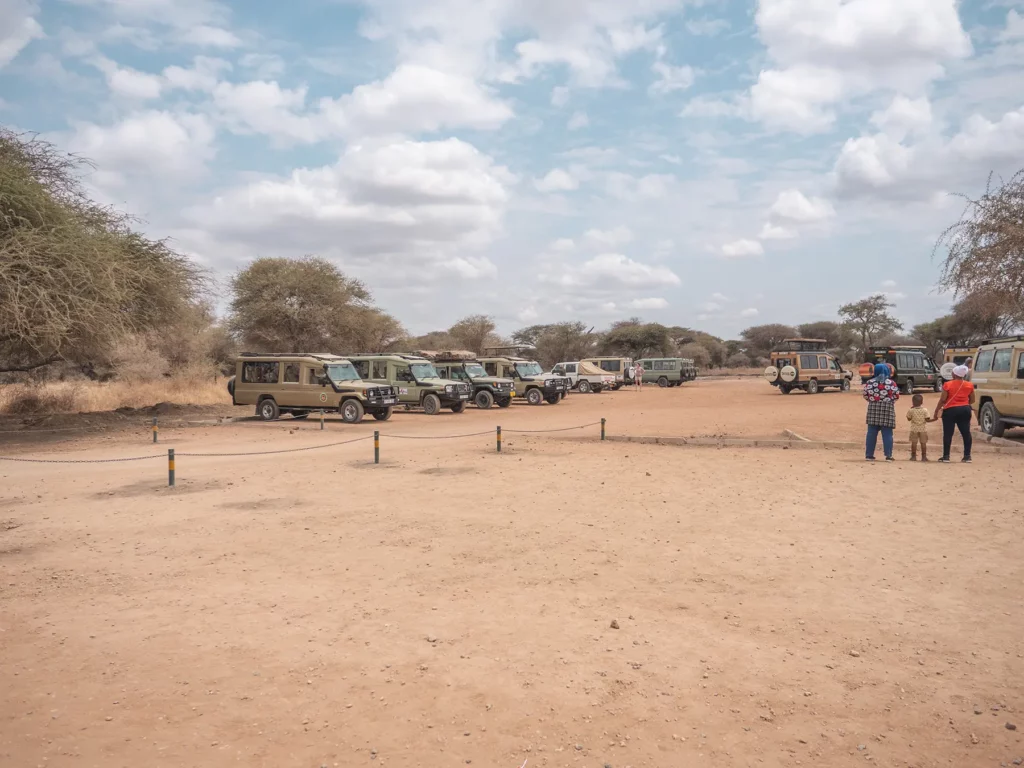
For decades, poaching has been one of the greatest challenges facing Tarangire National Park. Poachers target elephants for their ivory tusks, as well as other wildlife like wildebeest and buffalo for their meat. You can still see the giant baobab tree which served as a hideout for poachers until the mid-1990s.
Human activities such as development, agricultural practices, and livestock grazing have also led to habitat loss. This impacts wildlife in the park and surrounding conservancies, making it harder for animals to find food and water.
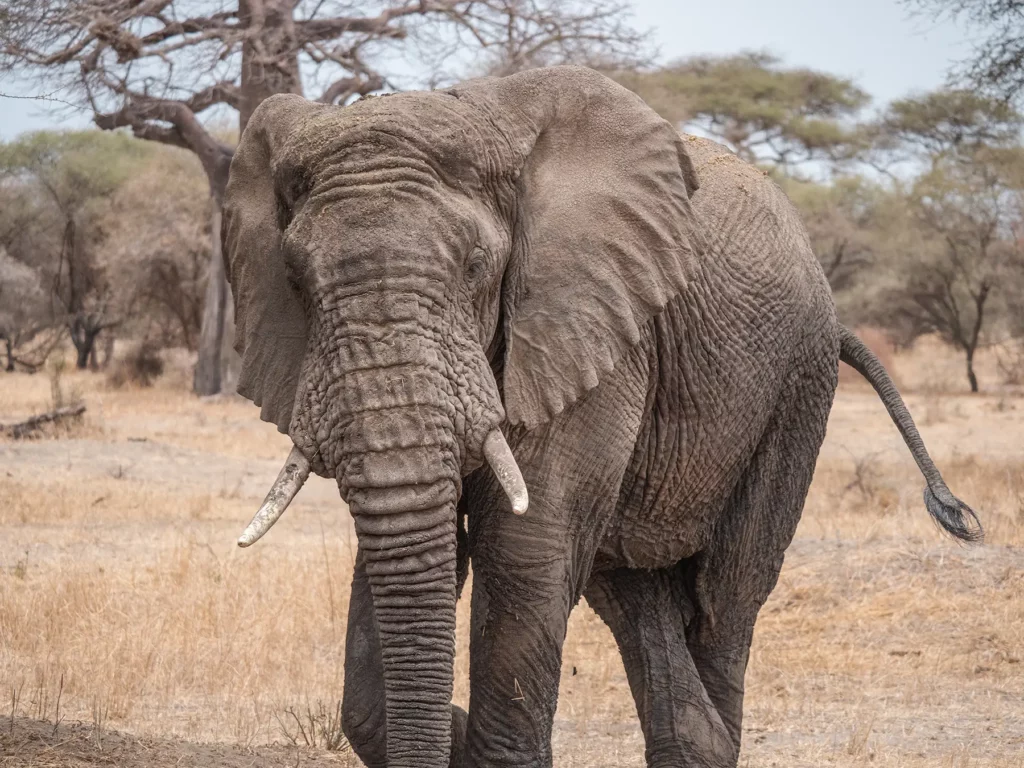

Embark on the Safari of Your Dreams
Save time and ensure an incredible safari experience by getting quotes from my recommended local safari companies
I’m here to make booking your perfect safari quick, easy and risk-free.
Join the rapidly growing tribe of over 1,000 travellers who’ve booked their dream safari using my insider tips and recommendations.

It takes under 60 seconds to fill out the form and in under 48 hours you will receive multiple, no-obligation proposals from my favourite local tour operators with glowing online reviews.
Get your free no-obligation safari quotes and my top safari tips and recommendations
Weather & Climate Tarangire National Park
Tarangire’s climate is dictated by the rainy periods, which run from March to May, and November to February. In recent years, the rains have become unreliable, which sometimes leads to drought conditions. The lack of water affects both the vegetation and the animals that live in the park.
Throughout the year, Tarangire experiences warm temperatures which range from about 24-30°C. It does get cooler at night, with temperatures dropping to around 13°C. So, pack warm clothing if you’re going out on a night game drive.
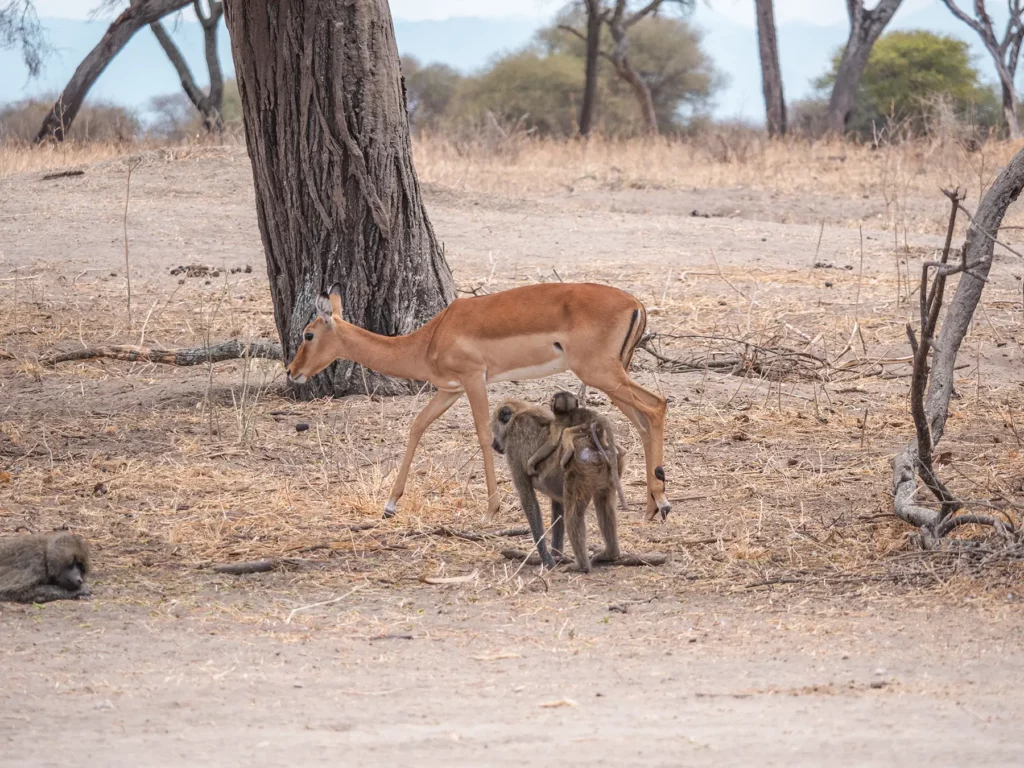
What is the Best Time / Month to Visit Tarangire?
Wildlife viewing in Tarangire is best during the long dry season between June and October and the short dry period from December to February.
Below I’ve ranked each month in the Tarangire.
- Excellent
- Good
- OK
- Poor
The infographic below shows what you can expect in each month.
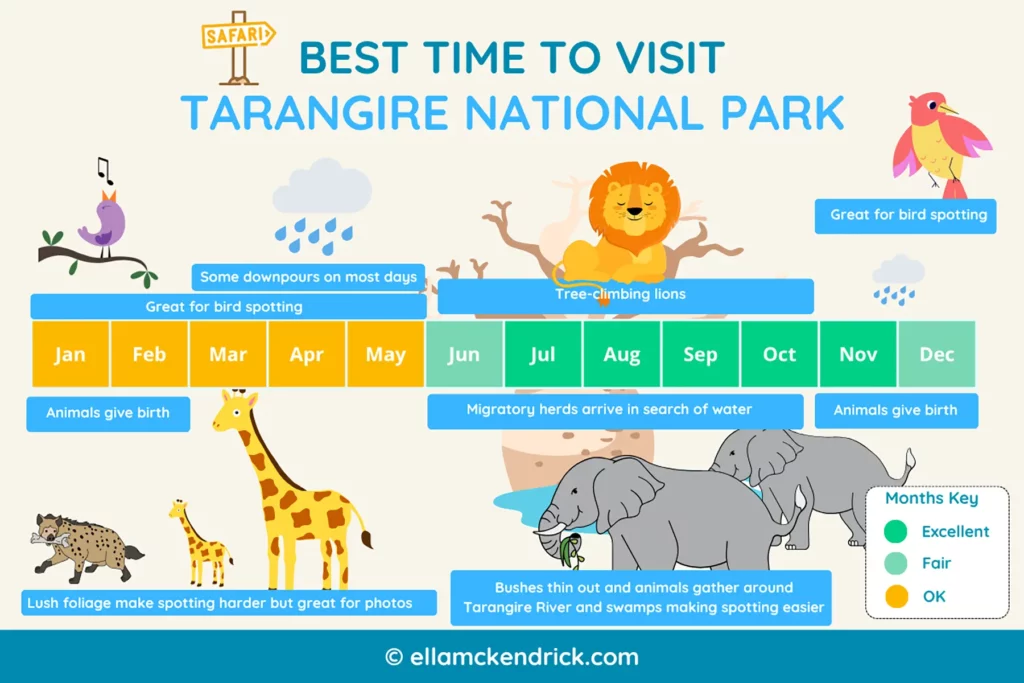
You can jump to any of the months in Tarangire below.
January and February (Short Dry Season)
March to May (Long Rainy Season)
June to October (Long Dry Season)
The Long Dry Season (June – September)
The long, dry season is a great time to visit as animals congregate in areas where they can still find water, such as river pools and the swamps, making them easier to spot. Vegetation at these times of year is sparser, too, so lions and leopards are more visible up in the trees.
In addition to the fantastic game viewing conditions, the weather is pleasant, and there is less malaria risk during these months.
On the downside, this is peak tourist season, so expect higher prices and bigger crowds; I recommend booking well in advance if you choose to visit during these months.
Bring layers, too, as while the weather is generally calm and sunny, with temperatures around 26°C during the day, it can get chilly at night, especially if you’re heading out on early morning game drives.
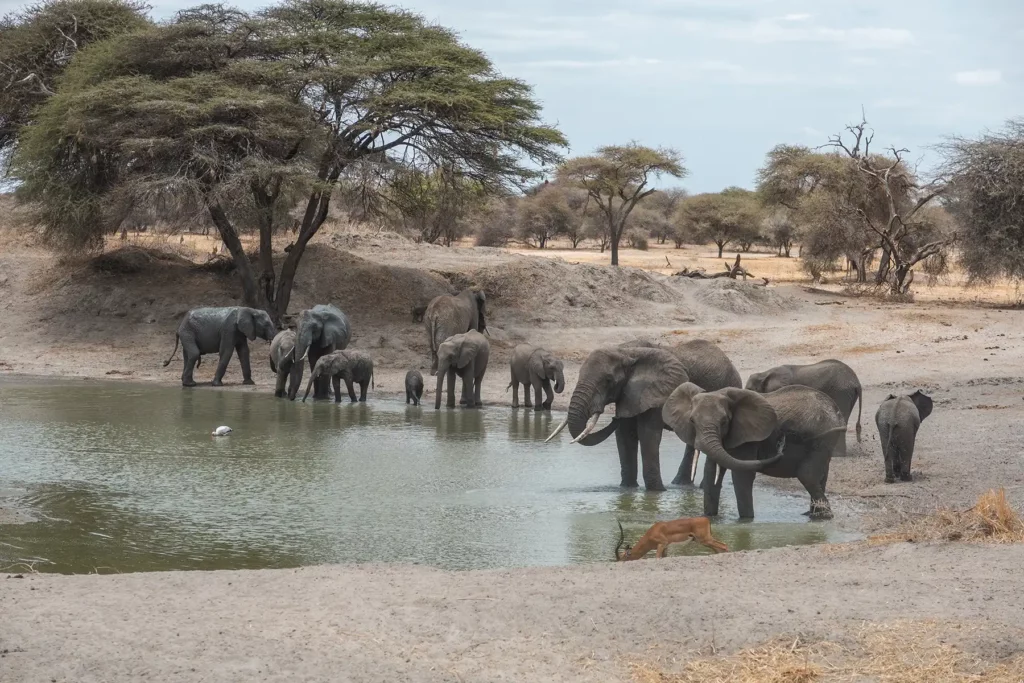
The Short Rainy Season (October – November)
During the wet season, between November and May, many migratory animals have moved north out of Tarangire, although there are still plenty to see year-round, including elephants.
Despite these months falling in the short rainy season, the worst of the weather usually comes during the afternoon, so you should get some dry weather during the day. It also doesn’t tend to get too high or too cold.
Visiting during the low season means fewer safari vehicles competing for sightings and often lower prices for accommodation and tours.
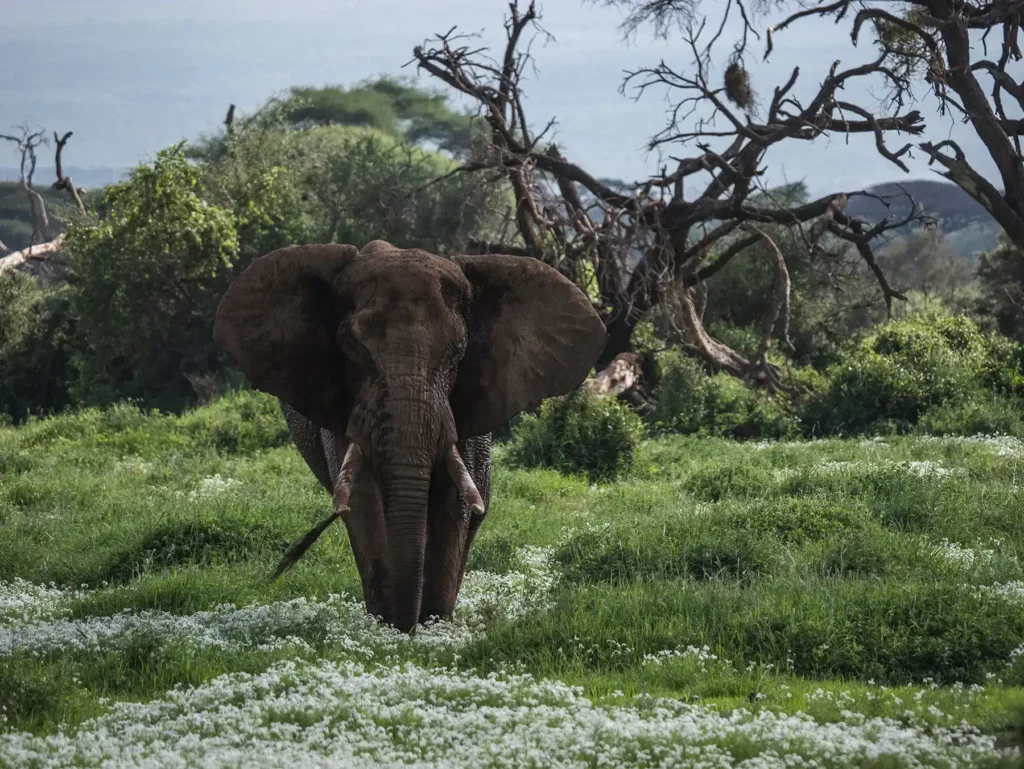
The Short Dry Season (December – February)
Offering a reprieve from the rains, the landscapes are lush, green, and beautiful during the short dry season. While this makes it a little harder to spot wildlife because there is more foliage for them to hide behind, the scenery is at its most stunning. Besides, there is still much to see.
It’s also one of the best times for birding, as over 500 species of sedentary and migratory birds make Tarangire their home during these months.
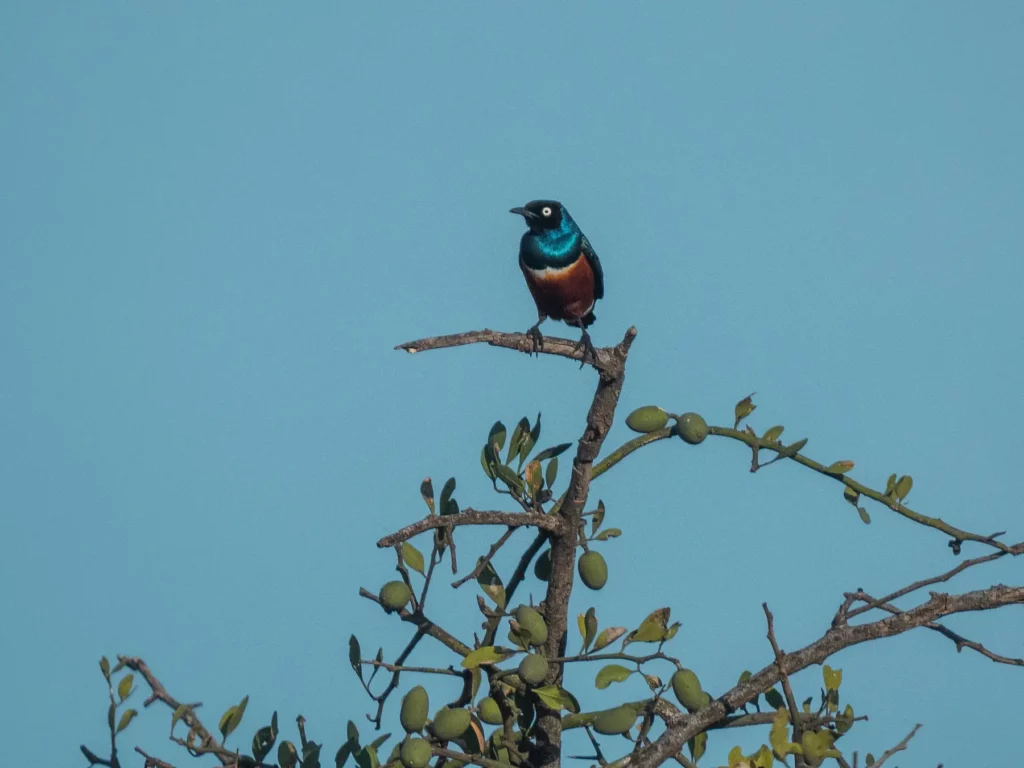
The Long Rainy Season (March – May)
It’s best to avoid late March to May as this is the wettest time of the year, and some areas of the park are impassable. It’s also the peak season for malaria risk. The only upside is this can be an excellent time for birdwatching. That said, if you don’t mind the weather and want to take advantage of lower prices, you can still spot game at this time of year – just not nearly as much as during the dry season.
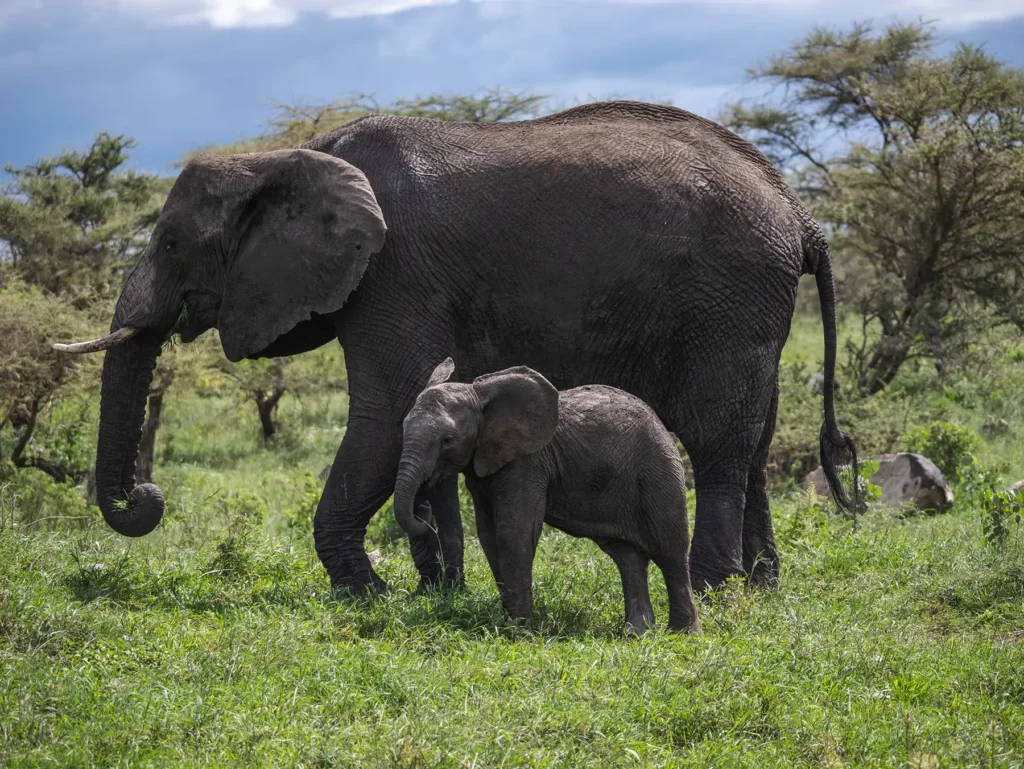
For more information on when and where to go on safari, check out my guide on the best time to visit Tanzania.
Is Tarangire Crowded?
As one of the top three parks in Tanzania, Tarangire can certainly get busy, especially during the peak of the dry season in July and August.
The southern part of Tarangire is further away from Arusha (where most safari tours depart from) which means it’s quieter here than up in the north of the park. This is a great place to go if you want sightings for yourself.
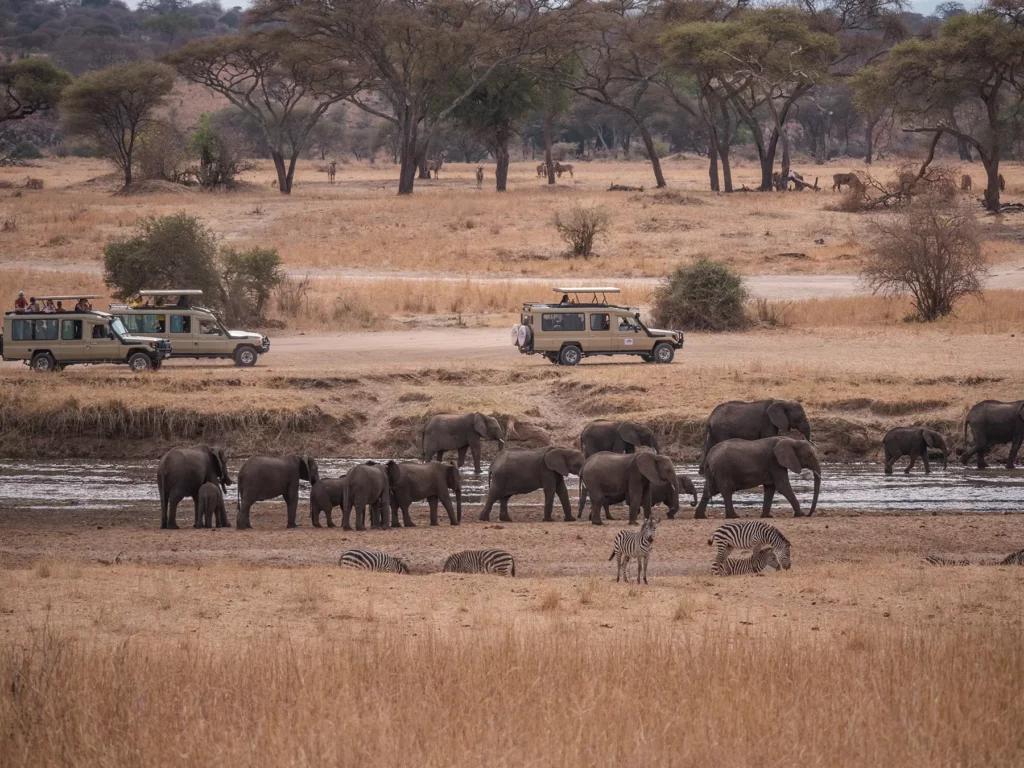
How Many Days Should I Spend in Tarangire?
One day is enough to see all the key species in Tarangire National Park. However, if you want to visit the south of the park then I’d recommend 2 days.
If you have longer, it’s one of the best parks in Tanzania, so you could spend a week or more if you’re really into wildlife or photography.
It takes around 2-3 hours to drive the 87 miles from Arusha to Tarangire, so remember to factor this into your itinerary time if you’re travelling to the park by road.
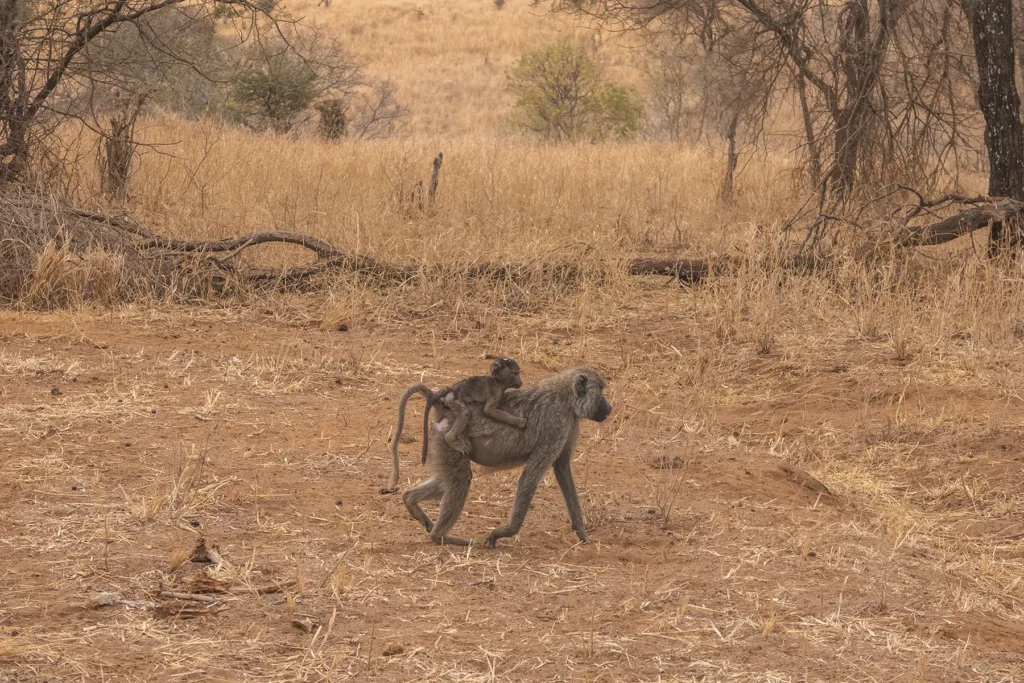
Most Tanzania Northern Circuit itineraries will allocate 1 day to Tarangire as default.
You can visit Tarangire as part of a 2-week or 7-10 Day Tanzania safari itinerary covering the key Northern parks such as Ngorongoro Crater and the Serengeti.
For shorter trips, Tarangire can be included in a 3-day or 5-day Tanzania safari itinerary.
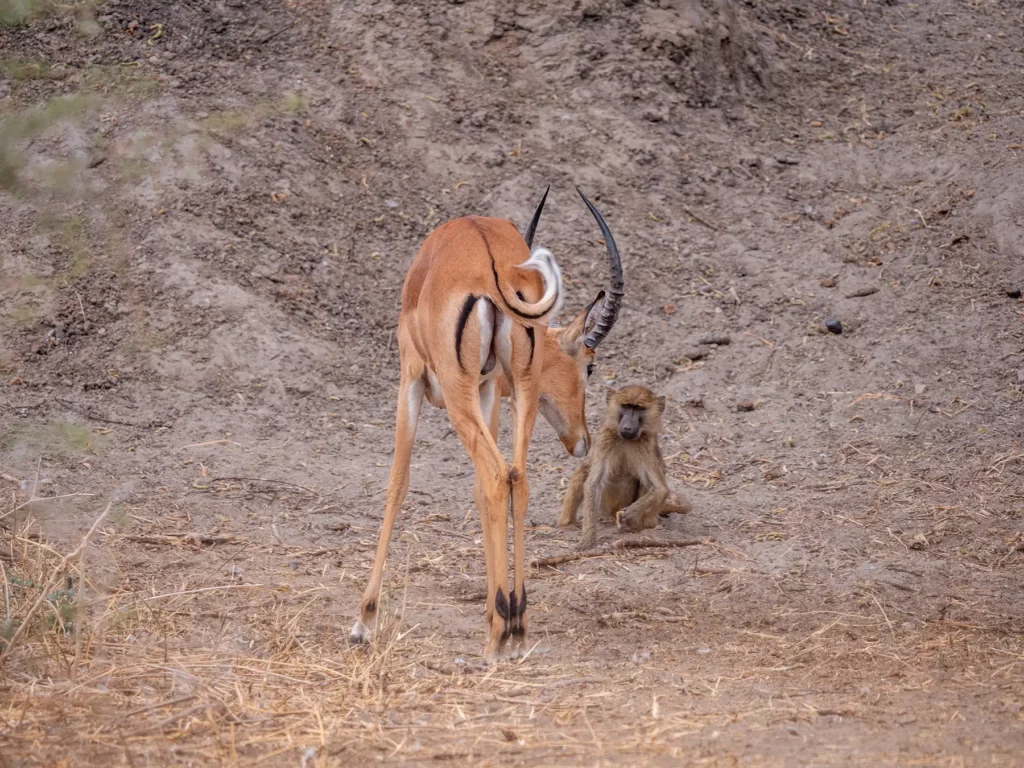
Tarangire Safari Areas
The Tarangire landscapes are vast and varied, with everything from grassland plains and riverine woodlands to hills and swamps. Each habitat is home to different animal species, so travelling between them makes for a rich and rewarding experience.

Here are the main areas you’ll explore on your game drives:
You can jump to each of the areas using the links below.

The Tarangire River
The Tarangire River runs through the heart of the national park, and many safari activities are concentrated along this waterway. The river is the main water source in Tarangire, so game-viewing here is superb.
Come in the dry season when water levels are low for the best wildlife sightings. The river attracts migratory animals like wildebeests, zebras, and buffalos, as well as lions and leopards.
This is a particularly good area for encountering elephants, and you’ll often see them digging in the sandy banks in search of the underground water.
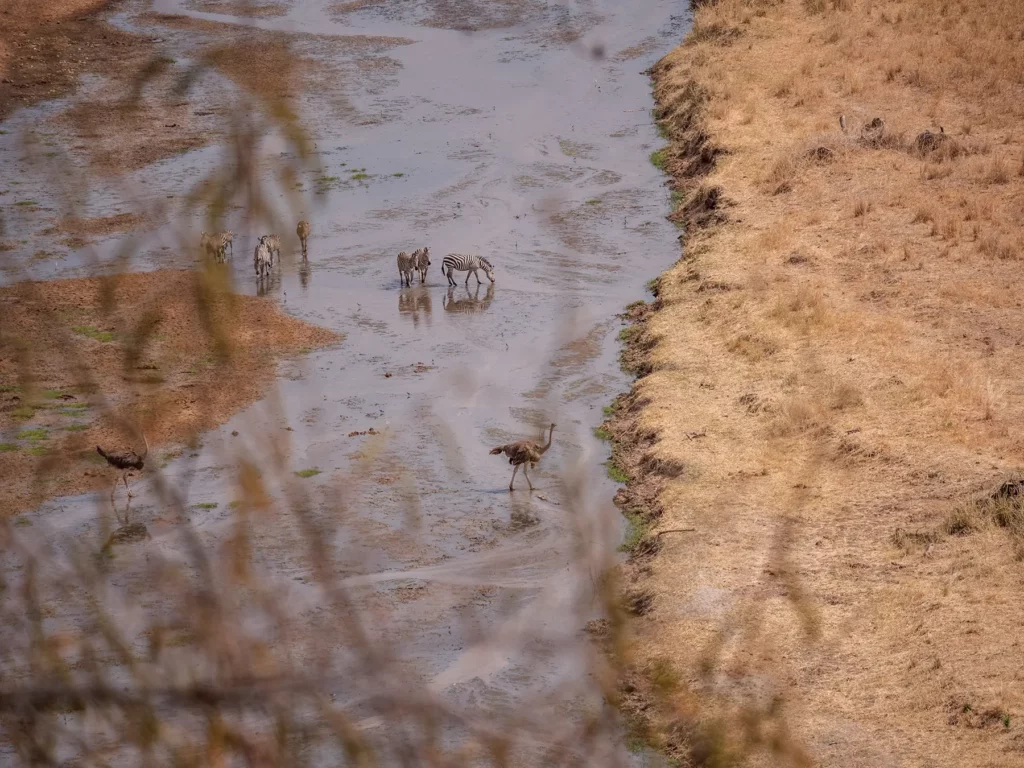
The Network of Swamps
Tarangire has several large swamps, which are favourite hangouts for hippos and crocodiles. The swamps are one of the few remaining water sources during the dry season, which is why you’ll find so much wildlife here. Visit Tanzania in January and February or come between June and October for the best viewing conditions.
Most swamps are in the southern and eastern areas of the park and feed into the Tarangire River. The three main swamps in Tarangire are Gurusi, Silale, and Larmakau. These are great places to see lions, leopards and tree-climbing pythons.
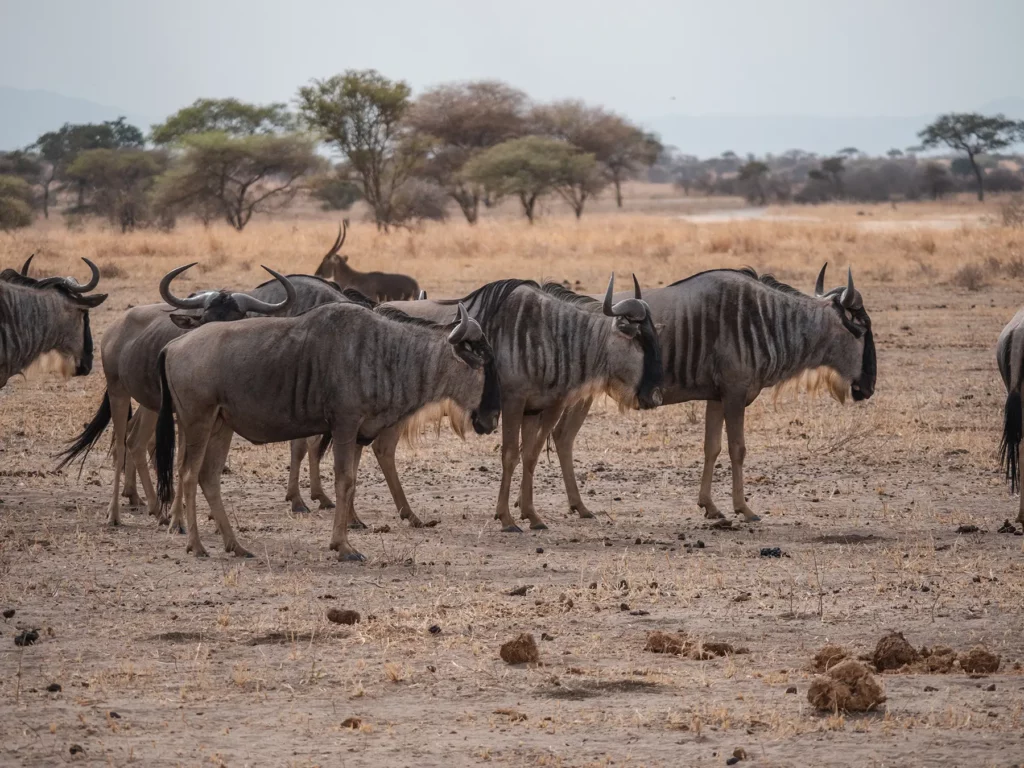
Matete Woodlands
The Matete Woodlands are known for the tall elephant grass and reed beds that line the banks of the river in western Tarangire. If you want to see leopards, this is one of the best places in the park for sightings. Look up into the acacia trees and you might get lucky!
The woods are also home to lions, bushbucks, giraffes, and the rare fringe-eared oryx. You’ll enjoy good views of Lolkisale Mountain from here too.

Kitibong Hill
Over in the west of Tarangire, Kitibong Hill is known for its huge herds of Cape buffalo, who thrive on the acacia plains in this area. Your chances of spotting the packs of wild dogs are higher here, (but still unpredictable and rare) than in most other parts of the park, so keep your eyes peeled.
Birdlife is abundant at Kitibong Hill too and is especially good for ground hornbills. Unlike their counterparts, these striking birds live on the ground and tend to run rather than fly when feeling threatened.

Grassland Plains
The plains are where you’ll be spending a lot of time trundling about the bush in your safari vehicle. This is the best place to see plains game like wildebeests, buffalos, and gazelles, and elephants are regularly seen here too.
The plains are also where you’ll find iconic sights like the giant baobabs and unusual sausage trees. The latter is a favourite with lions and leopards who can sometimes be seen up in the branches. Look out for the towering red termite mounds too – some of them are as tall as a human.
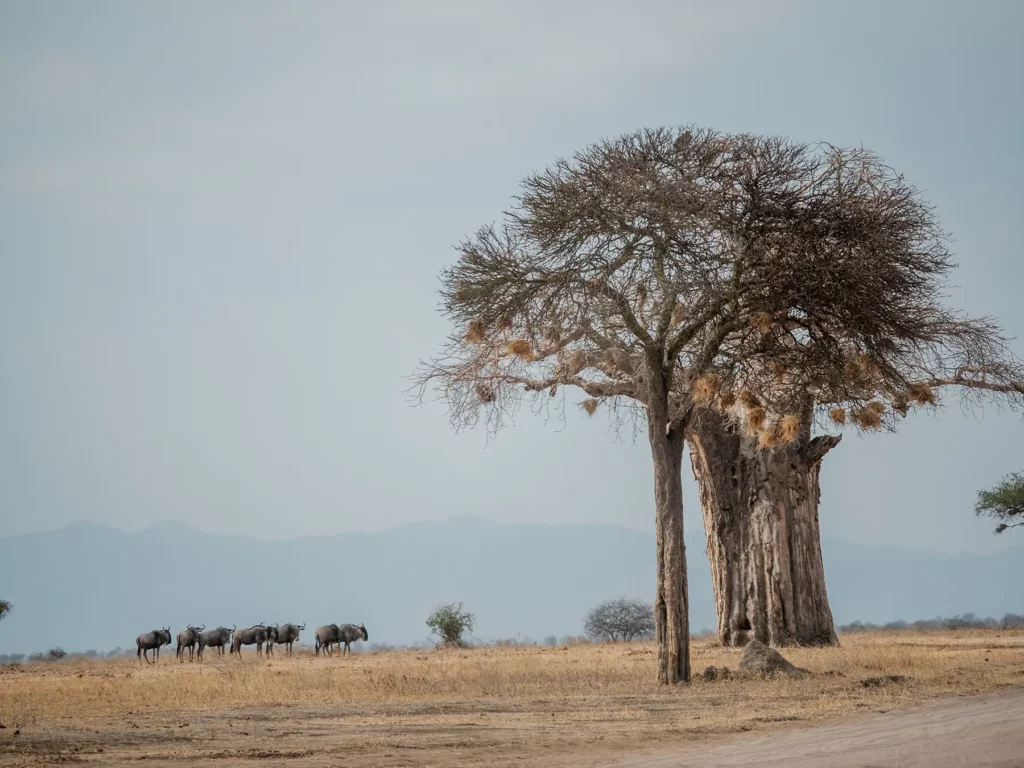
Lemiyon Triangle
This triangular-shaped area of wilderness up in the far north of the park is known for its varied vegetation. If you want to see the giant baobab trees, this is the place to come.
The Lemiyon Triangle is a great spot for bird watching with raptors regularly seen circling overhead. You’ll also have a chance to see huge flocks of red-billed quelea birds.
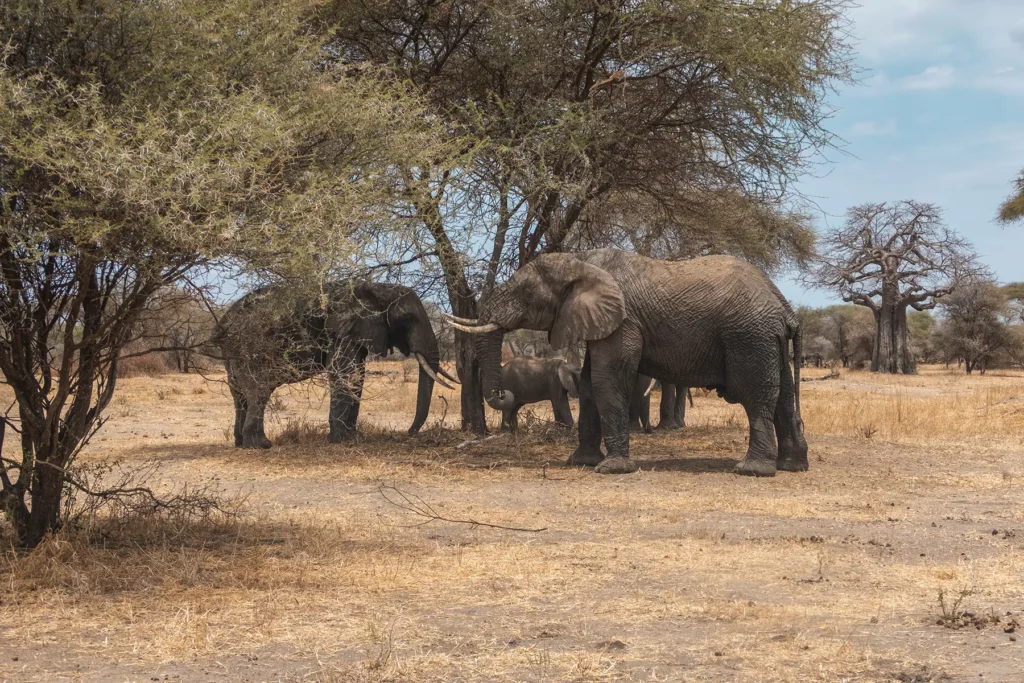
Birungi Circuit
The Birungi circuit is a rugged and remote track that loops through 50 miles of remote game territory in the west of the park.
This is a prime spot for viewing the little lesser kudu and the huge eland antelope, who favour the bush vegetation in this area.
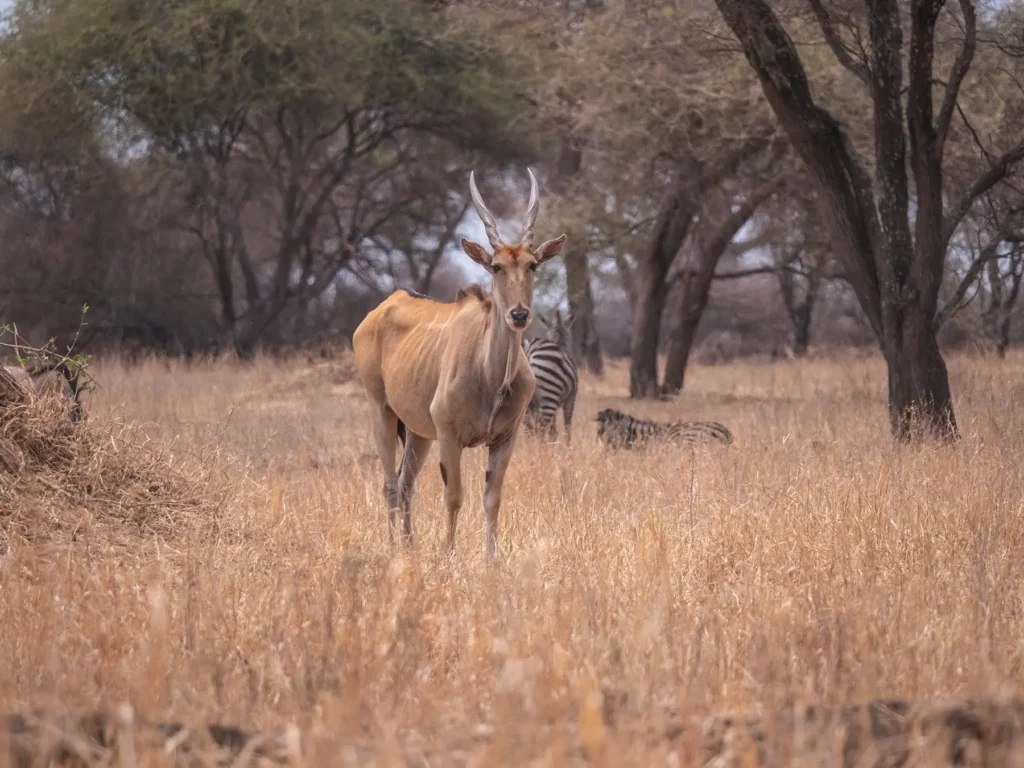
Best Lunch Spots in Tarangire
While on safari in Tarangire, you can enjoy full-day game drives with lunch out in the bush. There are a couple of scenic picnic sites located around the park so you can spend as long as possible out exploring.
Of course, if you prefer, you can return to your lodge or camp for lunch if you’re staying inside Tarangire National Park. I’m glad I stayed at the picnic area, though, as I got to watch cheeky vervet monkeys looking for scraps while I ate. Later, I also saw the biggest troop of baboons I’ve ever seen!
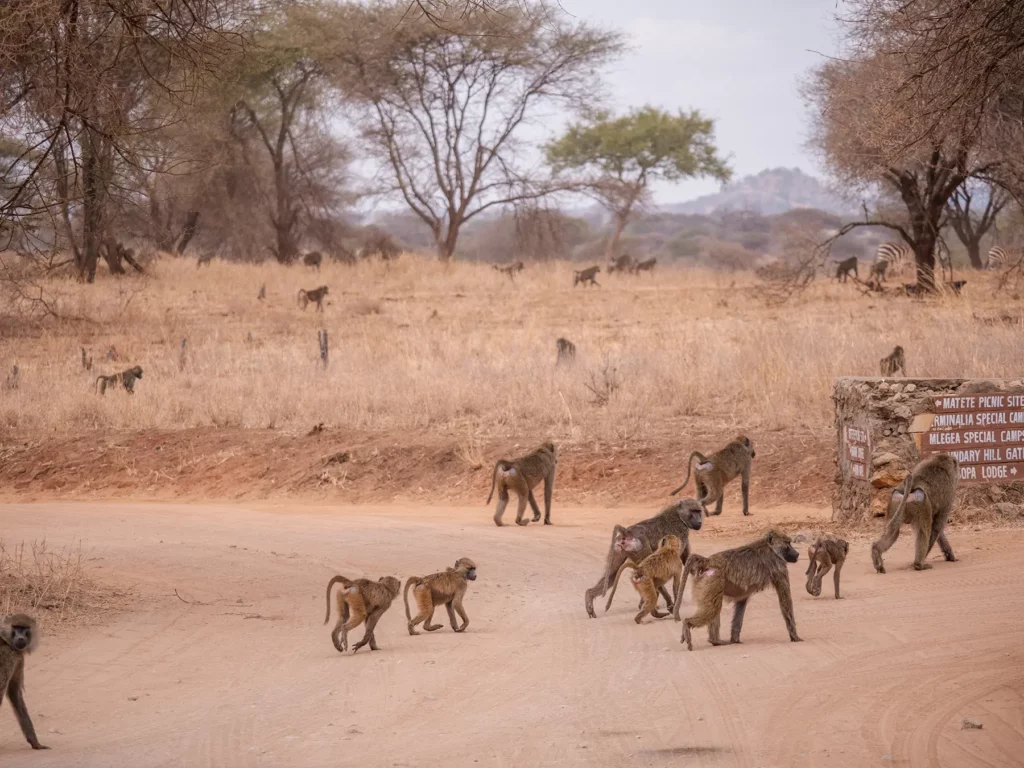
Matete Picnic Site
This small, peaceful spot is located on a raised bank beside the Tarangire River, in the northern section of the park. There are basic facilities here like toilets and picnic benches making it the perfect place for lunch with plains views for a backdrop.
Silale Swamp Picnic Site
You’ll find this spot at the western end of the Silale Swamp. It’s a more basic picnic site with benches but no toilets, yet it has more of a wilderness bush feel about it. You can eat your sandwiches while admiring the wetlands and its wildlife.

Are Tarangire Safaris Safe?
Yes, it’s safe to go on safari in Tarangire, and hundreds of tourists have a fantastic trip here every year. But as with anywhere, it’s wise to consider the region’s potential risks.
Wildlife & Natural Disasters
The most obvious threat whilst on safari is the wildlife, which is what you’ve come here to see. Yet by listening to your guide and following their instructions, you will be kept safe out in the bush.
Don’t walk around camp at night unless you’re with an escort staff member as many properties are unfenced, leaving wildlife free to roam.
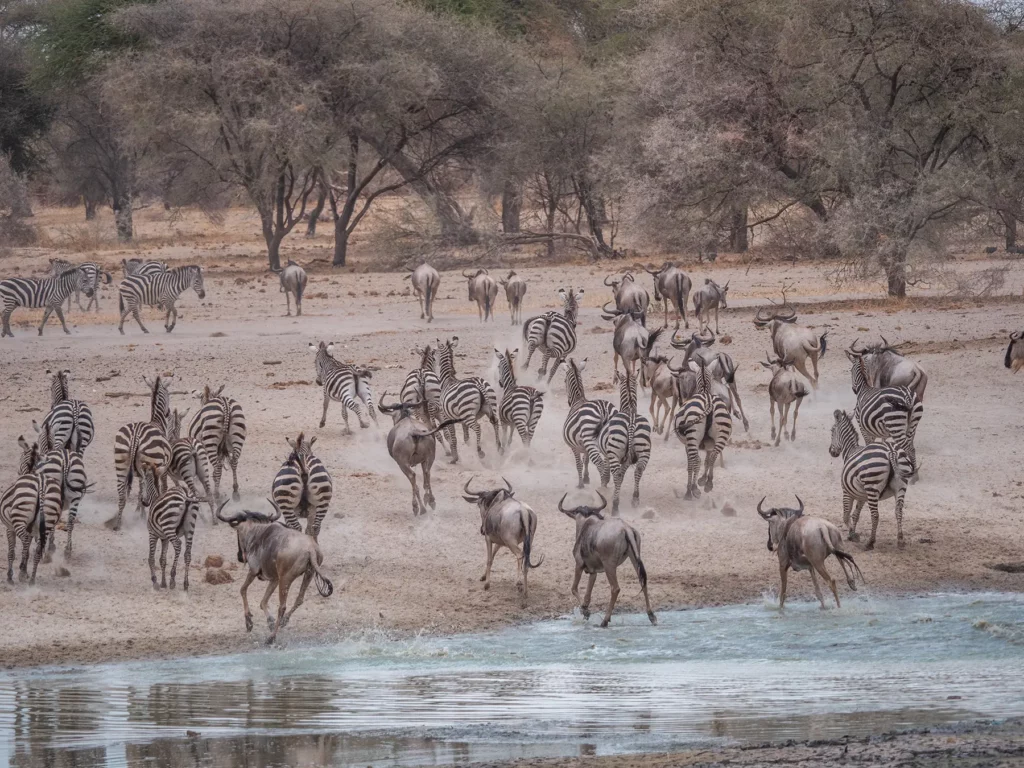
Is Crime an Issue?
There’s very little crime committed against tourists in Tarangire National Park, but as with anywhere, take normal safety precautions and don’t leave valuables on display.
Like almost everywhere in the world, a risk of terrorism is present in Tanzania. However, this is always highest in busy cities and national parks haven’t ever been targets. Crowded areas are most at risk so if you wish to eliminate the risk completely, you may wish to stay in a hotel outside of the city hub. On saying that, Arusha city is still relatively low risk with larger cities like Dar Es Salam being higher risk.
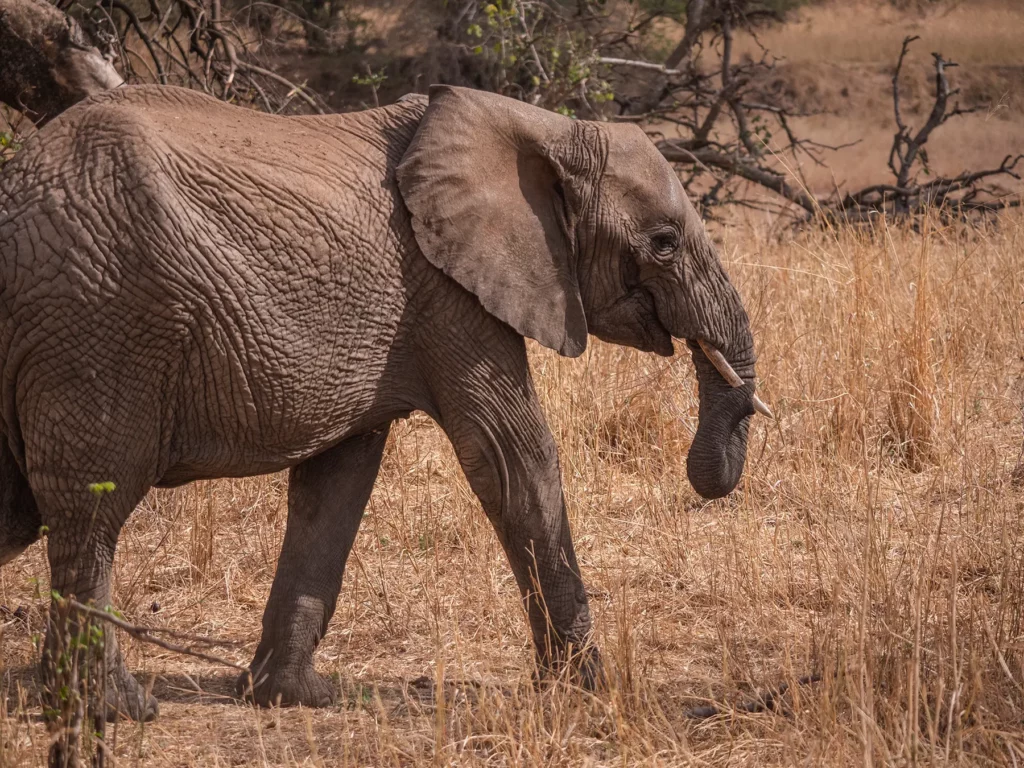
What’s The Safest Way to Travel Tanzania?
Safari trucks tend to be very safe as they don’t travel particularly fast and the driver guides normally drive very carefully.
Road accidents can occur in Tanzania, often involving the overcrowded small minibuses used by the locals.
Some roads aren’t well maintained, although you should be fine travelling between cities and national parks on the main tourist routes.
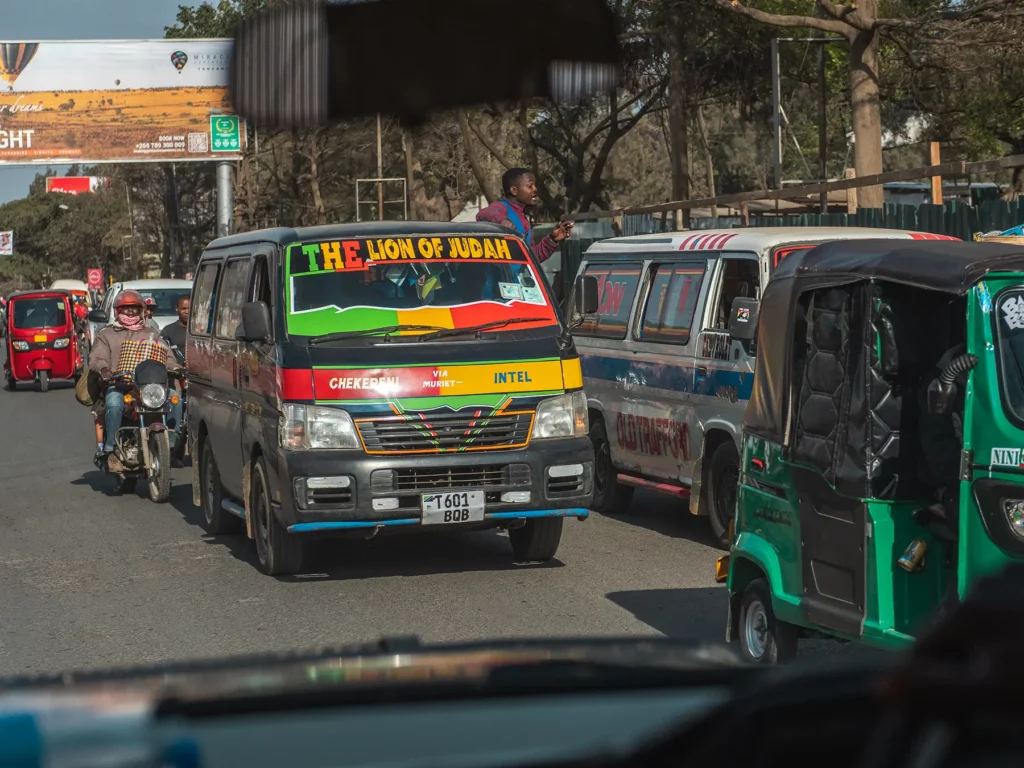
If you’re visiting during the wet season, be aware that the sudden downpours can cause dangerous driving conditions and restrict visibility.
However, avoid travelling after dark where possible and take care, especially if you’re self-driving.
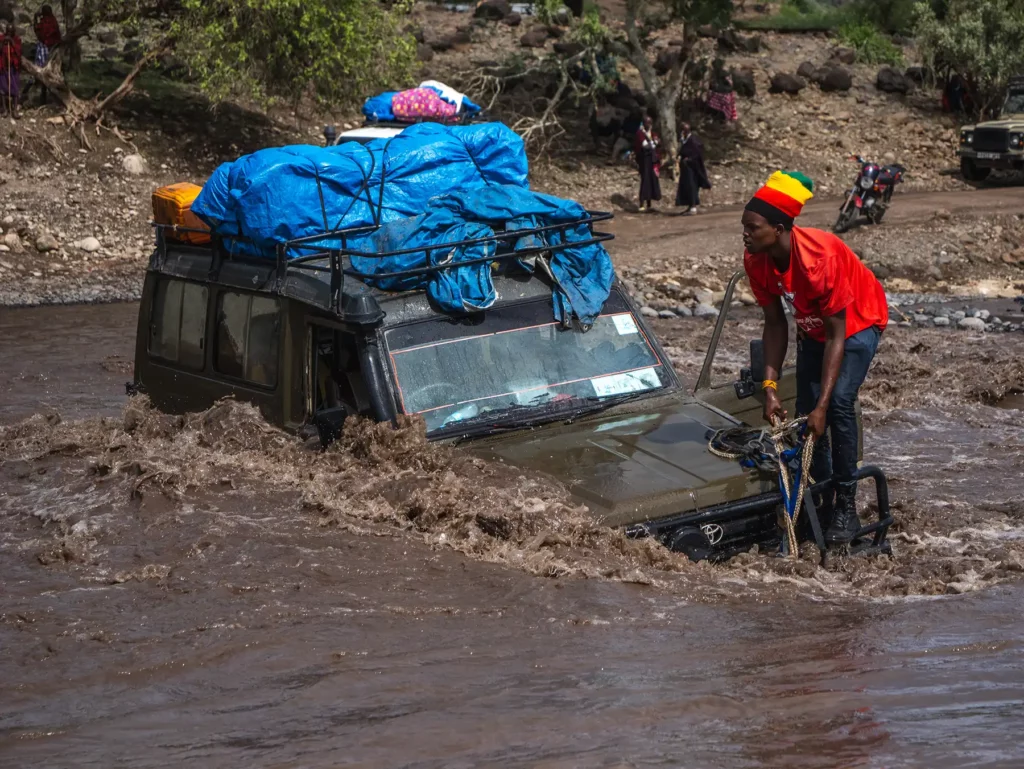
Transfers as part of luxury safaris to national parks like Tarangire are sometimes taken by plane, usually a small light aircraft like a Cessna Caravan. The safety record for these small planes is extremely good.
Most hot air balloon flights run smoothly and safely, but there is always a small element of risk. Usually the risk occurs with hot air balloons when tourists pressure the operator to fly in windy conditions against the guidance of the operator.

Health and Diseases
Whenever you travel abroad, food poisoning is a possibility, especially in more rural areas or local markets where hygiene standards fall below those that you’re used to at home.
However, the lodges and camps in Tarangire have been set up to cater for tourists and take many precautions to ensure your meals and made to western standards.
As a general rule, if you have a sensitive stomach stay at mid-range or luxury accommodation rather than a budget one to play it safe with the foods you eat. Seafood (including fish), salad and ice cubes may not be the safest option if you have a sensitive stomach.
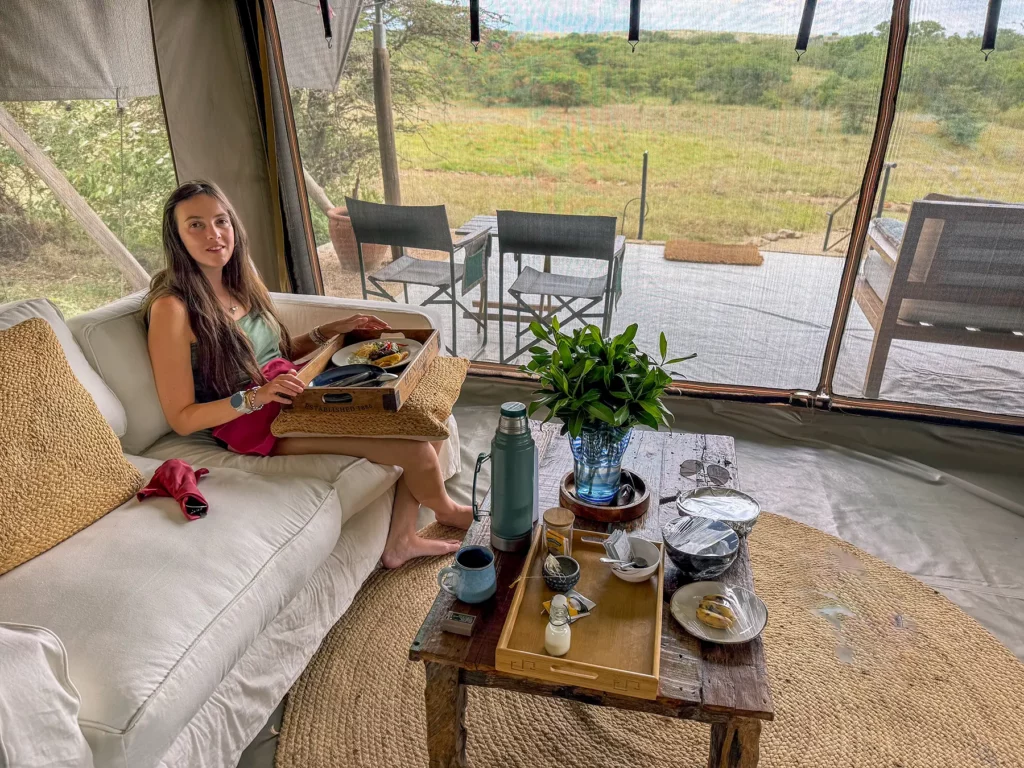
Mosquitoes and tsetse flies are prevalent during the wet season, so use insect repellent and wear long clothing to protect yourself. It’s best to avoid dark colours at this time of year.

Is Tarangire a Malaria Area?
Yes, malaria is present in Tarangire National Park, with the risk being highest during the wet season. It’s best to consult your healthcare provider before your trip to discuss the most suitable preventative malaria medication.
I have generally had very little problems with mosquitos on safari game drives but I do take antimalarial tablets as a precaution as well as carrying some mosquito repellant in my luggage.
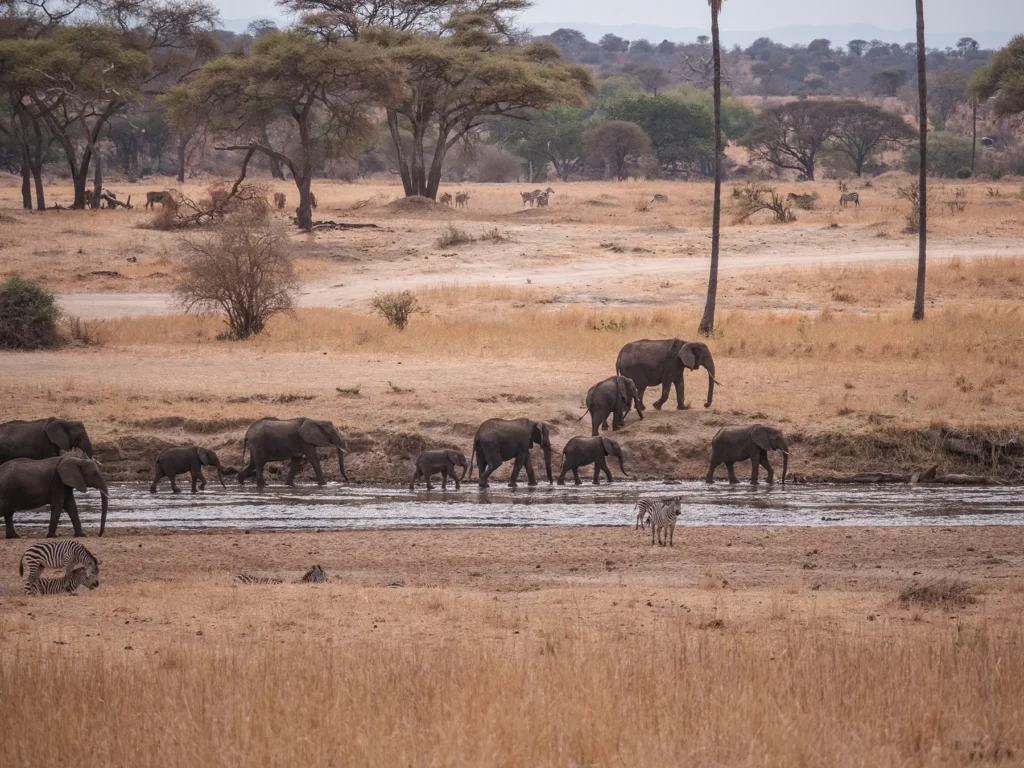

Embark on the Safari of Your Dreams
Save time and ensure an incredible safari experience by getting quotes from my recommended local safari companies
I’m here to make booking your perfect safari quick, easy and risk-free.
Join the rapidly growing tribe of over 1,000 travellers who’ve booked their dream safari using my insider tips and recommendations.

It takes under 60 seconds to fill out the form and in under 48 hours you will receive multiple, no-obligation proposals from my favourite local tour operators with glowing online reviews.
Get your free no-obligation safari quotes and my top safari tips and recommendations
Things to do in Tarangire
There’s plenty to keep you busy in Tarangire, with activities that go far beyond the traditional game drives. You can explore the bush on foot, or even watch wildlife from a hot air balloon.

Is a Tarangire Balloon Ride Worth it?
Balloon rides in Tarangire offer a unique safari experience, as seeing the park from above gives you a whole new perspective of the landscape. These trips require an early start, but there’s nothing more magical than watching the sunrise over the African plains as you drift leisurely across the sky.
Balloon rides usually last an hour, giving you plenty of time to admire the views. You’ll be able to appreciate just how vast Tarangire is from this height, and it’s easy to spot the animal herds from up here too.
After your flight, you’ll usually finish the experience on a high by tucking into a champagne breakfast out in the bush. This is a wonderful way to toast your adventure while surrounded by nature.
Bad weather can cause balloon rides to be dangerous, so there’s a chance that your flight may be cancelled. If this happens during your trip, it’s important to trust the local operator’s decision, as they make it with your safety in mind. To avoid disappointment, try to book your flight at the beginning of your stay, in case it has to be postponed.
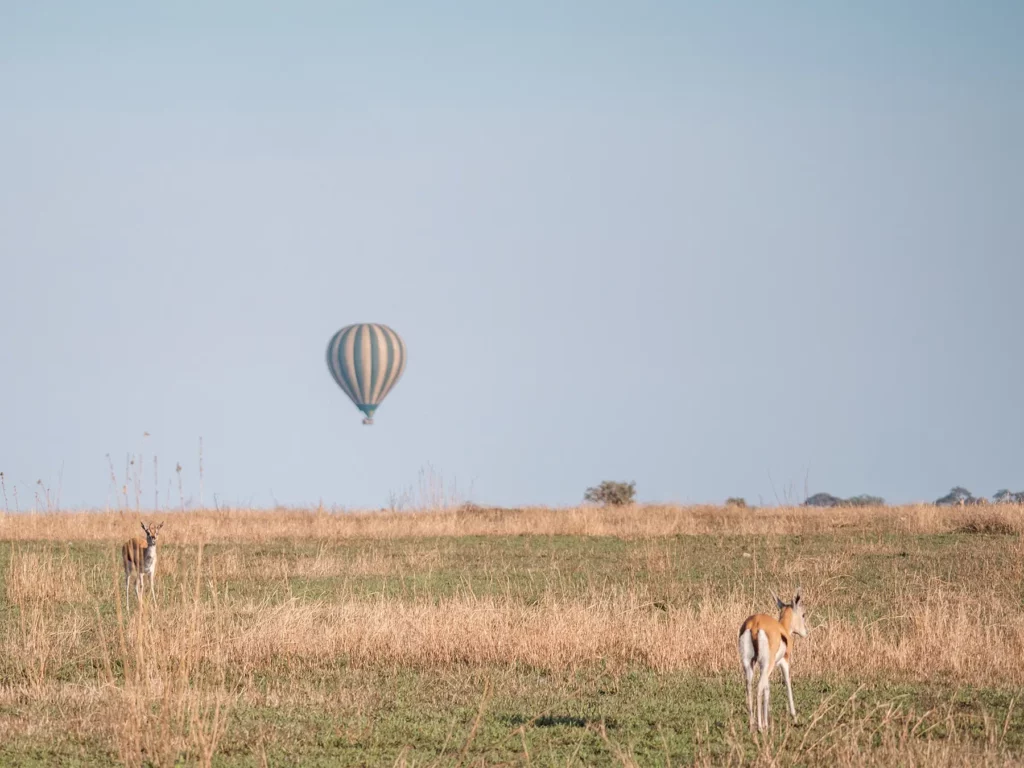
Can You Go on A Walking Safari in Tarangire?
Yes, Tarangire is a great location for a walking safari. Exploring the landscapes on foot and following animal tracks to search for wildlife will make you feel like you’re immersed in the heart of the wilderness.
Accompanied by an experienced guide, you’ll have a chance to learn about the local environment from close range. You’ll also likely see several things that you’d normally miss on a game drive, as walking safaris leave animals undisturbed.
The best time for walking safaris is during the early morning or late afternoon when more animals are out and about. Temperatures are cooler then too, making the experience more pleasant.
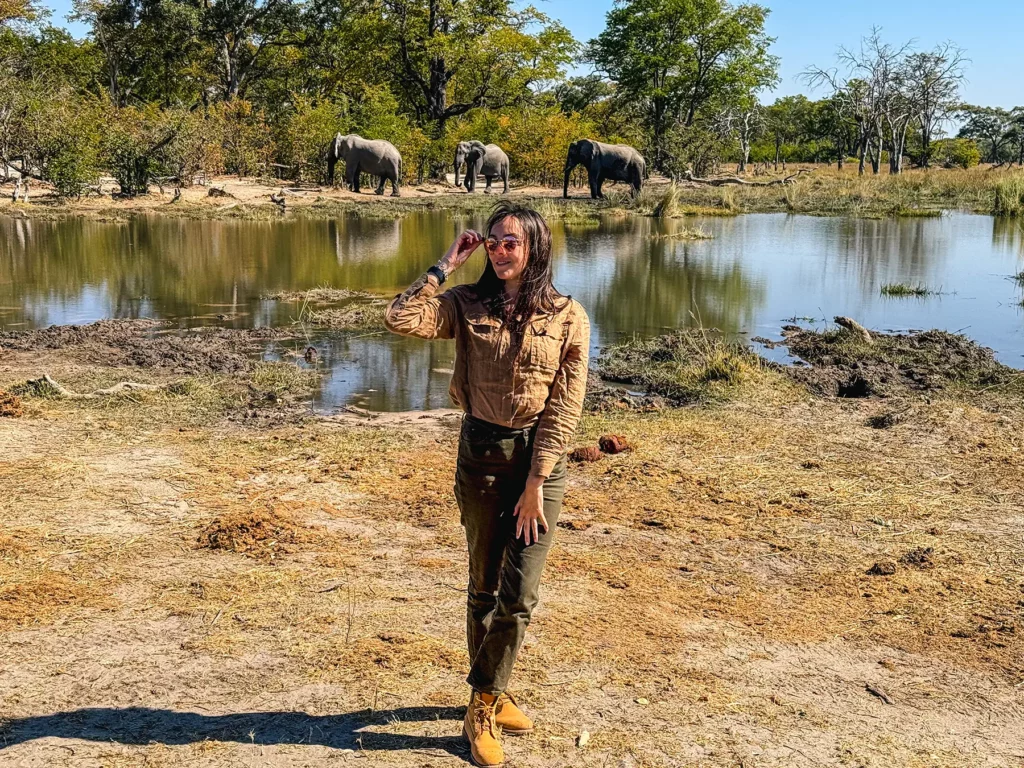
Can You Go on Night Game Drives in Tarangire?
Night game drives are usually conducted in partnership with lodges or camps located within the park or its boundaries so if this is something of interest, you’d need to let your safari company know so they can suggest accommodation which offers this activity.
Night game drives are special as you’ll potentially see nocturnal animals which are rarely seen during daylight hours. You’ll head off in the evening as dusk falls, armed with blankets and powerful torches to pick out the wildlife. In the black of night, another side of the park comes to life. Keep an eye out for porcupines, genets, bush babies, and leopards.
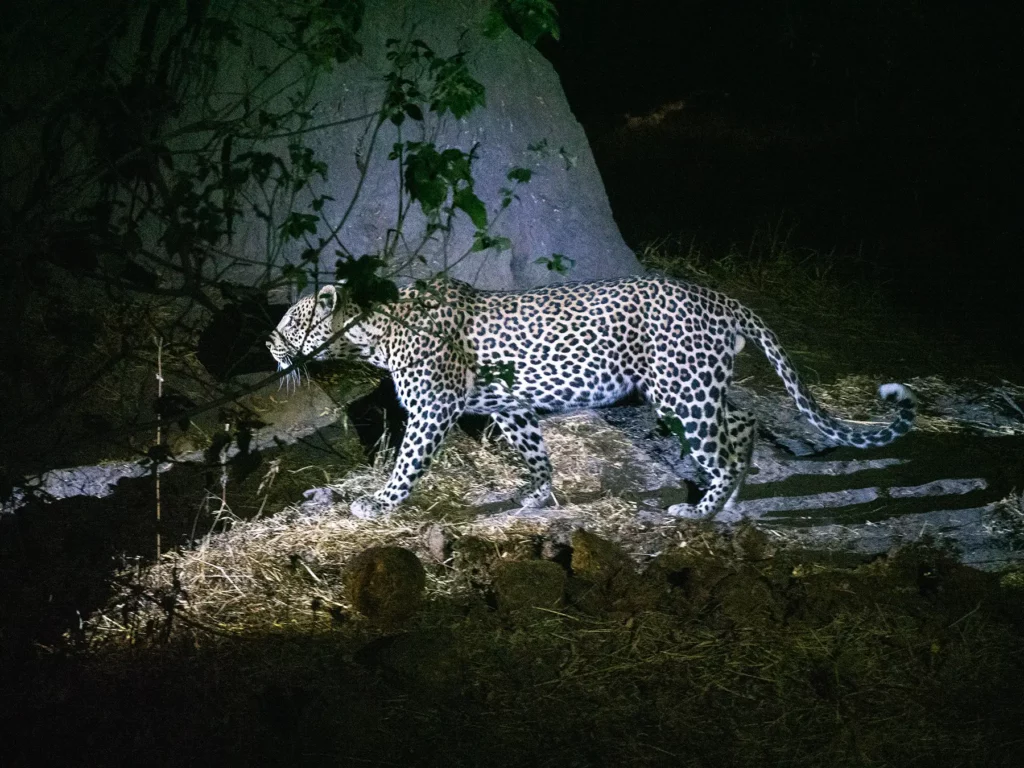
Photographic Safari in Tarangire
Tarangire is a popular destination for photography safaris, thanks to the varied landscapes, abundant wildlife, and diverse vegetation. Photographers come here to snap the ancient baobab trees and the large elephant herds trundling across the iconic African plains.
The best time for photographic safaris is during morning and evening game drives, as these offer the best light conditions when the sun isn’t directly overhead. During these times, there is plenty of shadow present, which can really enhance a wildlife shot and give it some depth.
You’ll be able to photograph the animals from all angles down at the Tarangire River, especially if you visit in the dry season. Wildlife here is prolific and easy to spot, so you’ll have no problem getting those perfect shots of tussling buffalos, grazing wildebeest, or even a pride of hunting lions.
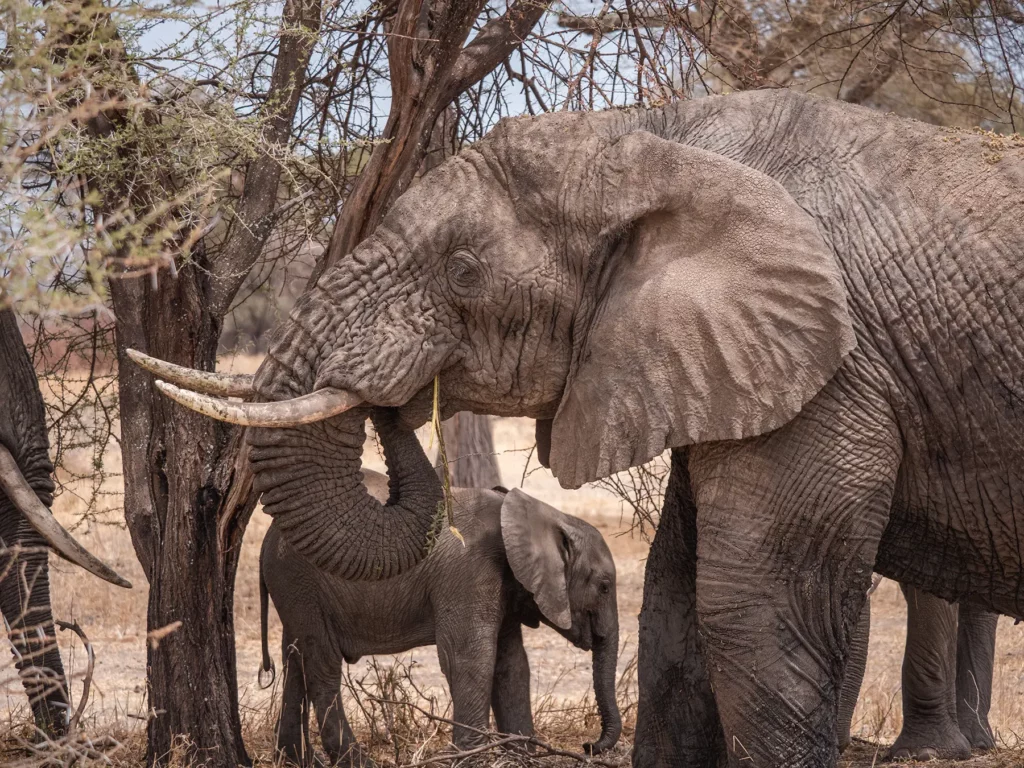
Can You Go Fly Camping in Tarangire?
Yes, fly camping is one of the most adventurous safari activities that Tarangire offers.
If you’re not familiar with fly camping, it essentially involves heading off on a walking safari, and then staying overnight in the bush (rather than in one of the permanent lodges or campsites).
You’ll set out on foot with a guide and an armed ranger, and the temporary camp will be set up for you in advance. Just because you’re camping out in the wild doesn’t mean you have to forgo your creature comforts! Bucket showers and short-drop toilets are usually provided, as well as delicious meals and mattresses to sleep on.
After spending the day looking out for local wildlife, you’ll spend the evening swapping stories around the campfire beneath the twinkling stars. It’s an intimate experience, and you’ll learn a lot about nature as well as local culture as you chat with your guides.
It’s important to note that fly camping is a specialised activity requiring permits and is usually arranged through licensed safari operators.
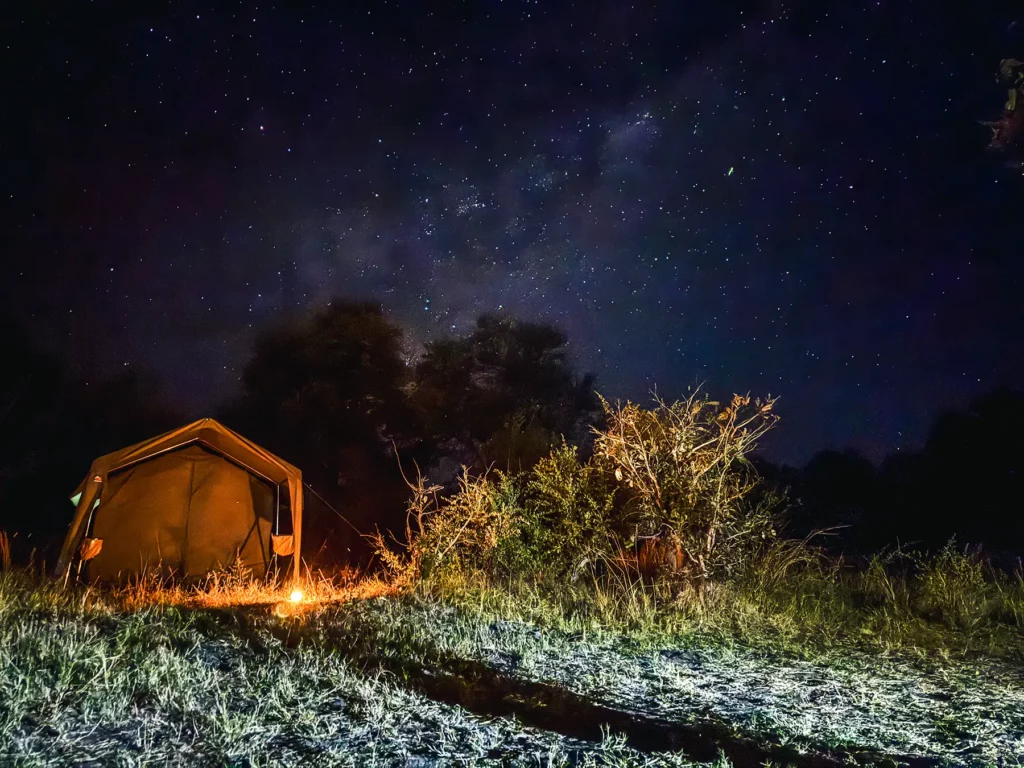
How to Book Your Tarangire Safari
You have four main options to choose from when booking your safari in Tarangire National Park. I’ve written about the pros and cons of each below to help you decide on the best option for you.
You can jump to more information on each of the booking options using the links below.
Recommended Booking Options For Your Tarangire National Park Safari Itinerary
Private Safari
Most popular & best experience – typical prices for this itinerary start from $300 per person per day.
Visit safarisbyella.com for free quotes from trustworthy local tour companies I use to book my own trips.
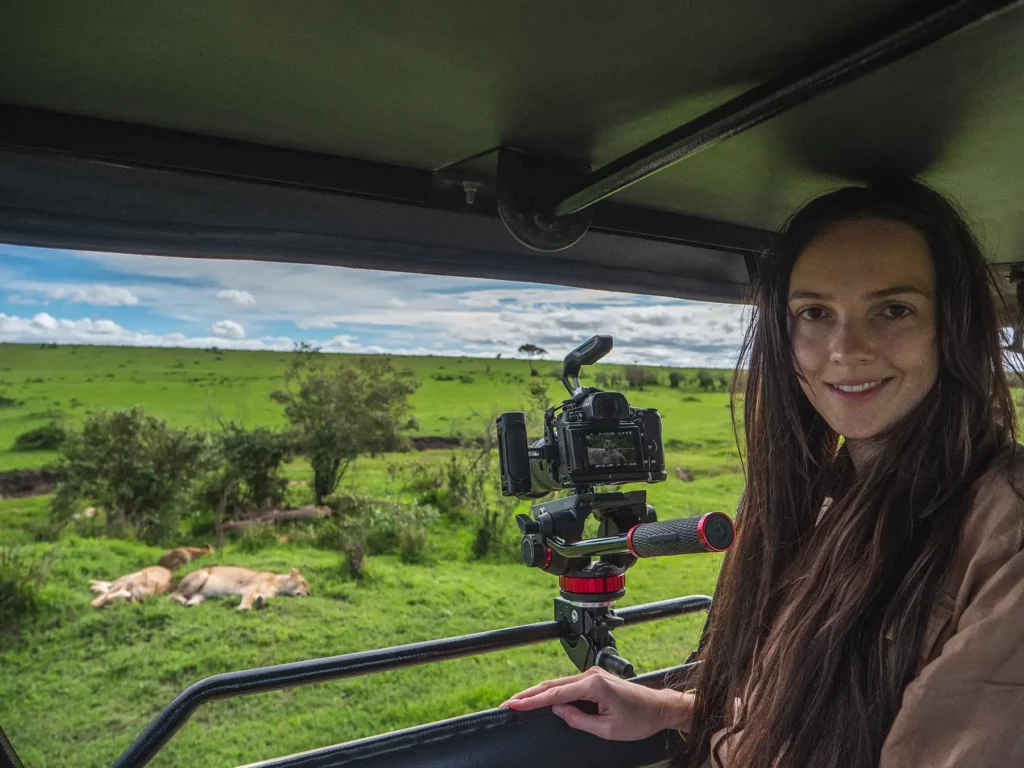
Group (Shared) Safari – Usually Camping
Good for budget or solo travellers – from $200 per person per day.
My recommended Tanzania tour operators only provide private safaris, however, I’ve listed the best and most similar group options for this itinerary, on SafariBookings below.
These group options include Tarangire National Park as part of their safari itinerary
Click the link below to request quotes for the group safari options on the SafariBookings website.
4-day Group Budget Safari Including Tarangire
5-day Group Budget Safari Including Tarangire
8-day Group Budget Safari Including Tarangire
View All My Recomended Group Options Following a Similar Itinerary
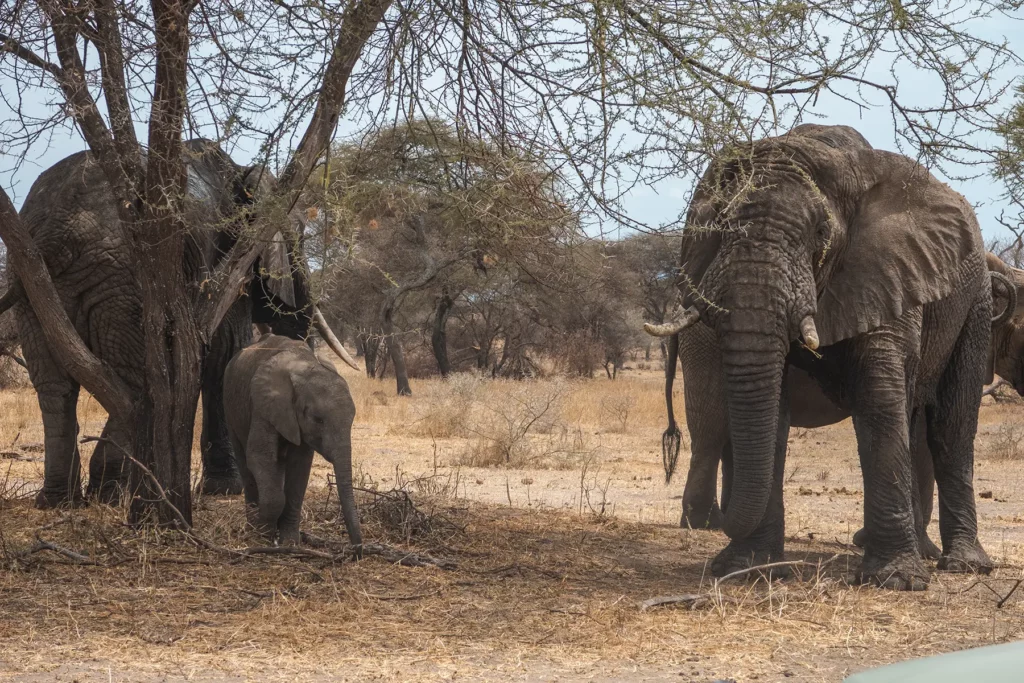
Option 1: Self-Drive Safari
Self-driving safari is an option in Tarangire and they can be cheaper than a traditional safari as you’re saving the cost of the driver guide.
On the downside, while it might sound fun driving independently around the park, most of us aren’t great at spotting wildlife without a guide or the live information network they have access to via phone and radio, so you’ll probably miss out on important sightings. The guides know all the best spots and are a mine of information about the wildlife, with lots of facts and anecdotes not found in guidebooks.
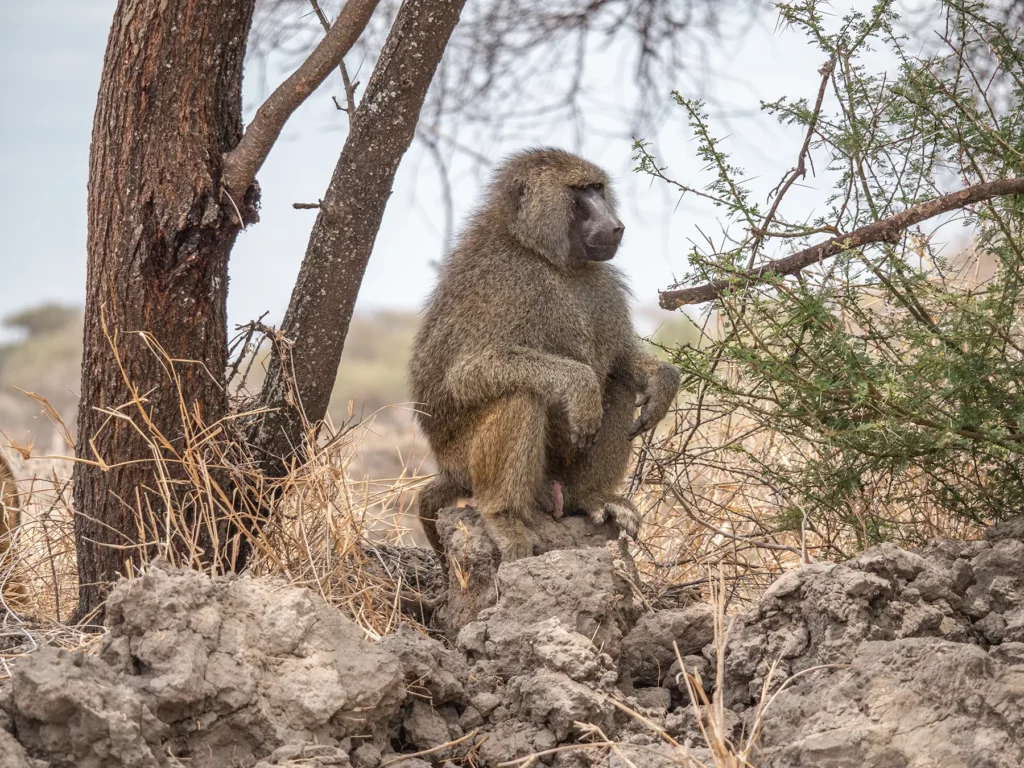
Tanzania is very strict in terms of the types of self-drive safari vehicles they allow into the parks and I’ve heard of even certain 4×4 vehicles being turned away if they are not safari-grade.
Another thing to consider is all the added expenses. If you’re choosing to self-drive as it seems like a cost-effective option, then be mindful of adding things like park fees, food and accommodation, and vehicle entry fees. These costs are usually included in the price of package safaris, so don’t forget this when comparing rates for different types of trips.
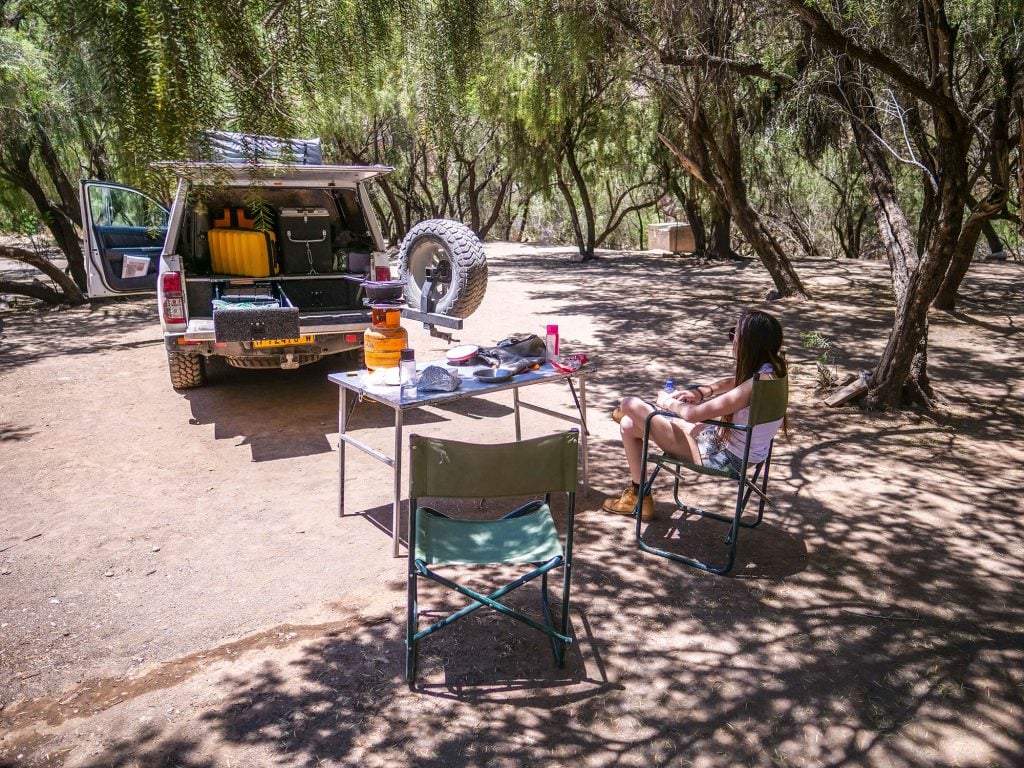
In addition to this, if you book accommodation independently, you won’t be eligible for discounted rates, which are often made available to safari tour operators. This means that your room could end up costing you more by booking directly.
It’s also important to be aware that self-driving in national parks can be stressful. The roads can be rugged and difficult to navigate, so you could get lost. By having to concentrate on driving, you may also end up missing key animal sightings.
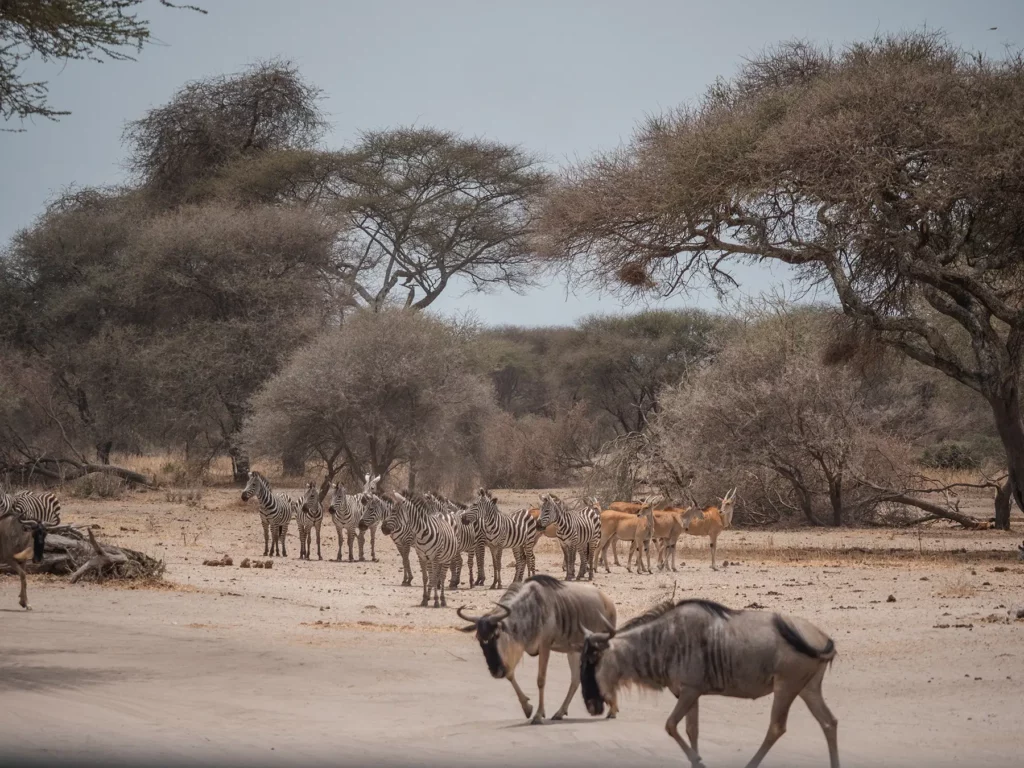
Whilst I love self-driving in places like Namibia, where safari was only a smalI part of the trip, I don’t recommend this type of holiday in Tarangire. Your experience will usually be far richer with a local wildlife expert taking care of the driving and putting in the work finding you the best sightings and helping you make the most of your safari.
How to Book a DIY Self-Drive Tanzania Safari
- Option 1: Comparison sites which provide multiple quotes from verified suppliers such as Safaris By Ella. Make sure to write you want to self drive in the notes when requesting a quote. (This is a hybrid approach where you’ll drive yourself but they will arrange everything)
- Option 2: Research and book all elements of the trip yourself using Google and online travel agents.
Join the rapidly growing tribe of over 1,000 travellers who’ve booked their dream safari using my insider tips and recommendations. Get your free quotes and my top tips and recommendations now.
Option 2: Local Tour Operator
After years of going on safari in many countries across Africa, my preferred option is booking with a local tour operator. They arrange all the logistics of your trip, from accommodation and activities to transfers and park fees. It’s a seamless and hassle-free experience. You’ll only need to arrange your international flights and any required visas, which can be done online.

With local operators, you have direct access to ground experts who can tailor a trip to your exact requirements – after all, these people know the area better than anyone else! Local companies also don’t have huge overheads like international travel agents, so this is usually a much cheaper option without the hefty mark-up fees.
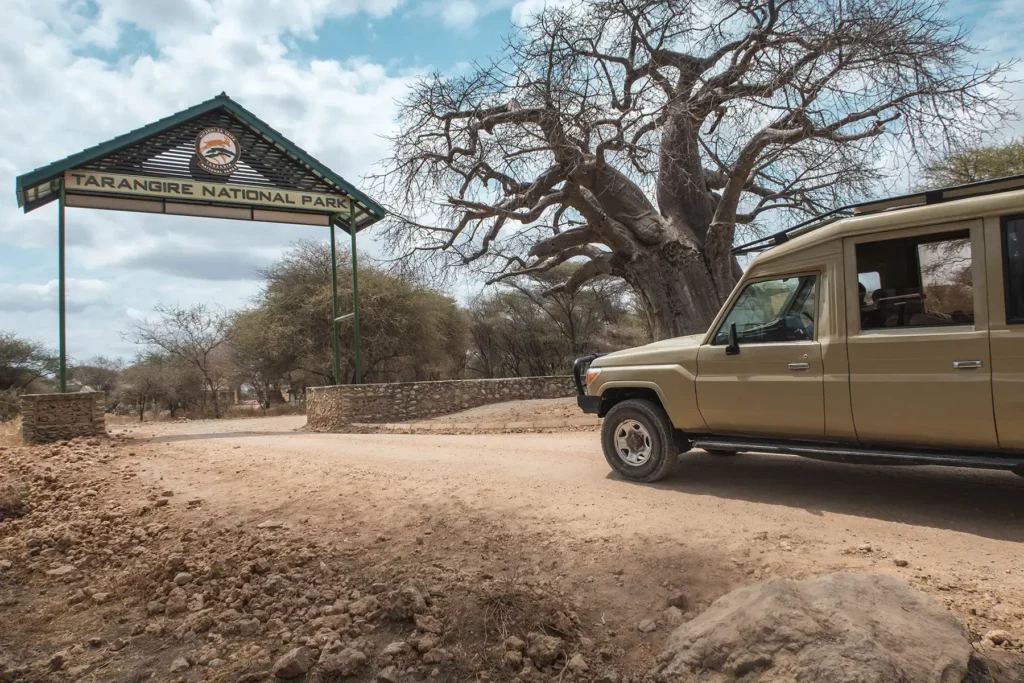
Both private and group safaris can be organised through local tour operators, with the former being the best option if your budget allows. Private trips offer greater flexibility, with customised itineraries to suit your personal preferences.
How to Book with the Best Local Safari Companies
- Comparison sites which provide multiple quotes from verified suppliers such as Safaris By Ella
Join the rapidly growing tribe of over 1,000 travellers who’ve booked their dream safari using my insider tips and recommendations.
Option 3: International Travel Agents
Many travellers like to book their safaris through a trusted international agent, often using the same company to arrange all their holidays. By booking trips through international travel agents you may have an extra level of financial security should anything go wrong.
Additionally international travel agents can usually book the whole trip including international flights.
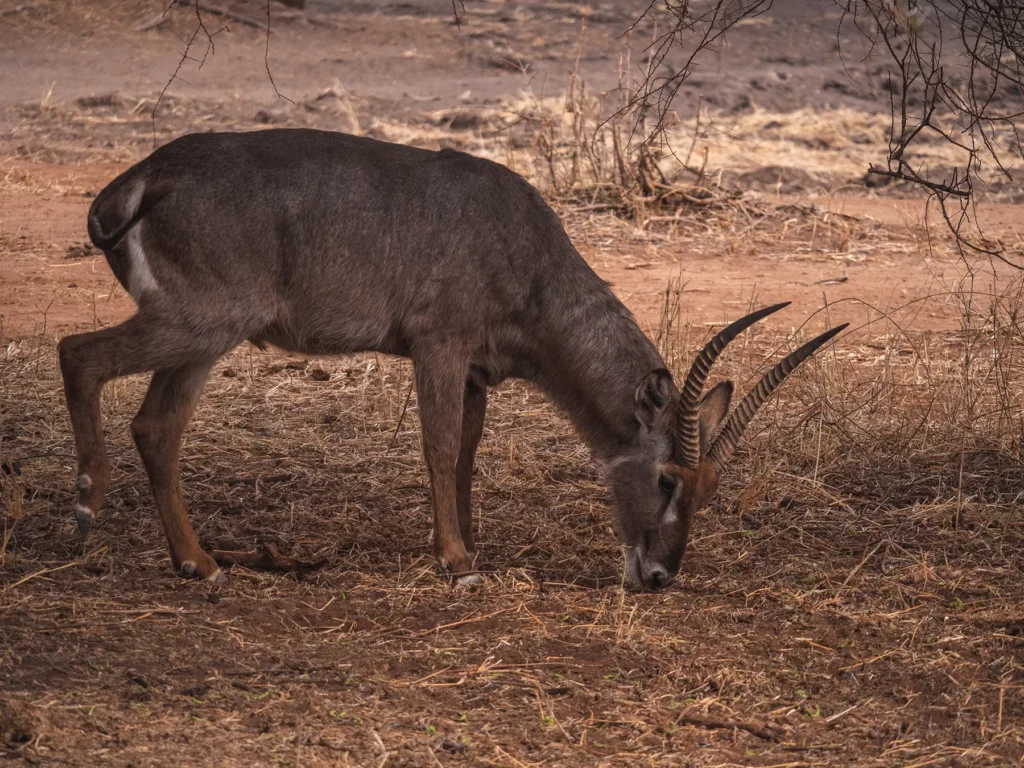
Despite these advantages, booking with international agents is often far more expensive than going with a local operator. Global companies have much larger overheads to cover, and these expenses will be passed on to you!
Agents also typically subcontract the actual safari to local providers, so your safari experience will be the same as whoever you book with. You’ll just pay far more if you’ve gone via an agent.
How to Book Your Safari with an International Travel Agent / Safari Company
- Comparison sites which provide multiple quotes from verified suppliers such as Safaris By Ella. When you select a luxury budget on the quote request, you will receive a quote from my recommended International safari company as well as my recommended local companies for comparison.
Join the rapidly growing tribe of over 1,000 travellers who’ve booked their dream safari using my insider tips and recommendations.
Option 4: Hotel Safaris
Fly-in hotel safaris are a great choice if you want to base yourself at a single hotel during your holiday. The game drive and activities are typically organised directly through the hotel.
It’s usually a lot more expensive to book a safari like this and you might not want to spend your whole time at one lodge in Tarangire.
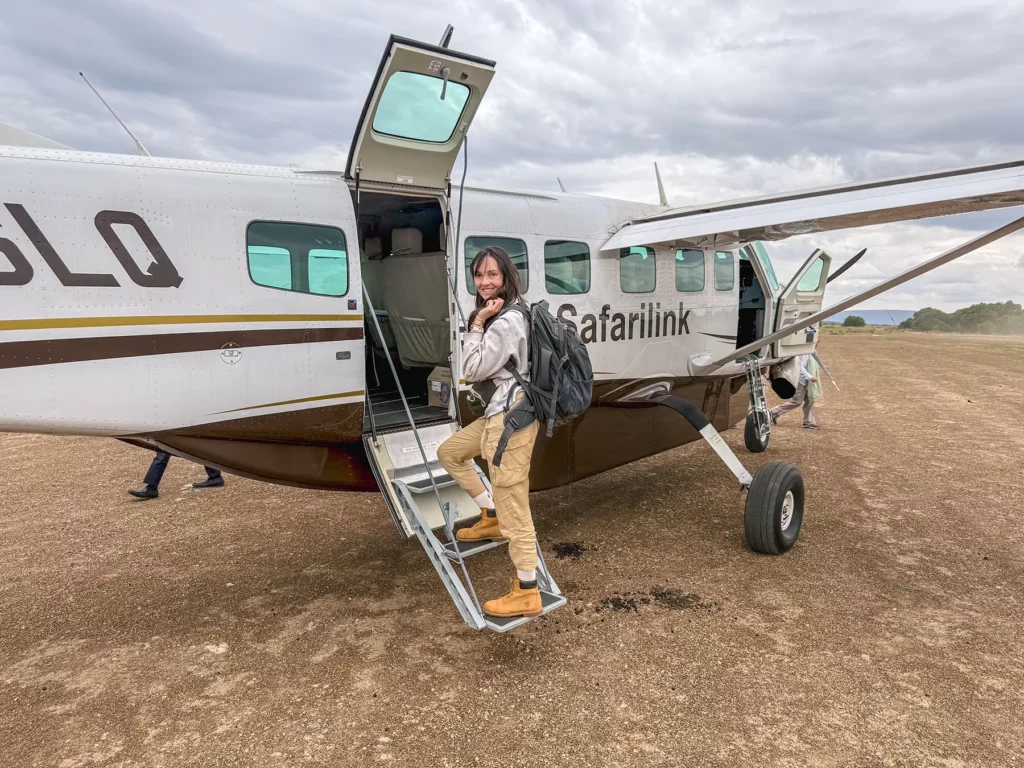
Most Tanzania safari itineraries to Tarangire also include the Ngorongoro Crater and Serengeti National Park. If you want to do a multi-destination trip in northern Tanzania, it’s almost always more cost-effective to book a package through a local operator. They’ll have access to better room rates too.
In a nutshell, fly-in hotel safaris are a good option if you plan to spend a prolonged time in one location but can work out very expensive, particularly if you plan on taking in other destinations too.
How to Book a Hotel-Provided Safari
- Option 1: My recommended tour operators on Safaris By Ella can arrange hotels and air or road transport to and from the hotels. If you opt for the more cost-effective road transport, since they have driven you to the hotel, you might find it cheaper to use the safari company for safaris rather than using the hotel-provided safaris.
- Option 2: Check with your chosen accommodation whether they provide this service and the booking requirements.
Tarangire Safari Prices
How Much Does a Tarangire Safari Cost?
Tarangire National Park fees are the cheapest of the three most popular parks in Tanzania. Let’s dig into the figures below.
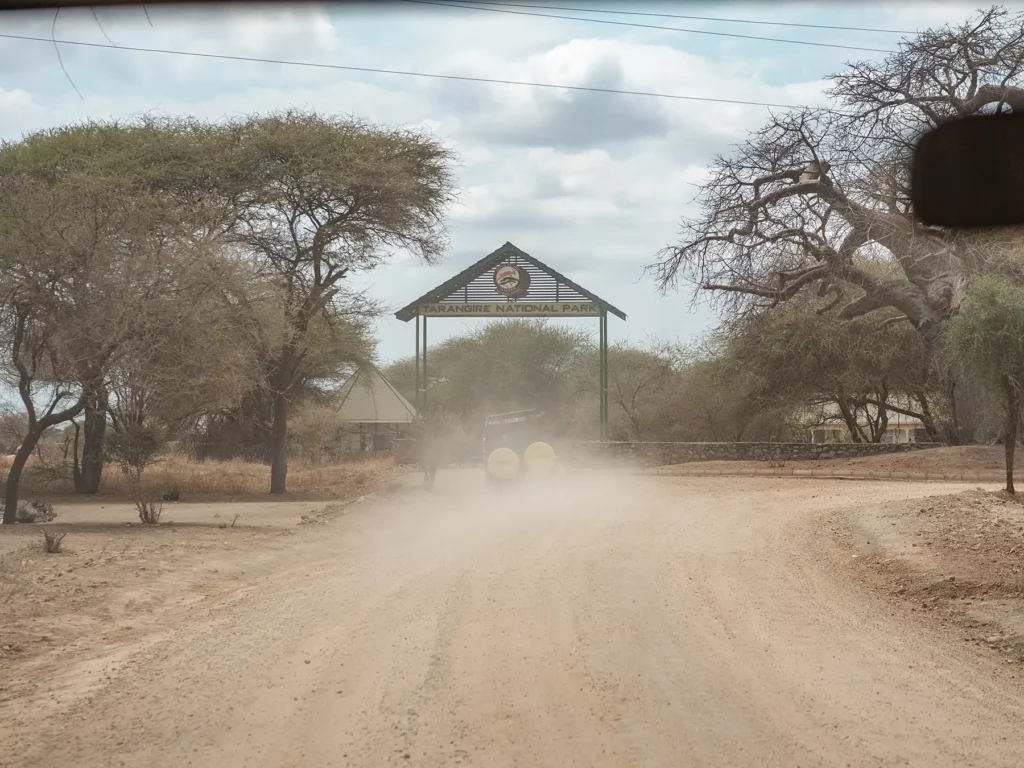
How Much Does It Cost To Enter Tarangire?
Tarangire National Park entry fees are $50 per adult and $15 per child. (Adult fees are reduced to $45 during the low season, from 15th March to 15th May).
All included (besides international flights, visas, and trips) you can expect your visit to cost from $250-300 per adult per day, though of course luxury travellers may be tempted to spend far more than that! A mid-range, private safari usually begins from around $400 per day.
Most activities will be included in your tour, presuming you’ve booked a safari package in advance with a local operator or travel agent. Otherwise, you’ll have to pay extra for these. Similarly, accommodation costs can be really varied here depending on whether you’re looking for a basic camp, mid-range lodges, or luxury services.
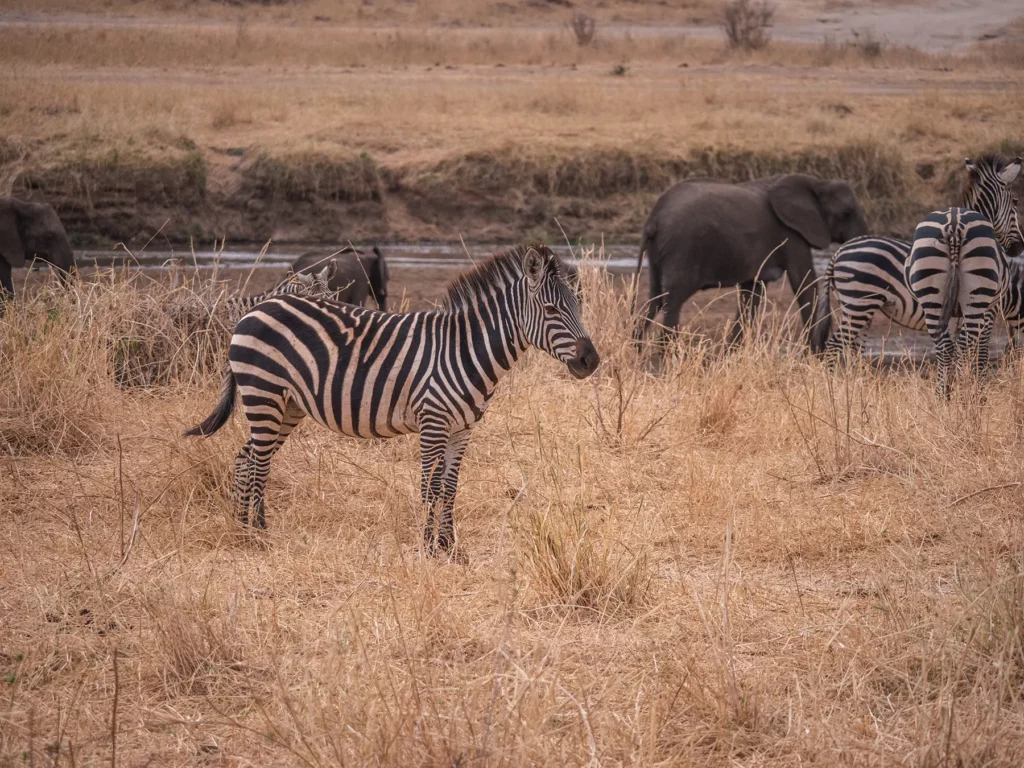
Is a Tarangire Safari Worth it?
Definitely! While the Serengeti and Ngorongoro Crater may be more famous, Tarangire offers an equally rewarding and well-rounded safari experience at a lower cost.
Tarangire National park boasts Tanzania’s largest elephant herds, so it’s one of the top locations in Africa to see these gentle giants.
The park is on the way to Ngorongoro Crater and the Serengeti so it’s a no-brainer to pay a visit on your way to or from Arusha.
Tarangire is also a great place to experience a walking safari as it’s one of the few parks which allow this along with Arusha National Park. Serengeti and Ngorongoro Crater (the crater floor specifically) don’t currently allow walking safaris.
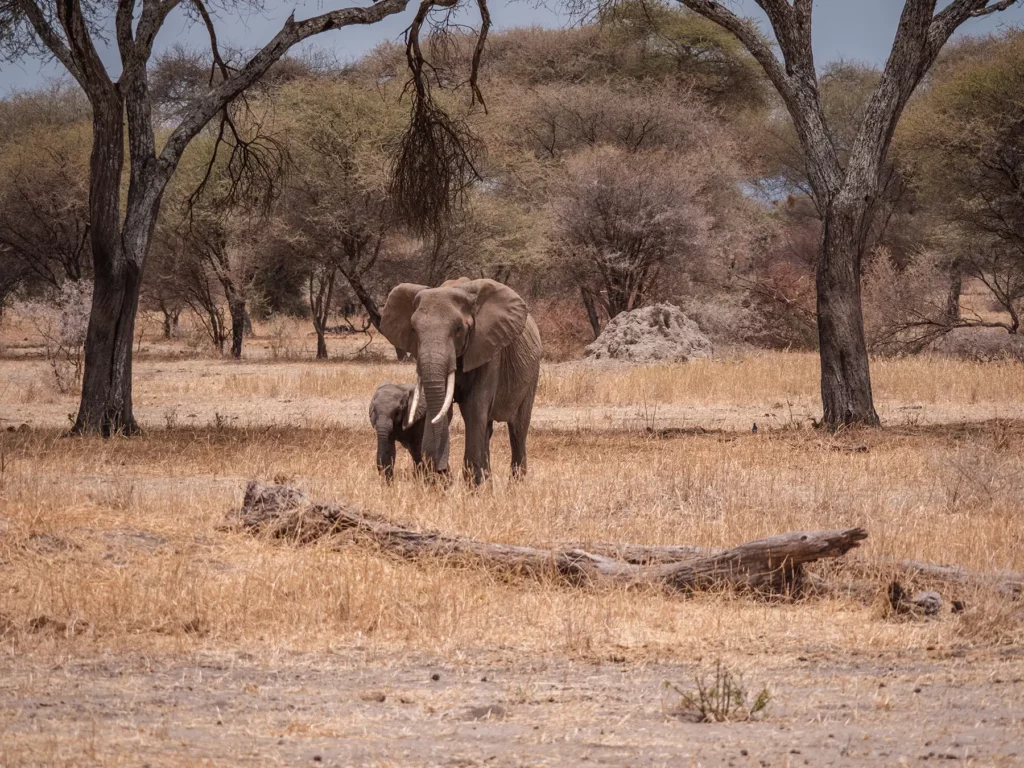
Where to Stay in Tarangire
There’s a variety of accommodations to choose from in and around Tarangire, including permanent lodges, tented camps, and public campsites. Below we’ll delve into the different options in more detail so you can make the right accommodation choice for your Tarangire safari.
Safari Lodges & Hotels
The first option is staying in a permanent structure with solid walls. These are often referred to as lodges or hotels. There are a couple of lodge options in and around Tarangire.
Tarangire Safari Lodge offers bungalows or thatched tented suites and is popular with guests looking for traditional wilderness immersion. It sits on a clifftop about 6 miles inside the park gate and offers a swimming pool and unrivalled views of wildlife along the Tarangire River.
Also inside the park is the Lemala Mpingo Ridge Lodge, which is beautifully positioned on top of an escarpment with sweeping river views. There’s an infinity pool for relaxing in the afternoons and outdoor bathtubs so you won’t miss a thing out on the plains, even when enjoying a soak.
For ultimate luxury, Tarangire Treetops is located in a private reserve adjoining the park. The lodge is constructed around a huge baobab tree with rooms that boast superb views of the Tarangire plains.
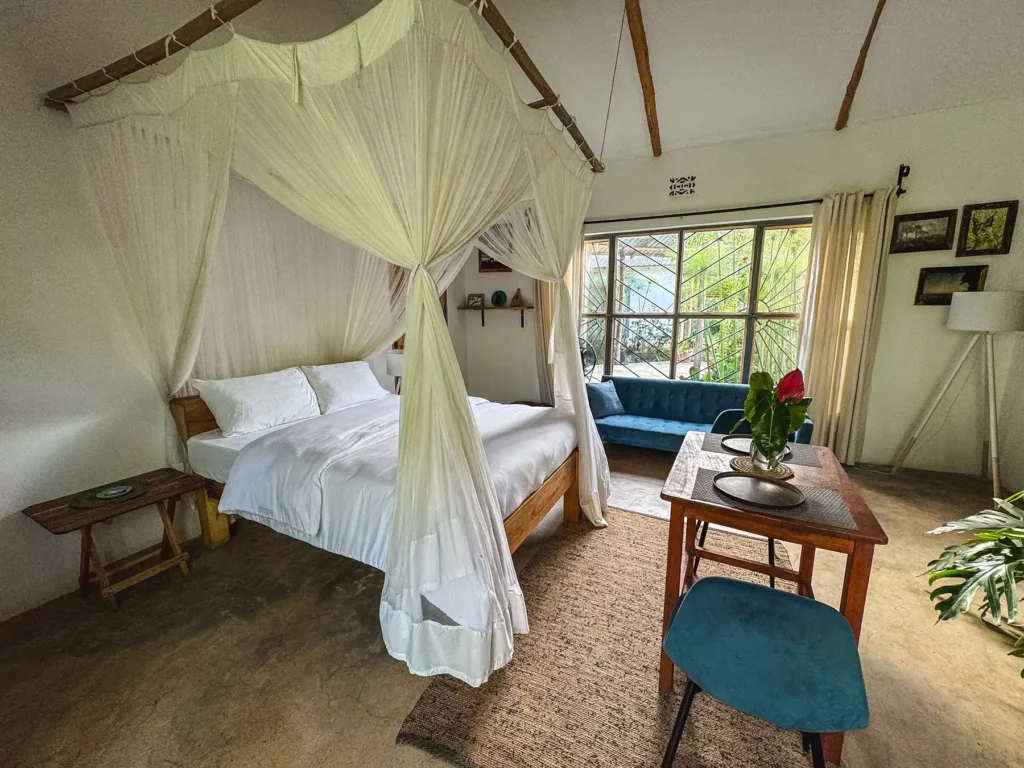
Safari Camps
Tented camps or safari camps differ from lodges in that they are often made of canvas rather than solid walls. This allows you to feel closer to nature and have the ultimate Out of Africa experience. They’re certainly no less luxurious than lodges and are often more exclusive. They’re my personal favourite option.
You’ll find Oliver’s Camp in the heart of Tarangire National Park, not far from the Minyonyo Pools. It’s a comfortable and stylish camp with a traditional vibe and comes with personalised service and starlit dining.
Sanctuary Swala Camp is also deep within the park, so by staying here you’ll be in the heart of the action. The canvas-tented rooms are lavish, with great savannah panoramas and a watering hole that attracts elephants.
Another property in the park is Maweninga Camp which enjoys a spectacular setting up on a granite outcrop. It overlooks Lake Manyara and on clear weather days, you can even see Mount Kilimanjaro.
Meanwhile, Nimali Tarangire is a permanent and intimate tented camp just outside the park’s northern border. The comfortable rooms provide sweeping vistas of the reserve and there’s a great selection of safari activities to enjoy.
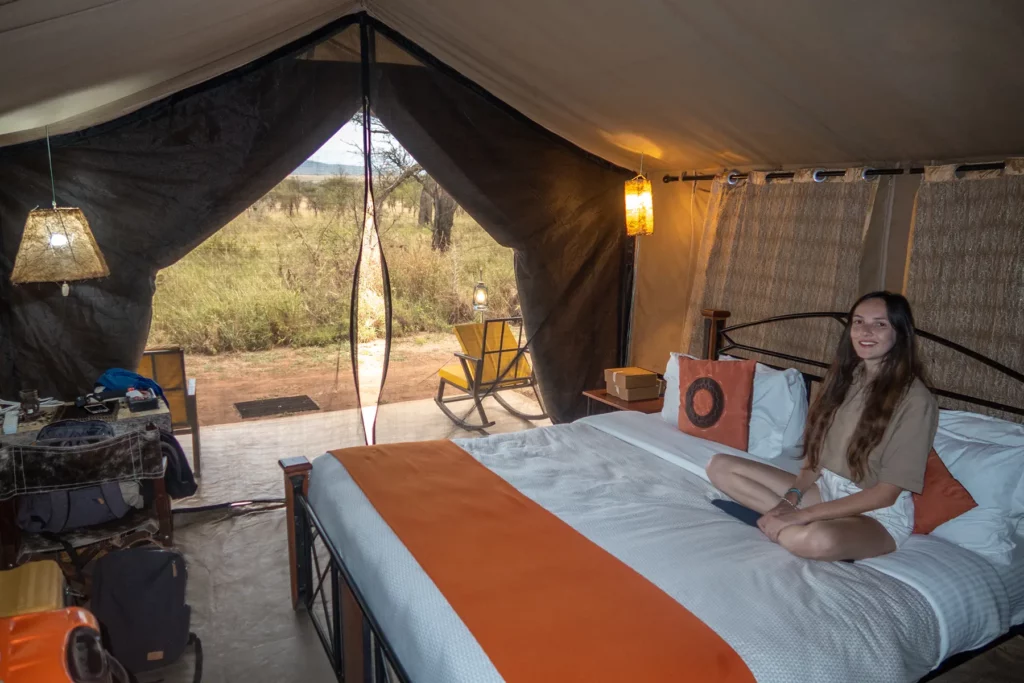
Camping
The third and final accommodation option is basic ground camping. You’ll pitch your tent on a vacant spot here, roll out your sleeping bag and share a communal bathroom.
For budget camping, the Tarangire Public Campsite No.1 is your best bet. It’s situated inside the park, about 3 miles from the entrance gate and headquarters. There are toilet and shower facilities as well as a cooking area, but you’ll need to take your own drinking water and food.
It’s worth noting that public camp sites are not very well maintained.
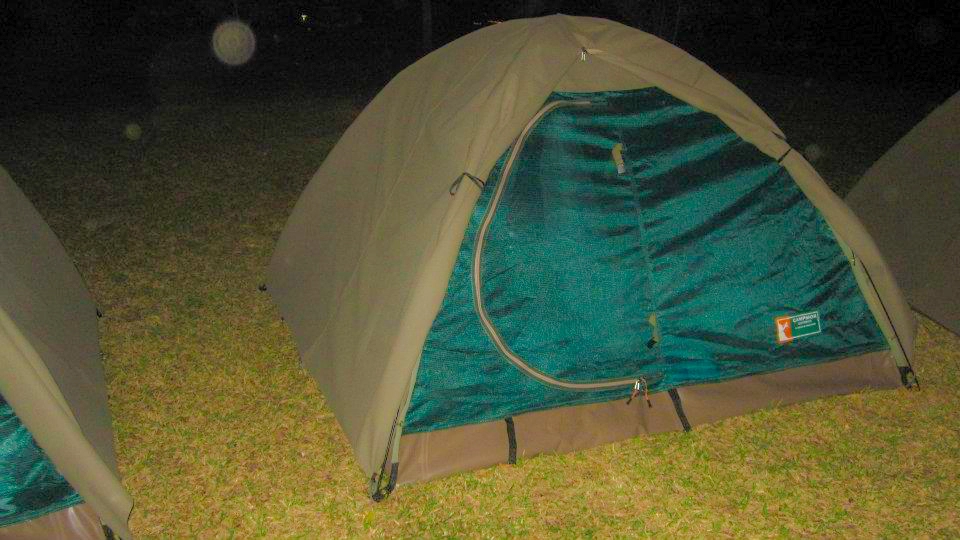
Should I Stay Inside The Park?
The short answer is it’s not strictly necessary to stay in the park in order to have the best experience. I’ll delve into more detail below.
There are several lodges and tented camps within Tarangire National Park and in the surrounding area. You’ll find accommodation for all budgets here, from high-end luxury lodges to a public campsite.
By sleeping inside the park, you’ll have the safari areas on your doorstep and won’t need to factor in travel time. Prices do tend to be higher within the park, but many of the camps and lodges here have wonderful views and are fully immersed in the wilderness. You may see wildlife from your accommodation too – something that you’re less likely to experience outside the park.
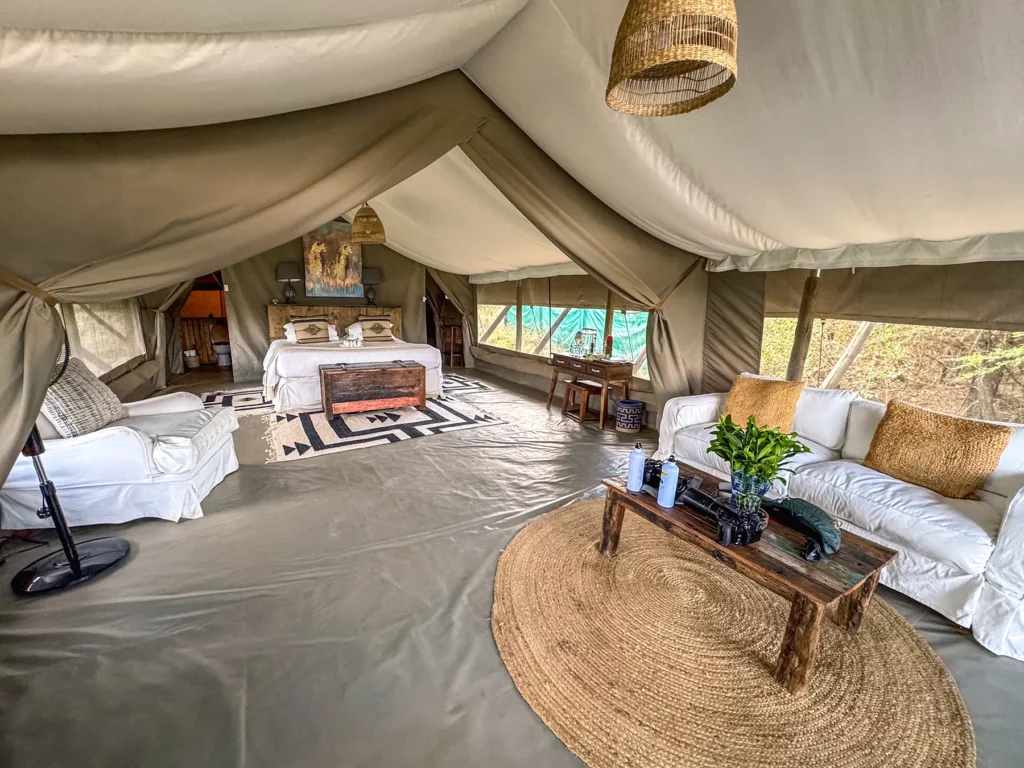
Having said that, it doesn’t take long to reach Tarangire’s gates and the prime viewing areas and so some of the camps and lodges outside the boundary can also be a great option.
Choosing one that’s not too far from the entrance gate avoids spending to much time transferring between your accommodation and the park.
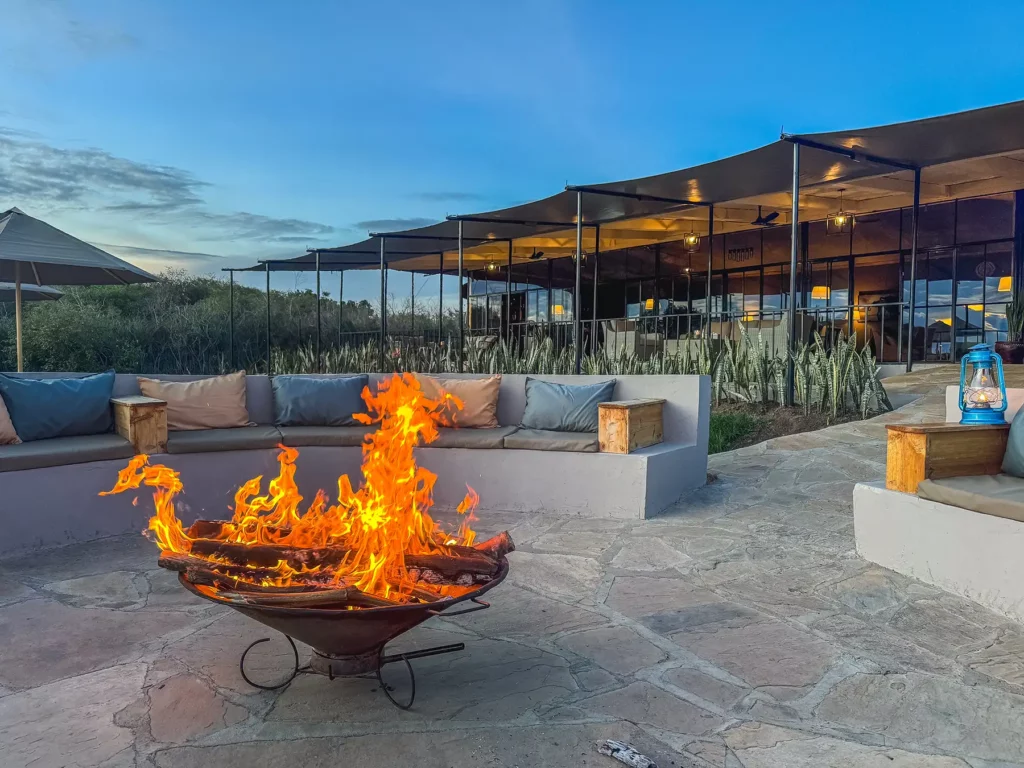
To keep costs down, you can stay in Arusha or Karatu and enjoy day trips into Tarangire National Park. You’ll spend longer travelling between the park and your hotel, but this is a great way to save money on your Tarangire safari.
Often Tarangire is combined with other parks on a longer Tanzania itinerary and in these cases staying in Karatu or on Ngorongoro Crater rim may be the best choice after your Tarangire safari because you’re close to your next location for an early game drive the next day.
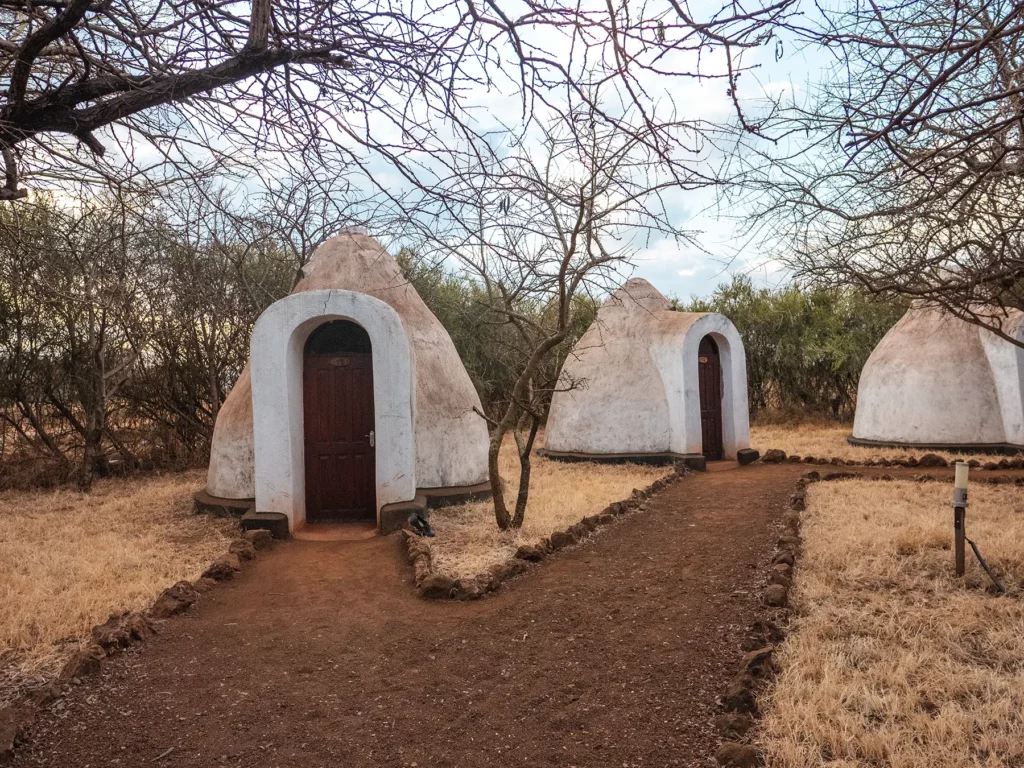
Getting to Tarangire
What City Is Closest To Tarangire?
Arusha is the gateway to safaris in northern Tanzania, thanks to its proximity to Kilimanjaro International Airport. From the city, it’s a mere 87 miles to the national park (roughly 3 hour drive), making Tarangire one of the most accessible safari destinations in the north.

Where Do You Fly To Get To Tarangire?
Most people fly into Kilimanjaro International Airport near Arusha and then take a 3-hour road transfer to the Tarangire National Park entrance gate. This is the cheapest travel option and is very convenient with transfers available throughout the day. However, it’s slower than flying, especially if you’re heading to the south of the park.
For a faster transfer, you can take a 30 minute flight from Arusha or Kilimanjaro Airport to the Kuro Airstrip which is in the south of Tarangire National Park. It’s a scenic route and you’ll get to see the park from above, which is like having a bonus safari before you’ve even arrived!
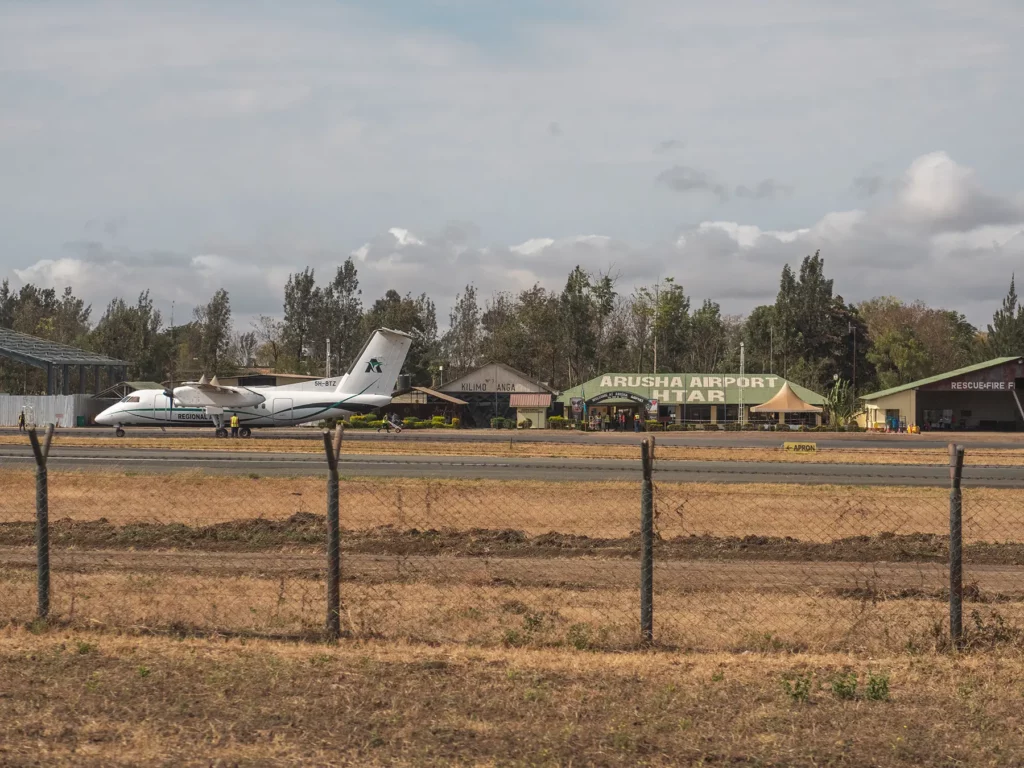
Is Kilimanjaro Close to Tarangire?
Kilimanjaro Airport is the closest international flight hub to Tarangire National Park, which is just over 100 miles away. You can travel to the park by road or take a short domestic flight from either Kilimanjaro or Arusha.
Shuttle Flights To Tarangire National Park Airstrips
There are a few domestic airlines offering flights to Tarangire National Park, including Coastal Aviation, Air Excel, and Auric Air. These flights are usually included if you’ve booked a fly-in safari package.
Flights land at the Kuro Airstrip in the southern part of Tarangire, which is ideal if you’re staying in a lodge or camp in this section of the park.
Kuro Airstrip
The following airlines fly to the Kuro Airstrip from Arusha and Kilimanjaro:
- Coastal Aviation: daily departures from Arusha at 10.45 AM, and Kilimanjaro Airport at 11.15 AM and 3.45 PM.
- Air Excel: daily departures from Arusha at 8 AM, 9.30 AM, and 3 PM, plus departures from Kilimanjaro Airport at 2.30 PM.
- Auric Air: daily departures from Arusha at 8 AM and 10 AM, and Kilimanjaro at 10.30 AM.
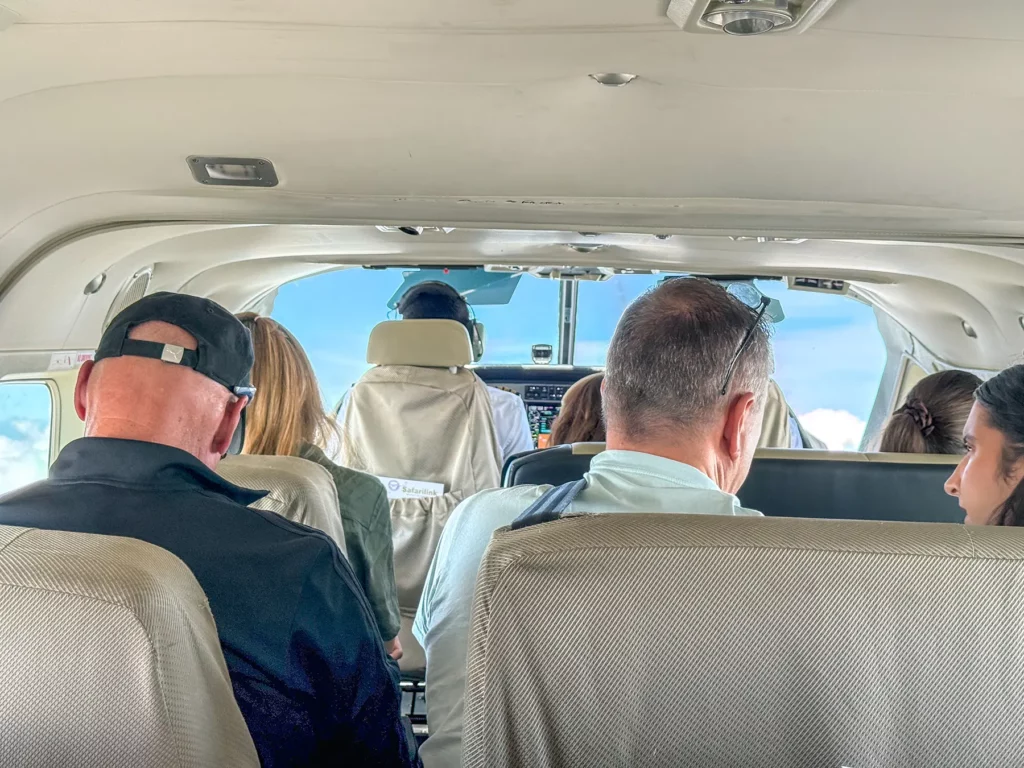
Tarangire & Zanzibar for Safari and Beach
The perfect follow-up to your safari in Tarangire is a few days of chilling at the beach in Zanzibar. Many visitors to Tanzania opt for a safari-beach combination holiday and, honestly, what could be a better combo than that?
After all, you’ll be exhausted after all those early morning safaris, so relaxing beside the Indian Ocean afterwards is the icing on the cake.
Let’s look at the logistics of adding Zanzibar to your Tarangire itinerary below.
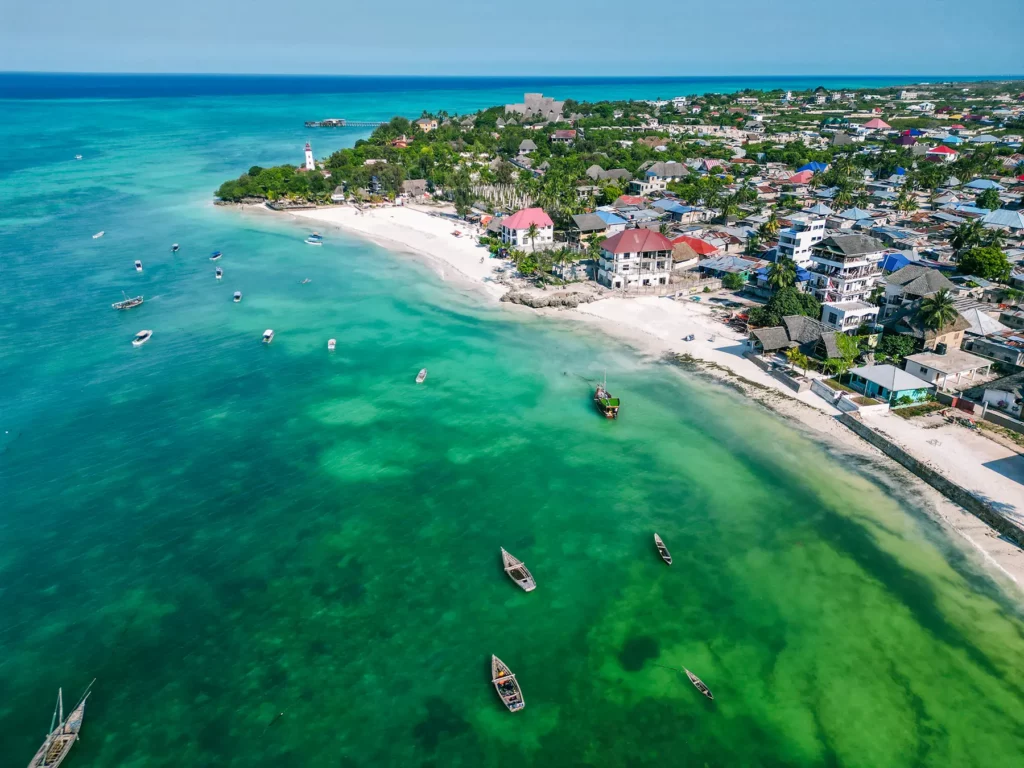
How do I get from Tarangire to Zanzibar?
It’s relatively easy to reach Zanzibar from Tarangire. You’ll just need to fly or drive from the national park back to Arusha, and then fly from either Arusha or Kilimanjaro Airport to Zanzibar.
Precision Air and Air Tanzania fly to Zanzibar from both Arusha and Kilimanjaro Airports. Meanwhile, Coastal Aviation, Air Excel, As Salaam Air, and Regional Air fly from Arusha.
If you want to fly directly, you’d need to ask your safari provider to charter a direct flight but this will be much more expensive vs scheduled flights.
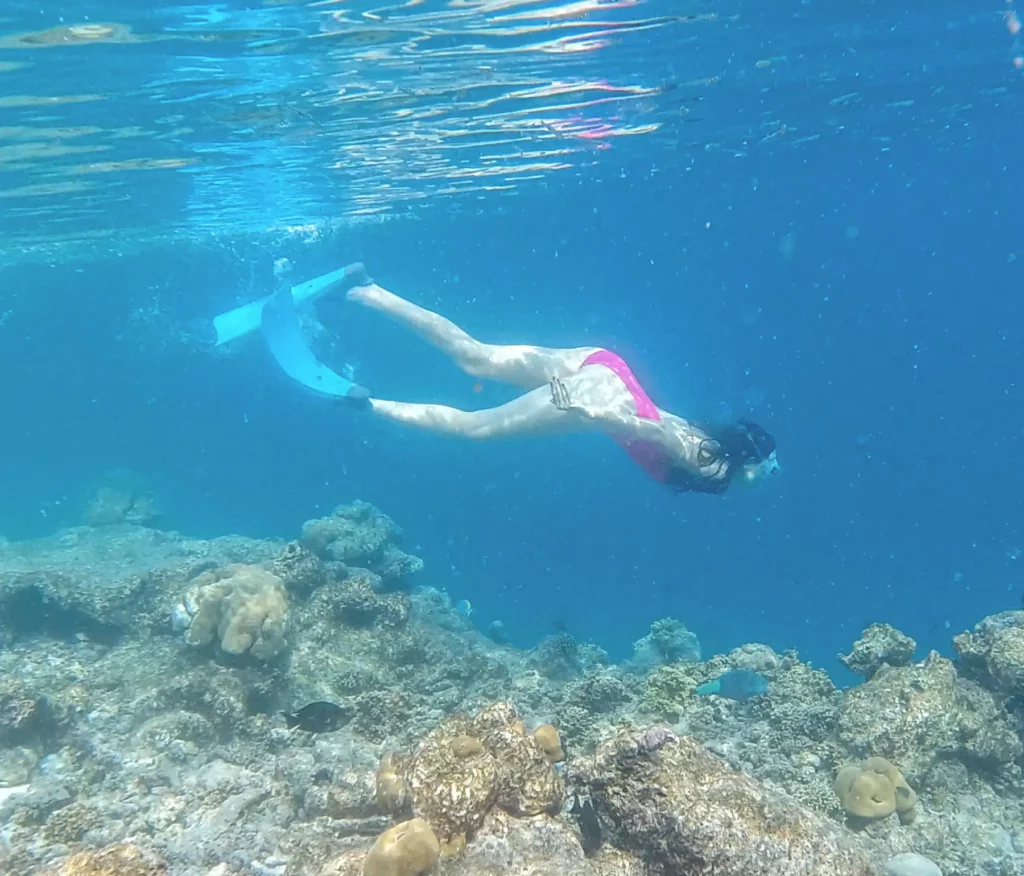
How Long Does It Take To Fly From Tarangire to Zanzibar?
Scheduled flights from airstrips near Tarangire (e.g., Kuro Airstrip) take around 30 minutes to Arusha. You would then need to transfer at Arusha Airport or Kilimanjaro Airport on a second scheduled flight to Zanzibar which takes around 1 hour and 20 minutes. There are no direct scheduled flights between Tarangire and Zanzibar.
You can however fly directly via a chartered flight. Direct charter flights from airstrips near Tarangire (e.g., Kuro Airstrip) to Zanzibar typically take around 1 hour and 30 minutes.
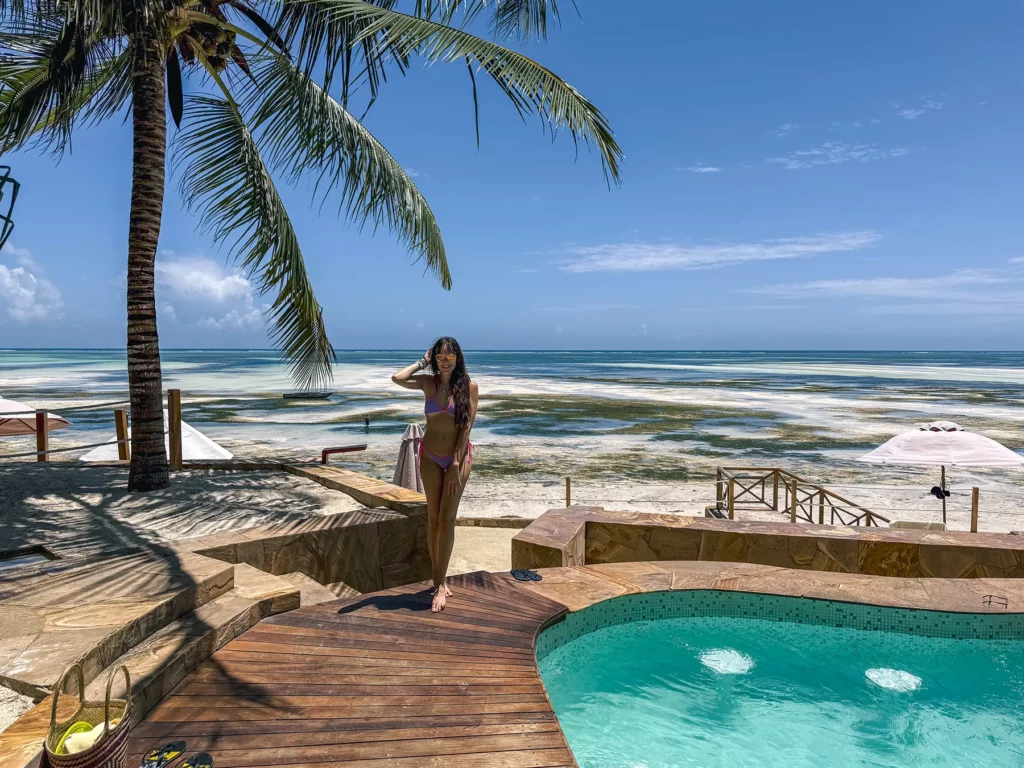
How Many Days Do You Need In Tanzania And Zanzibar?
To include both safari and beach, I advise spending at least 7 days in Tanzania, with 5 days on safari and a minimum of 2 nights in Zanzibar. This includes travelling between destinations, giving you plenty of time to enjoy your safari and soak up the sun on the beach at the end of your visit.
Time and budget permitting you can easily spend 2 – 3 weeks in total with 1 – 2 weeks on safari and 1 week relaxing in Zanzibar.
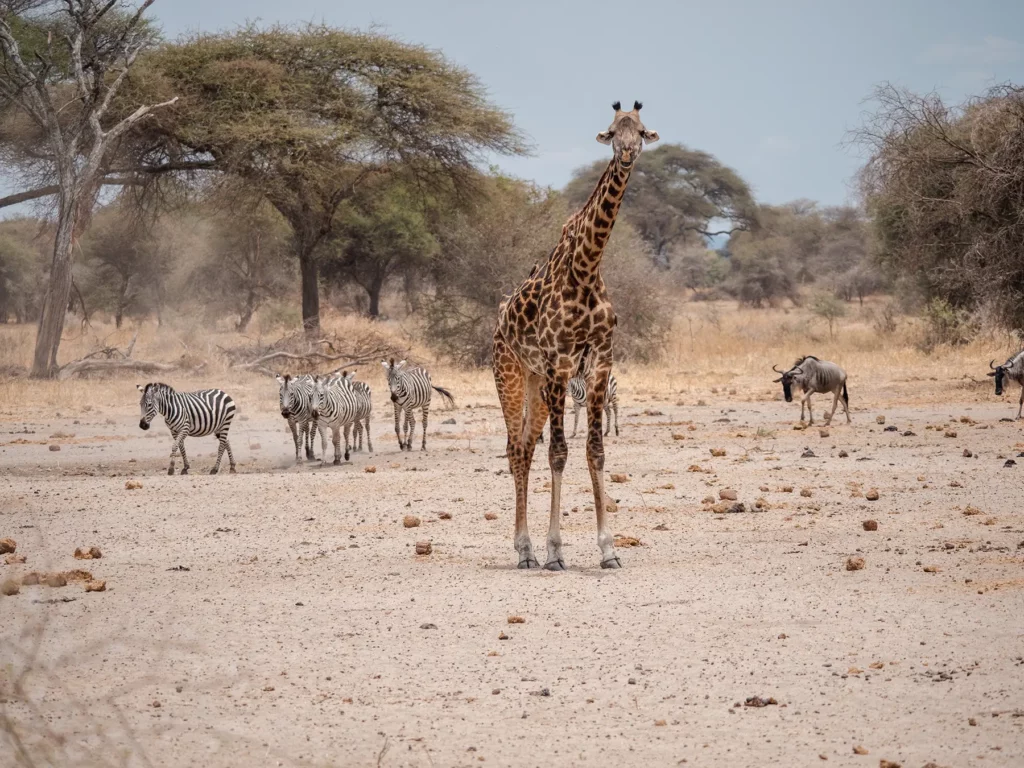
How Does Tarangire Compare With Other Safari Parks?
Tarangire is one of the most varied national parks in terms of landscapes and wildlife, so it’s great for first-timers as well as seasoned safari-goers alike. When it comes to viewing elephants in the wild, it’s hard to beat Tarangire.
What’s the Difference Between Serengeti and Tarangire?
Serengeti National Park is one of the most famed parks in Africa, and for good reason. If you want to witness the Great Migration, then Serengeti is the place to go, as well as the adjoining Masai Mara in Kenya.
The density of big cats is also higher in the Serengeti, although it’s still possible to see lions and leopards on your safari in Tarangire.
While the Serengeti is a lot bigger than Tarangire, both locations offer a diverse safari experience with abundant wildlife and beautiful scenery. The Serengeti is characterised by its vast grassland plains and rocky outcrops, while Tarangire is known for its riverine forests and baobab trees.
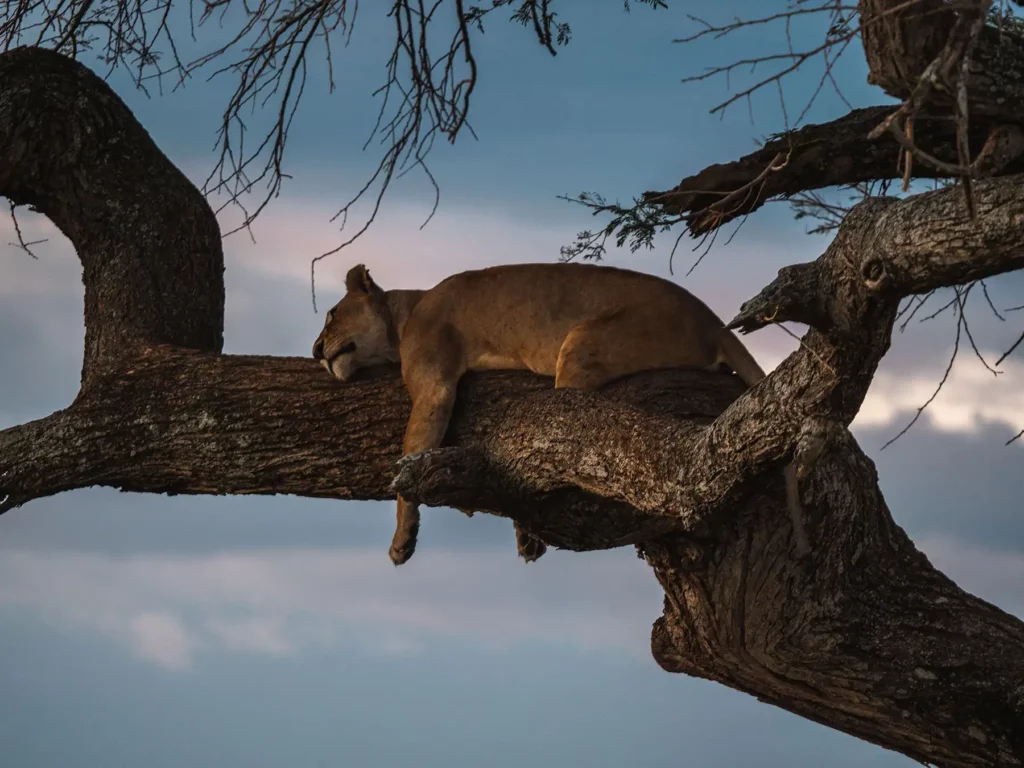
The Serengeti is home to all of the Big Five, but Tarangire only has four. Yet what the latter lacks in rhinos, it makes up for with its enormous herds of elephants.
Both parks have a variety of accommodation options to suit all budgets, but you’ll find much higher prices in the Serengeti during the peak migration season between July and October.
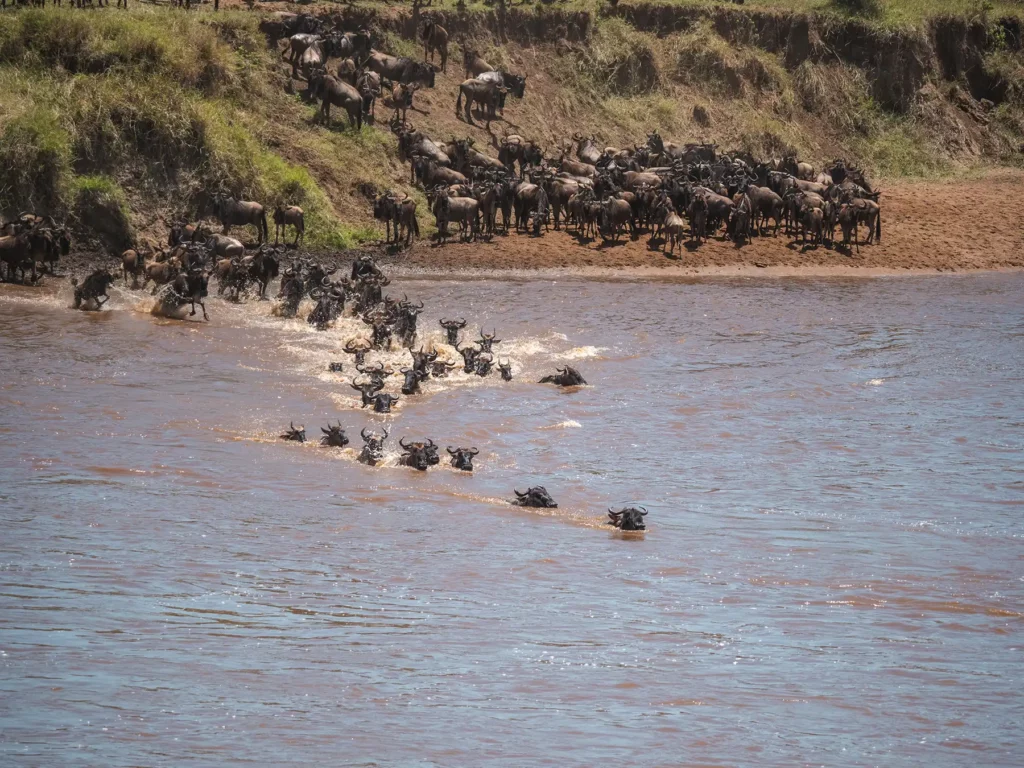
Park fees vary between the two safari destinations, with the Serengeti being more expensive. Daily high season entry to the Serengeti costs $70 per person whereas in Tarangire it’s $50.
If you can only pick one, the Serengeti is the place to go in Tanzania. It was my favourite location in the country.
Read my full guide on Serengeti National Park for more information.
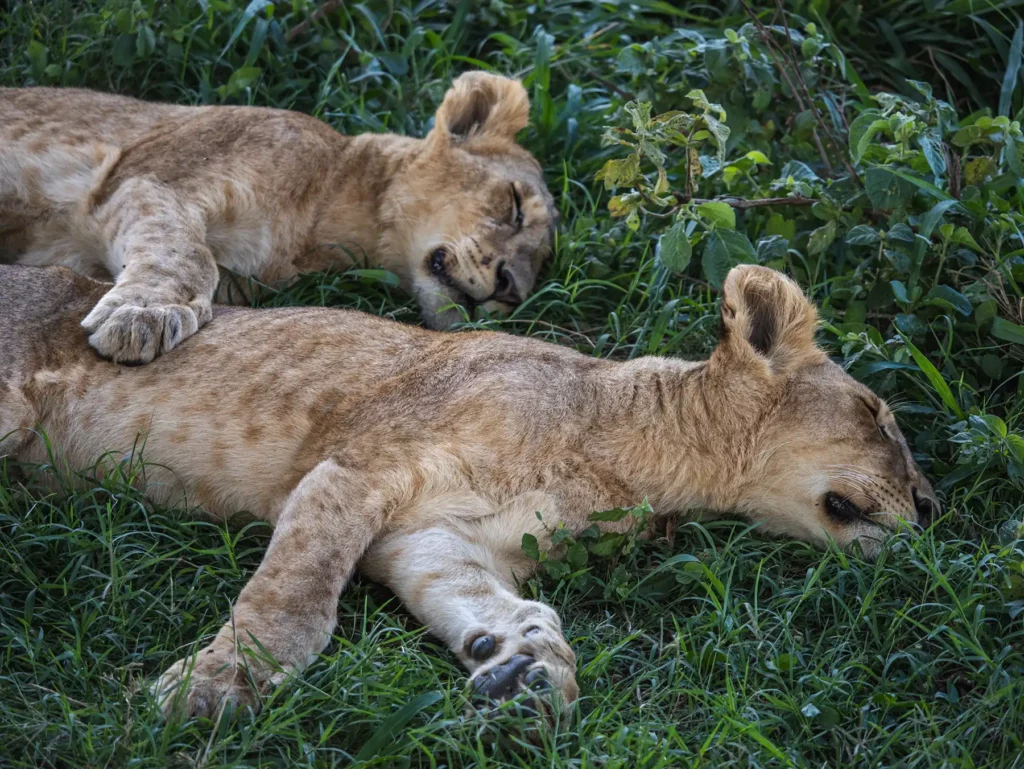
Is Ngorongoro or Tarangire Better?
Tarangire National Park is far larger than the Ngorongoro Crater and has more varied landscapes, which means there’s much more to see and do here. It’s easy to spend several days in Tarangire without retracing your steps, while most people only spend a day in the Ngorongoro Crater.
Ngorongo Crater however, is the most unique of the two locations and reminded me of a lost world as I travelled inside the crater which is a giant caldera formed by a collapsed volcano.
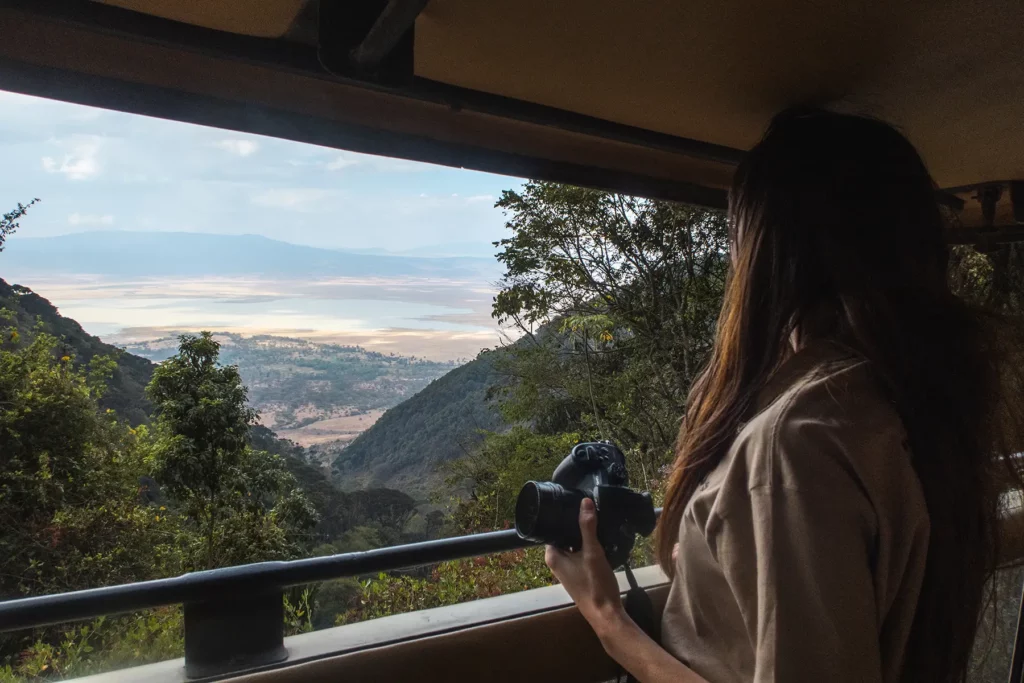
There are over 250,000 animals in Tarangire during the dry season, which surpasses the numbers in Ngorongoro. However, the appeal of a Ngorongoro Crater safari is the animal density, partially lions. Ngorongoro boasts 15 or more lions per 100 km² compared to 7.5 in Tanragirie.
The crater is the best year-round destination as most of the animals don’t migrate.
Ngorongoro is a great place to tick off all of the Big Five, while Tarangire has lions, elephants, buffalos, and leopards but no rhinos.
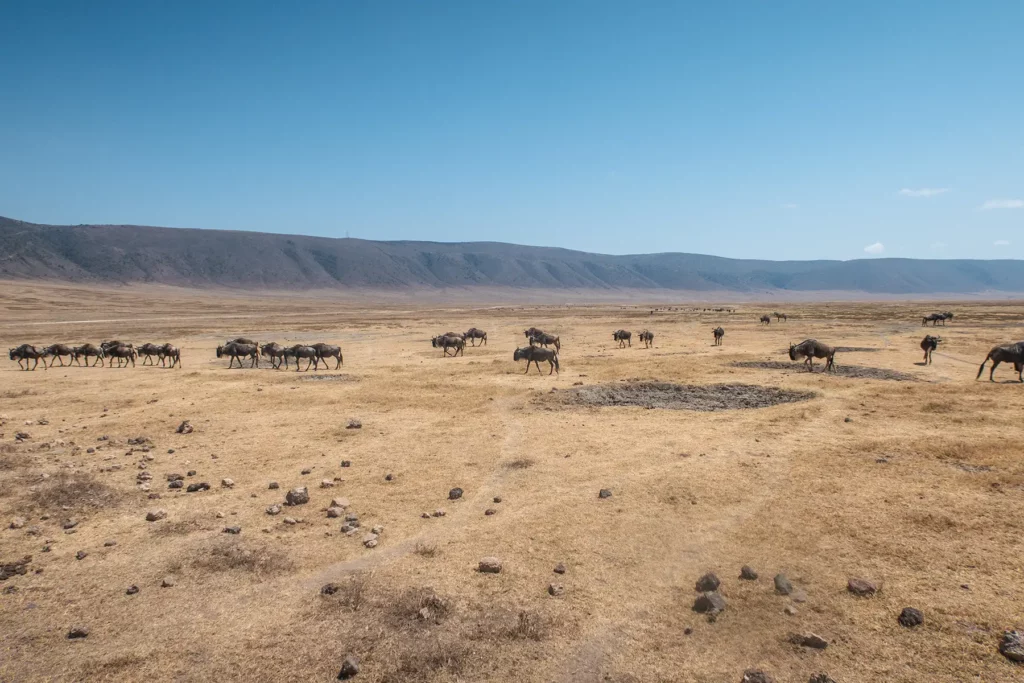
Park fees in Tarangire are only $50 per person per day, while the Ngorongoro entry fee is one of the highest in Africa at $70.80, plus $295 per vehicle to enter the crater.
Lodging around Ngorongoro tends to be more expensive, too, as this is one of the most popular safari destinations in Africa. Accommodation on the rim is often at a premium, but most people only stay a couple of nights. There’s a wider selection of hotels, camps, and lodges at Tarangire, with a varied price range to match.
These two parks both offer world-class safari experiences. If you want high animal densities, rhinos, and a unique and magical destination, then go to Ngorongoro. Or if you want to spend several days immersed in the wilderness searching for tree-climbing lions and baobab trees, then book a trip to Tarangire.
But if you can only pick one? This is a tough one, but my vote goes to Ngorongoro. Both parks are fairly close and on the Northern Circuit, so if at all possible, I recommend visiting both.
Read my full guide on Ngorongoro Crater for more information.
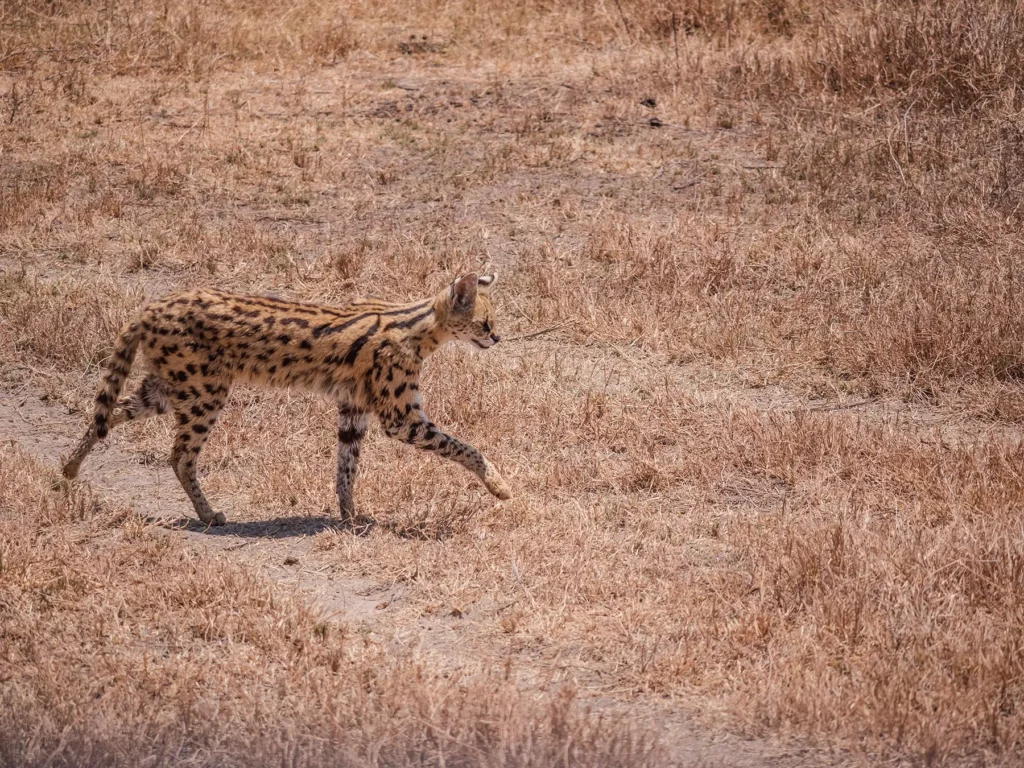
Is Lake Manyara National Park or Tarangire Better?
When it comes to size, Tarangire wins this comparison, hands down. Lake Manyara National Park is much smaller at just 250 square miles. Yet both places offer varied landscapes and abundant wildlife. Four of the big five (besides rhinos) are regularly spotted in each.
Animal numbers are greater in Tarangire as habitats are more diverse. That said, big cat densities are still high in Lake Manyara, with most visitors seeing lions during their safaris here. You can find the famous tree-climbing lions in both Tarangire and Lake Manyara.
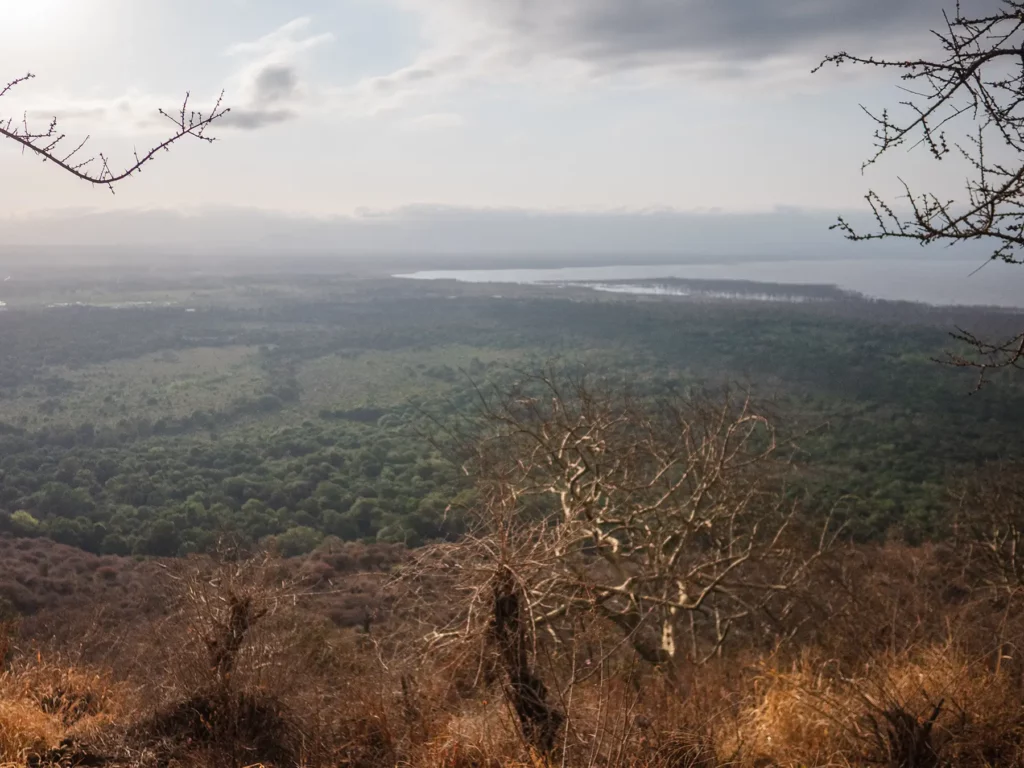
Park fees are the same for Tarangire and Lake Manyara, at $50 per person per day. These are among the cheapest parks to visit in Tanzania in terms of entry costs. Accommodation prices are similar for both parks, with budget and premium lodging available.
Lake Manyara has suffered in recent years from climate change, causing the lake to eat up some of the park. As a result, many species have moved away from the park, including large numbers of elephants and rhinos. The flamingos as well have started to vacate the park with less algae for them to eat now that the water is being contaminated as a result of flooding. For this reason I’d choose Tarangire over Lake Manyara if I had to choose just one.
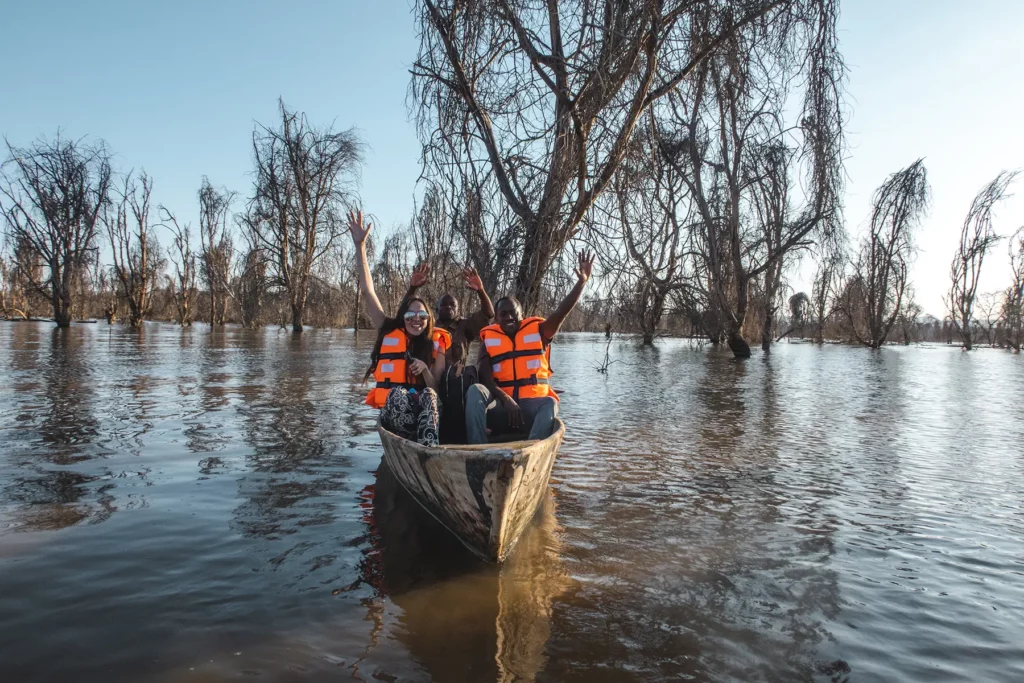
Is Arusha National Park or Tarangire Better?
Arusha National Park is another small park, at just 343 square miles.
Tarangire has more diversity of wildlife but in terms of the landscapes both Arusha and Tarangire are similarly diverse. Arusha National Park encompasses Mount Meru, a popular hiking route, which stands tall in the middle of the park, making for truly stunning volcanic scenery.
Arusha National Park is home to the world’s densest population of giraffes and is famous for it’s black-and-white colobus monkeys, and blue monkeys.
You can see four of the Big Five in Tarangire (besides rhinos) but only three in The Big Five Arusha – elephants, buffalos, and leopards. But this has its benefits; the lack of lions in Arusha makes it one of the best places for walking safaris.
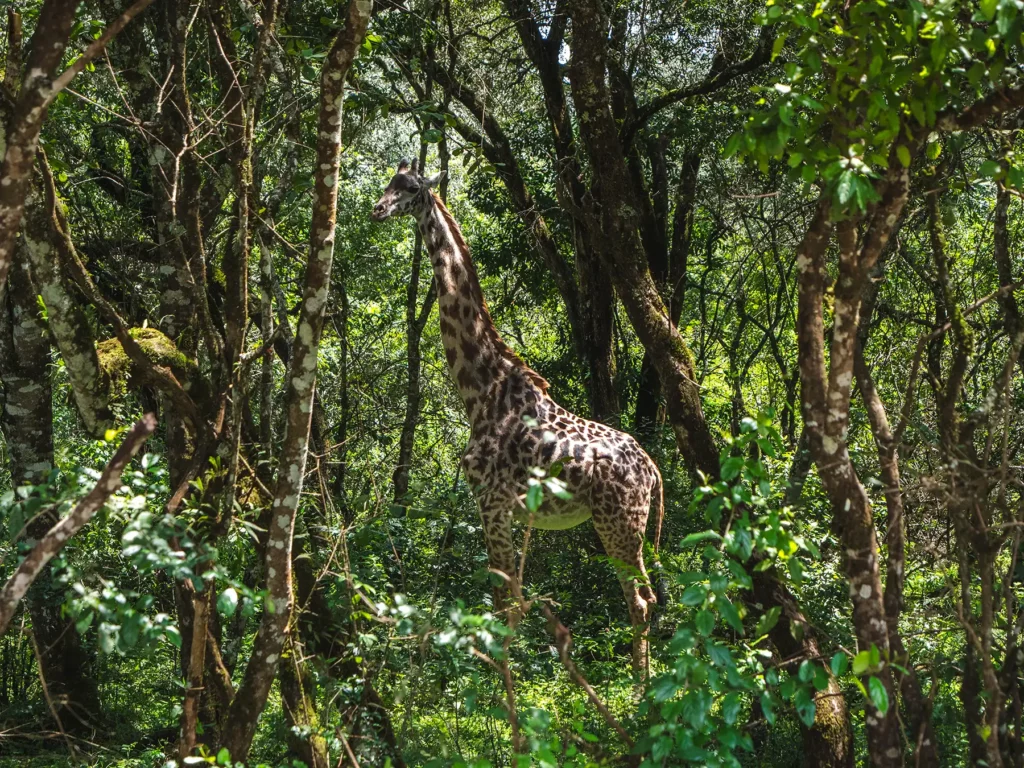
Both parks allow walking safaris but only Tarangire allows night game drives, subject to staying a lodge which facilitates this.
In terms of costs, both parks cost $50 to enter. However, when visiting Arusha National Park, you can stay the night in the city to keep costs down too. Whilst it’s also possible to enjoy safari day trips to Tarangire if you want to make use of budget accommodation in Arusha, for the full experience, I always recommend staying in a safari lodge or camp near or within the park if you’re able to.
On balance I would choose Tarangire as the winner for its wildlife diversity, elephant herds and size. However, Arusha National Park is definitely worth a visit too if you have a spare day in Arusha.
Read my full guide on Arusha National Park for more information.
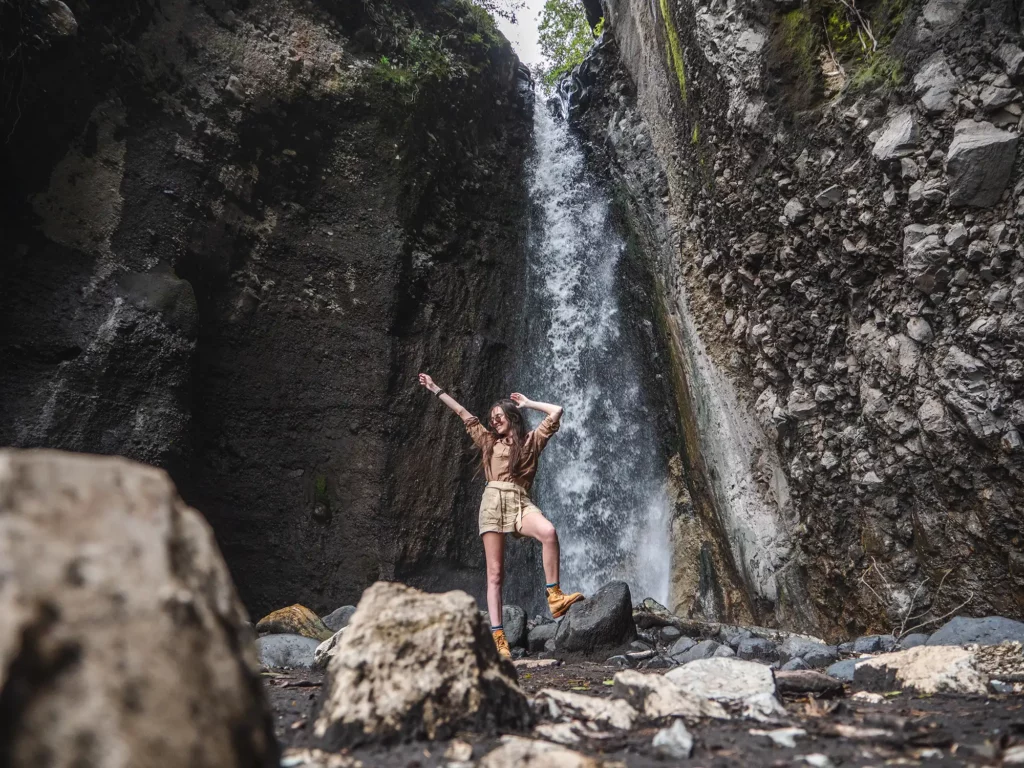
Best Tarangire Safari Itineraries
The best Tarangire National Park itineraries include the other main Tanzania Northern Circuit reserves, such as the world-class Serengeti and magical Ngorongoro Crater. You can view my recommended 3-5 day itineraries below.
3-Day Tanzania itineraries including Tarangire
5-Day Tanzania itineraries including Tarangire
For longer itineraries of 7 to 10 days. You can also include Lake Manara and Lake Natron and finish the safari in Zanzibar, for some relaxation. You can view my recommended 7-10 day itineraries below.
7-10-Day Tanzania itineraries including Tarangire
2-Week Tanzania itineraries including Tarangire
For itineraries of more than 14 days, you can incorporate Kenya into your itinerary as well, visiting the incredible Masai Mara and Amboseli, home of the big tuskers. You can view my recommended 14 day + Tanzania and Kenya day itineraries below.
2-Week Tanzania & Kenya itineraries including Tarangire.
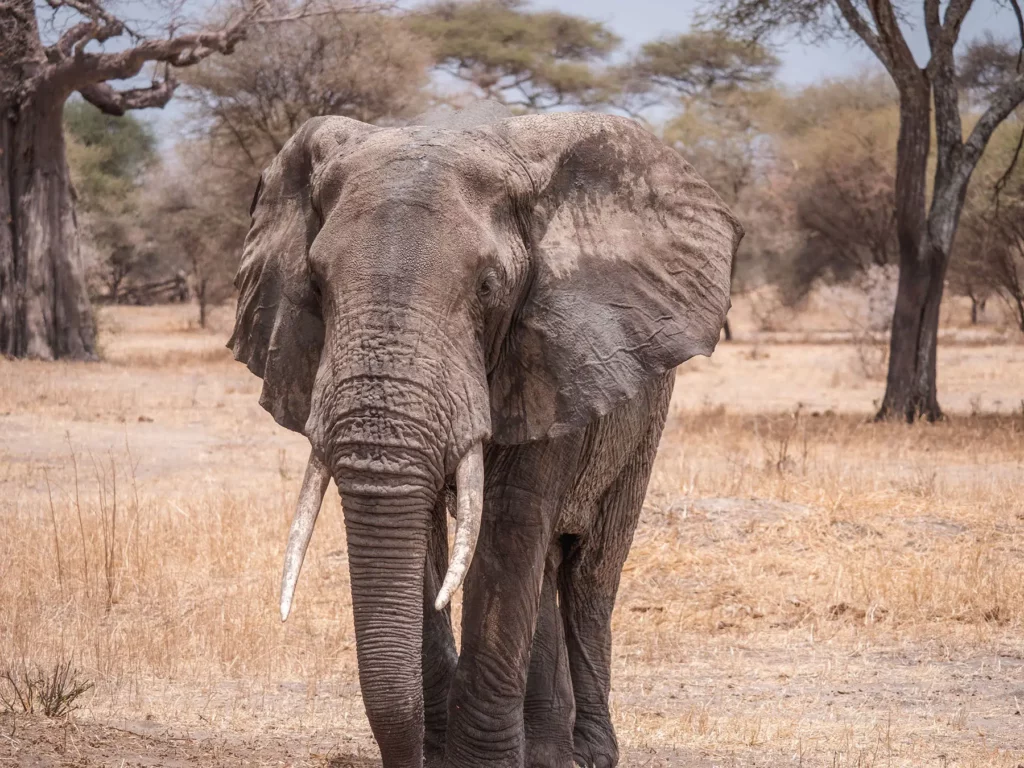
5 Little Known Facts About Tarangire
- Tarangire is one of the few places in Tanzania where you can spot rare animals like the fringed-eared oryx and the long-necked gerenuk, which are not commonly seen in other parks.
- In the local Mbugwe language, “Tarangire” is believed to mean “river of warthogs” or a reference to water.
- There are thousands of baobab trees in Tarangire, some of which are over 1,000 years old.
- The park’s landscape is shaped by underground water streams that sustain the Tarangire River. These underground water sources help feed the river and sustain life in the long dry season when other water sources dry up.
- You can see tree-climbing lions in Tarangire – look for them in the sausage trees. Lions are one of the most regularly seen animals in the park, but seeing them up a tree is something else!
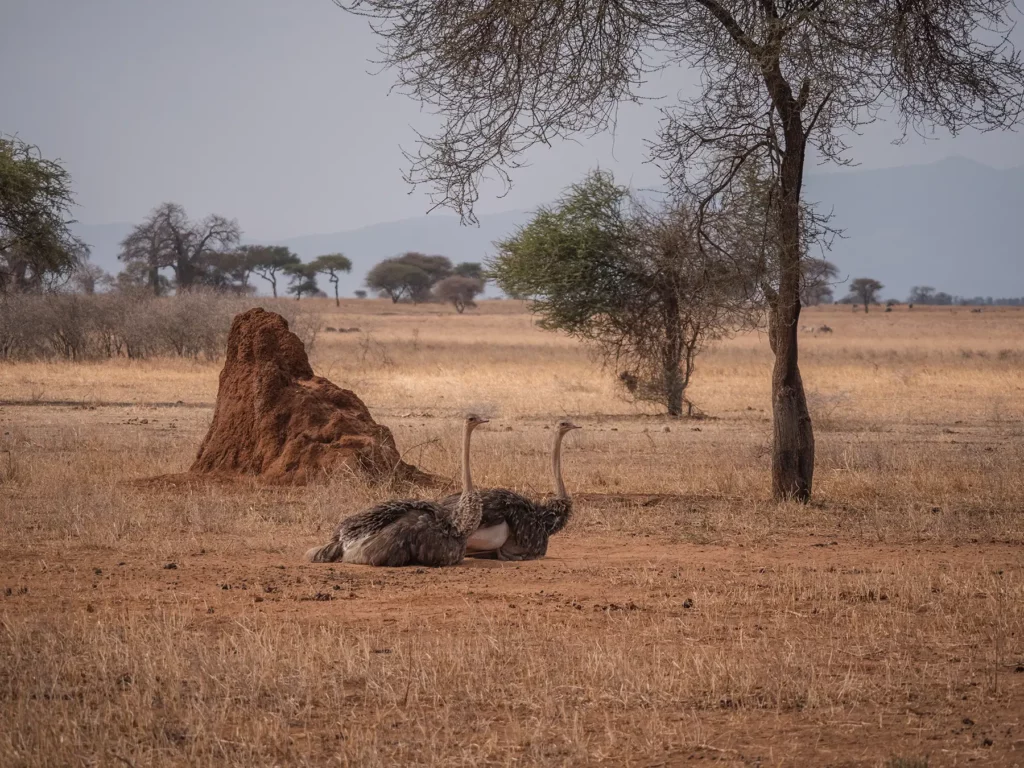
Tarangire Safari Videos
Read More Tanzania Guides
For an overview of planning your safari, you can read my Ultimate Tanzania Safari Guide.
Tanzania Itineraries
Recomended itineraries and how to book them.
7-10 Day Tanzania Safari Itinerary & Costs
5-Day Tanzania Safari Itineraries & Costs (6 unique Itineraries)
3-Day Tanzania Safari Itinerary & Costs
2-Week Tanzania & Zanzibar Safari Itinerary & Costs
3-Week Tanzania Safari Itinerary & Costs
10-Day Tanzania Honeymoon Itinerary & Costs
Tanzania and Kenya Itineraries
Multi-country itineraries and how to book them.
10-Day Kenya and Tanzania Safari Itinerary
2-Week Kenya & Tanzania Safari Itinerary
Costs & Planning
How to get the most bang for your buck and the best time of year to visit depending on what you want to do and see.
Tanzania Safari Cost – Everything You Need to Know!
The Great Wildebeest Migration Guide
Zanzibar Island – The Complete Guide
National Parks & Reserves
Complete guides to the best and most famous safari reserves, including the wildlife you’ll see, entrance costs and best time to visit.
Other Popular Safari Destinations
How to Book Your Safari
Save time and ensure an incredible safari experience by getting quotes from my recommended local safari companies.
Join the rapidly growing tribe of over 1,000 travellers who’ve booked their dream safari using my insider tips and recommendations.

